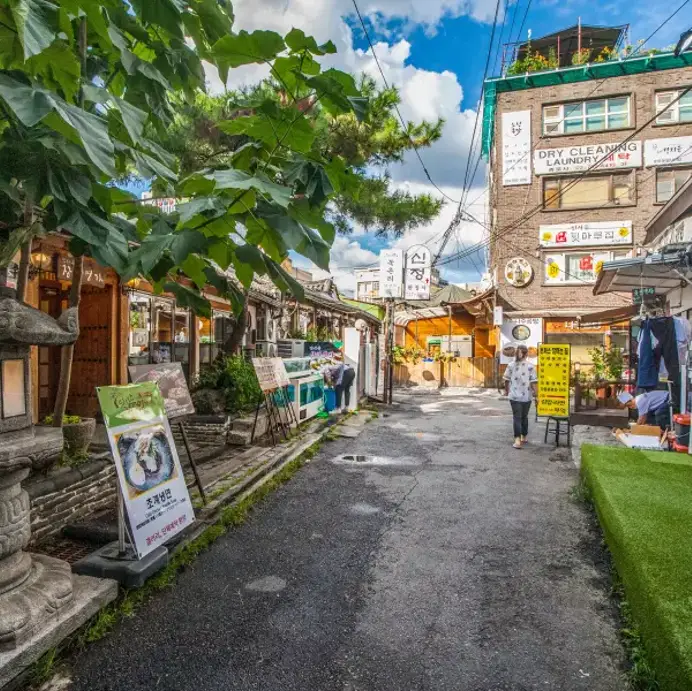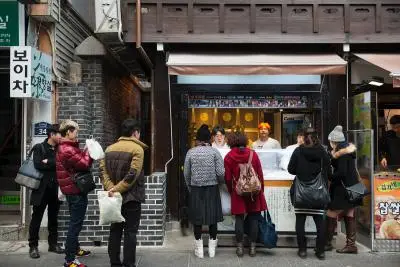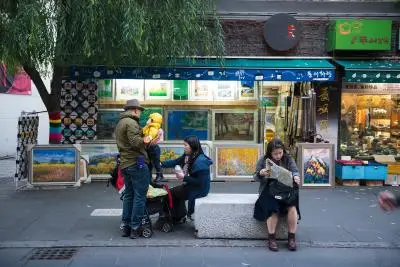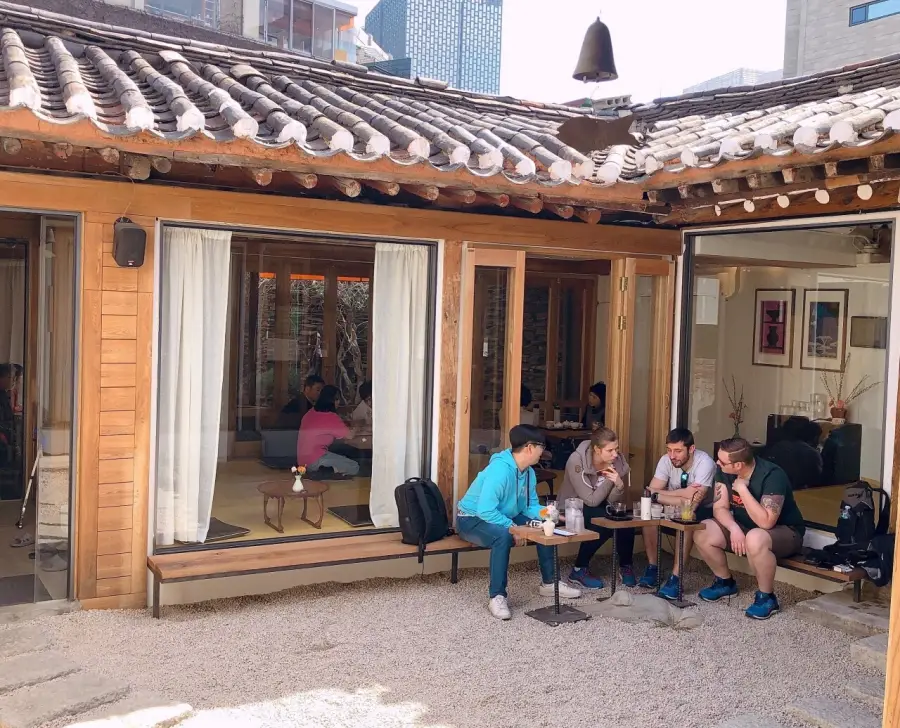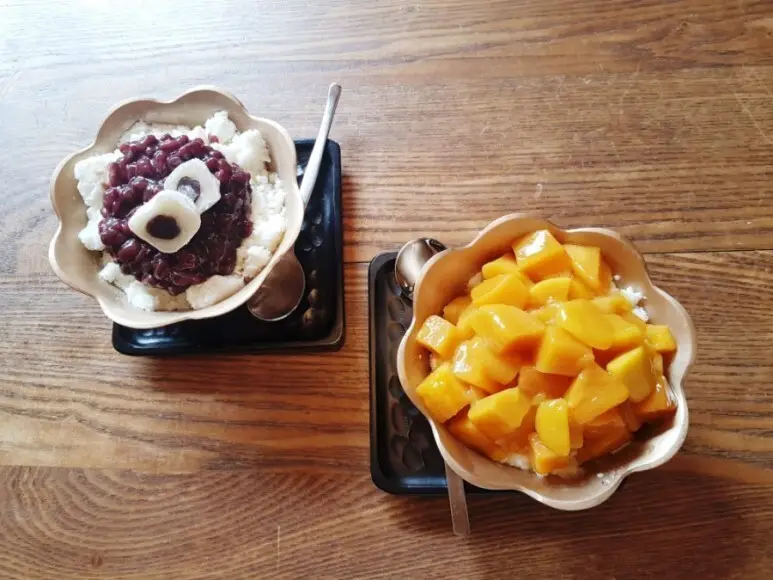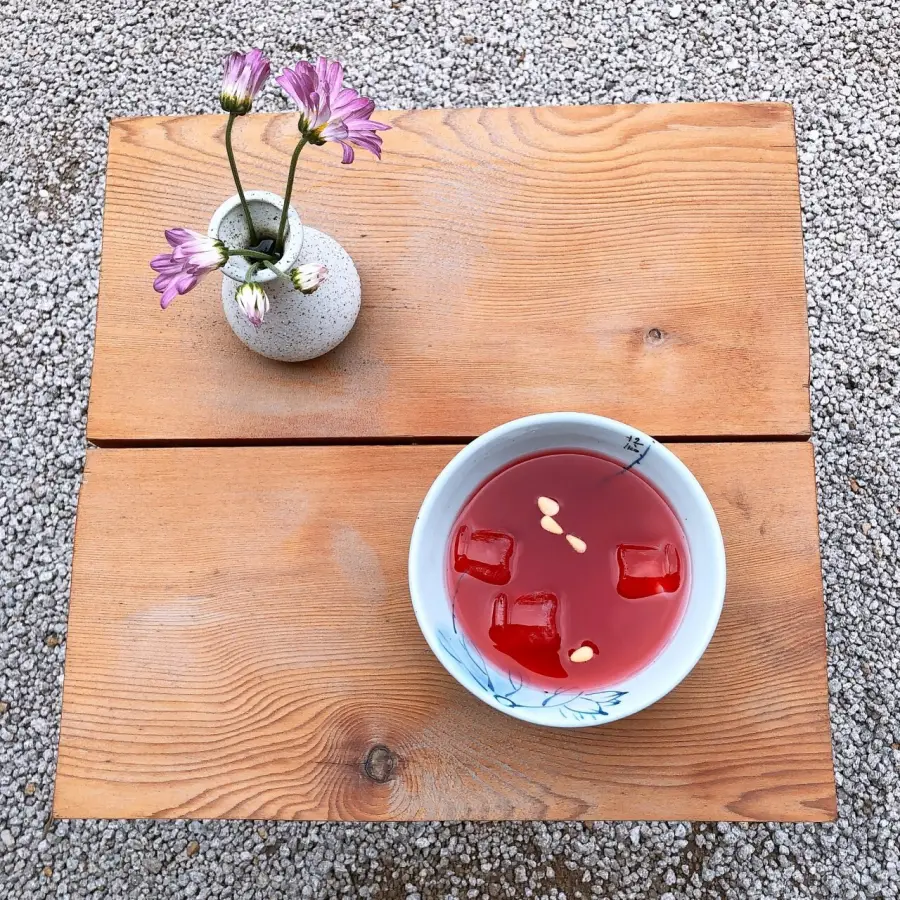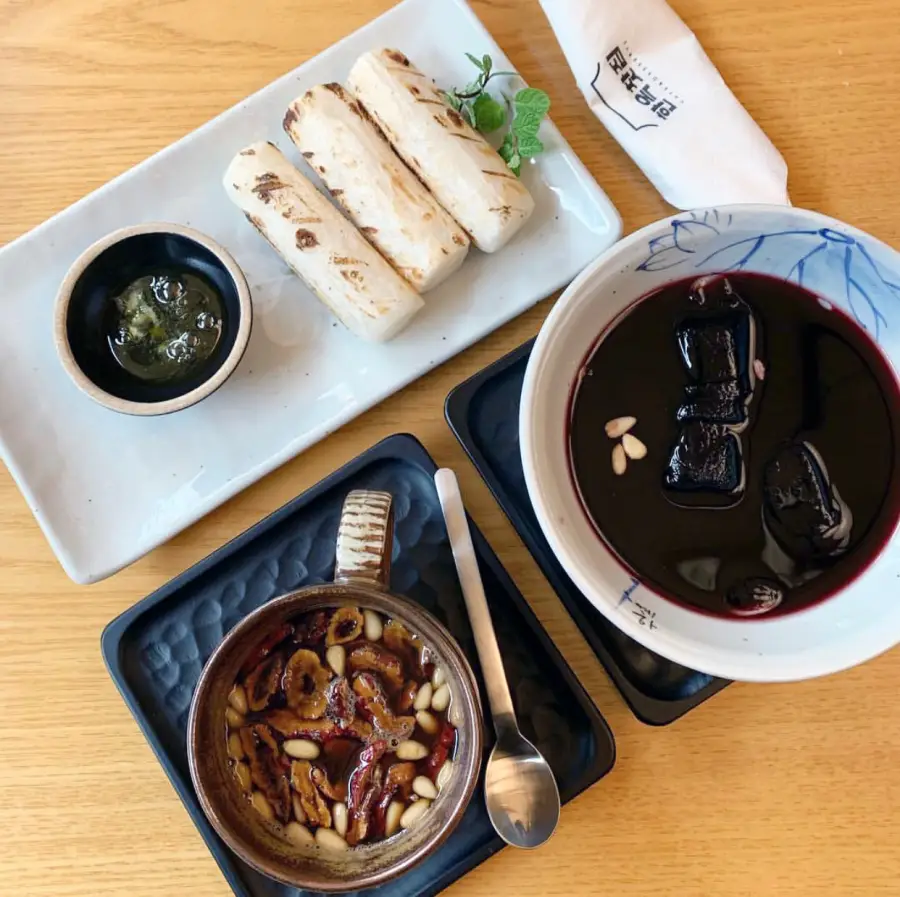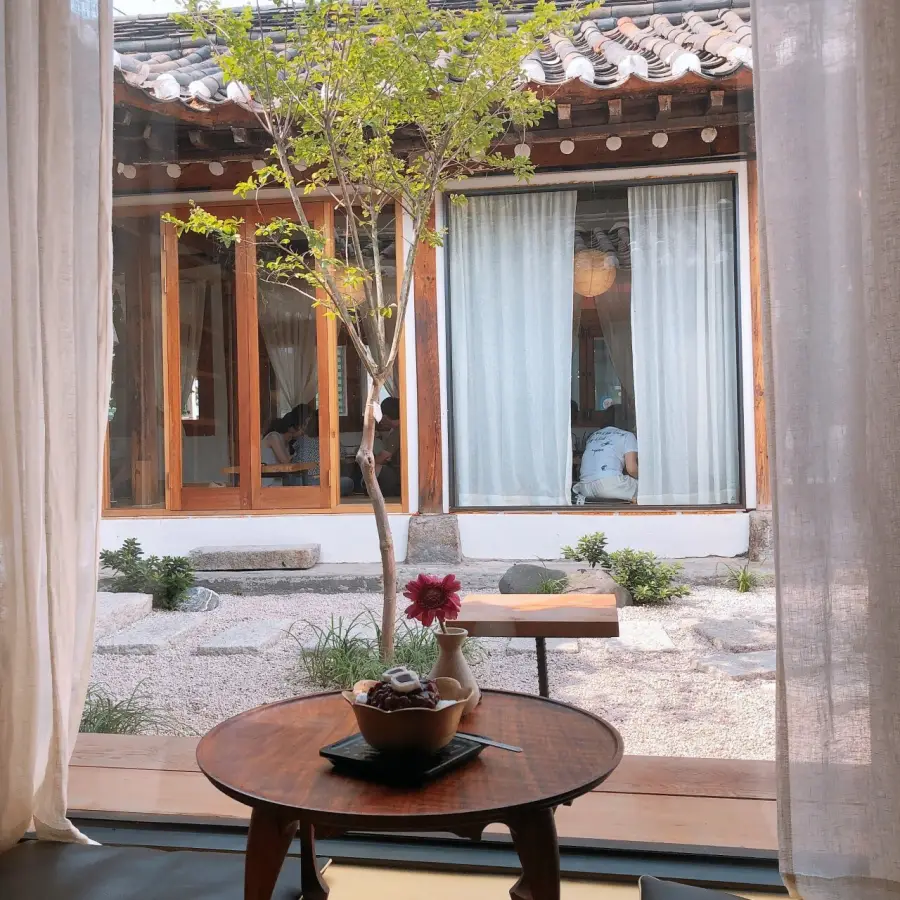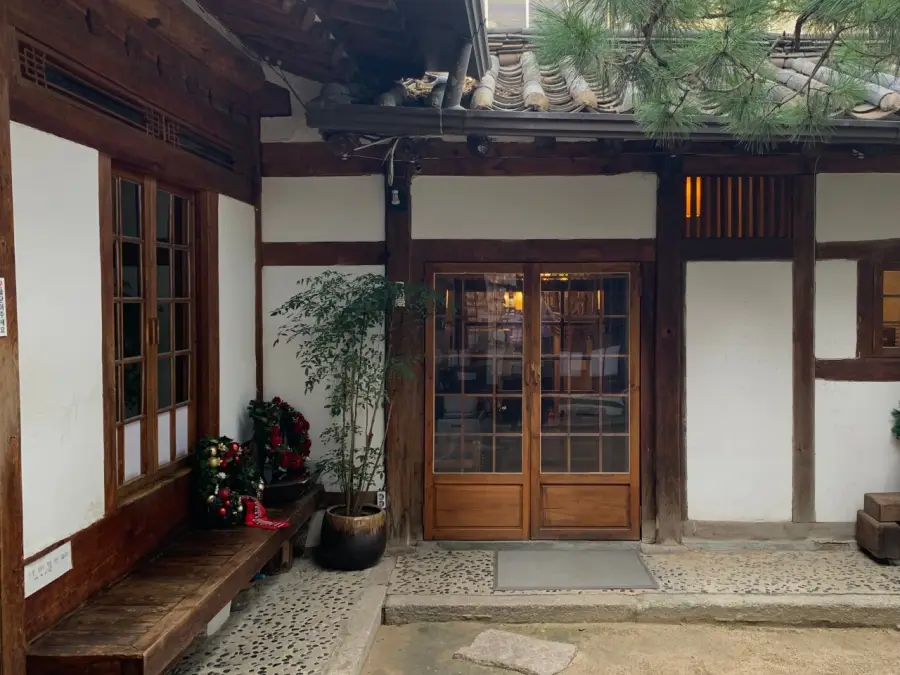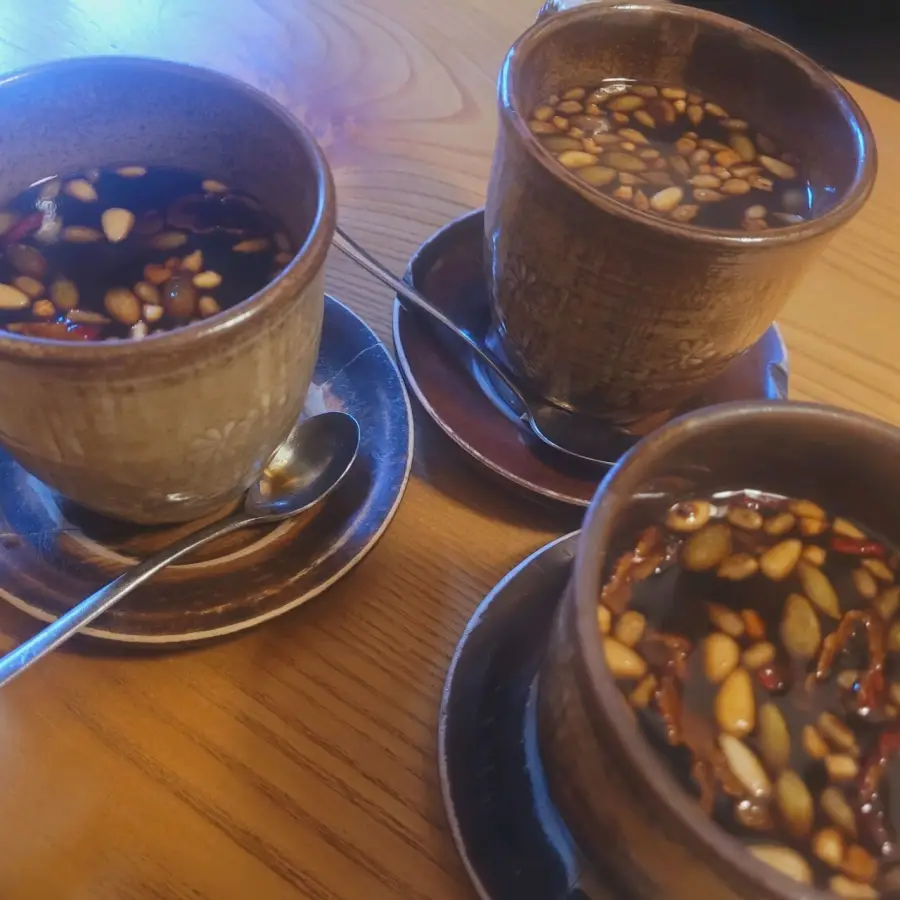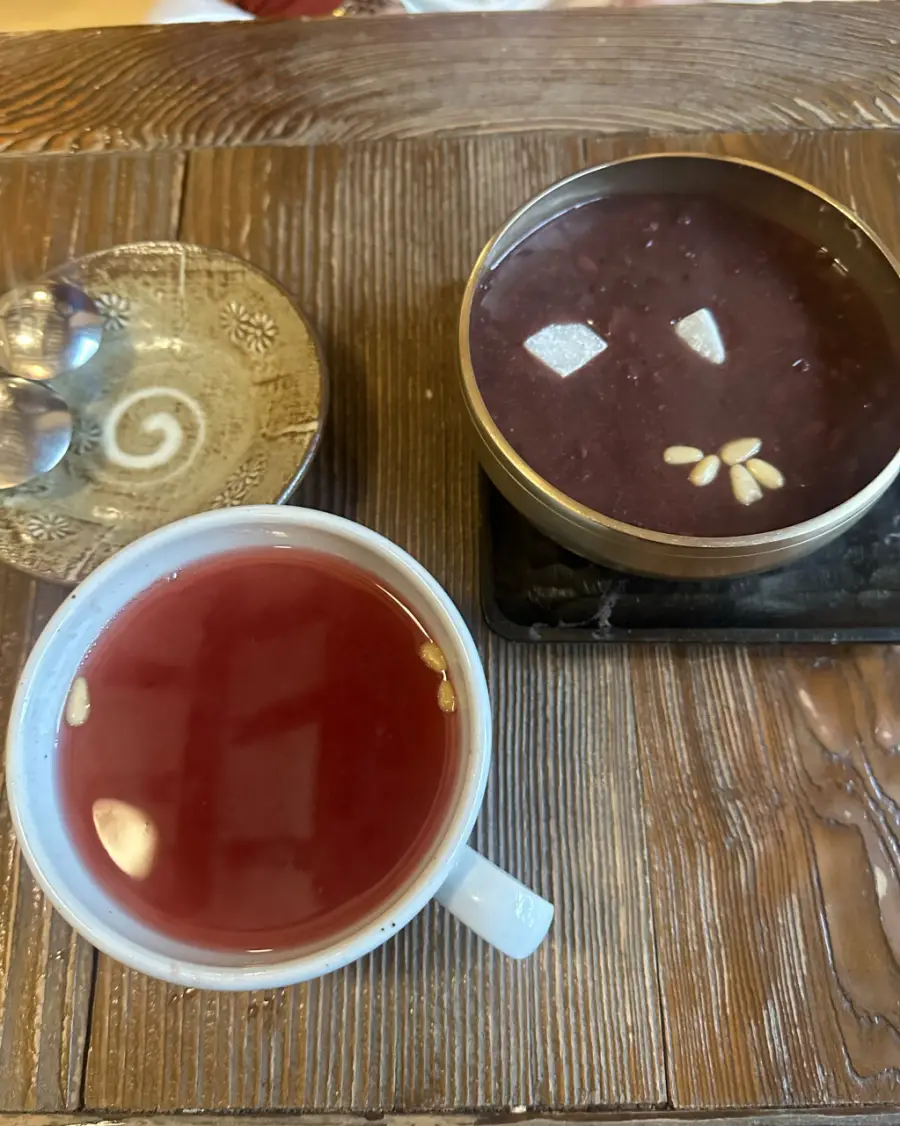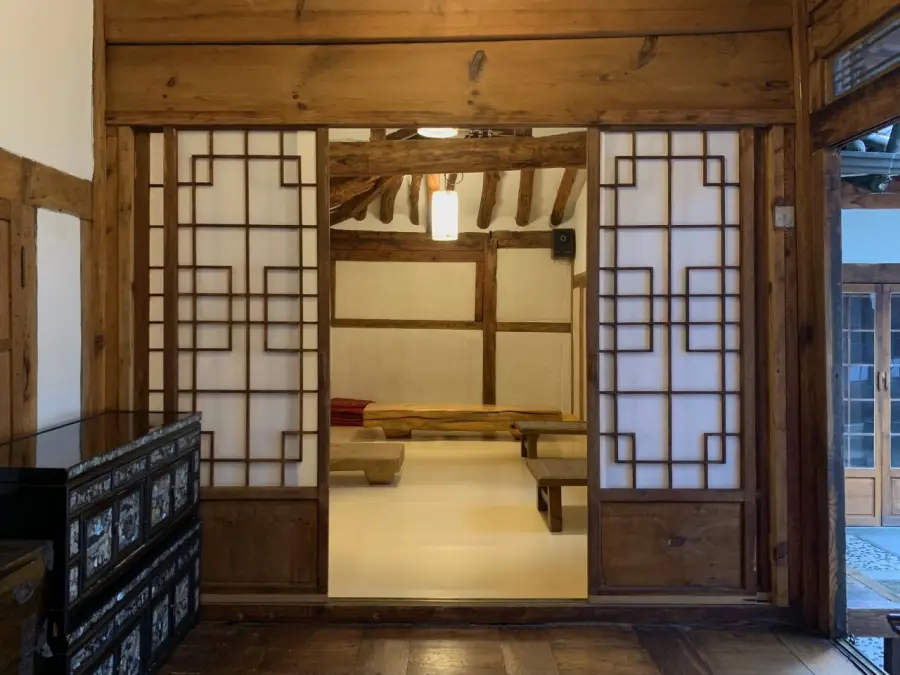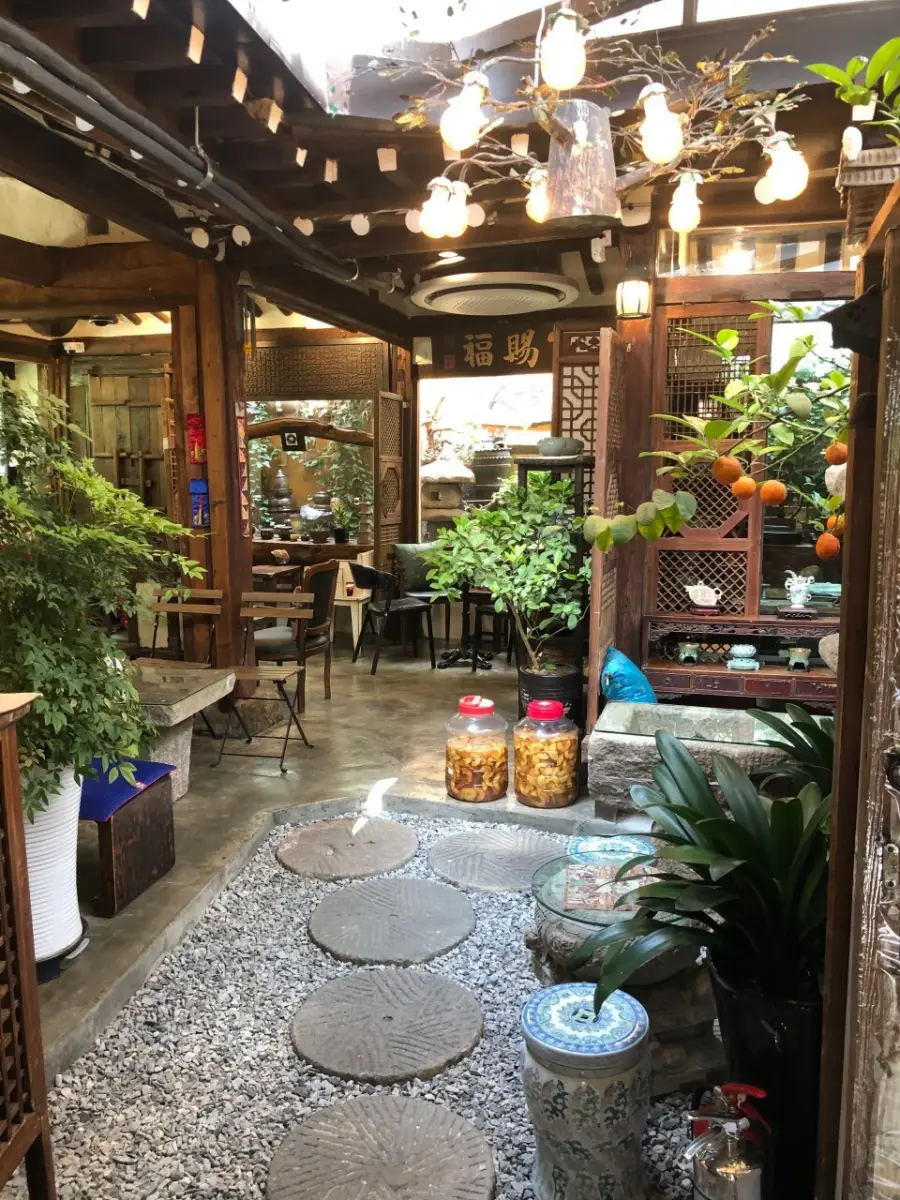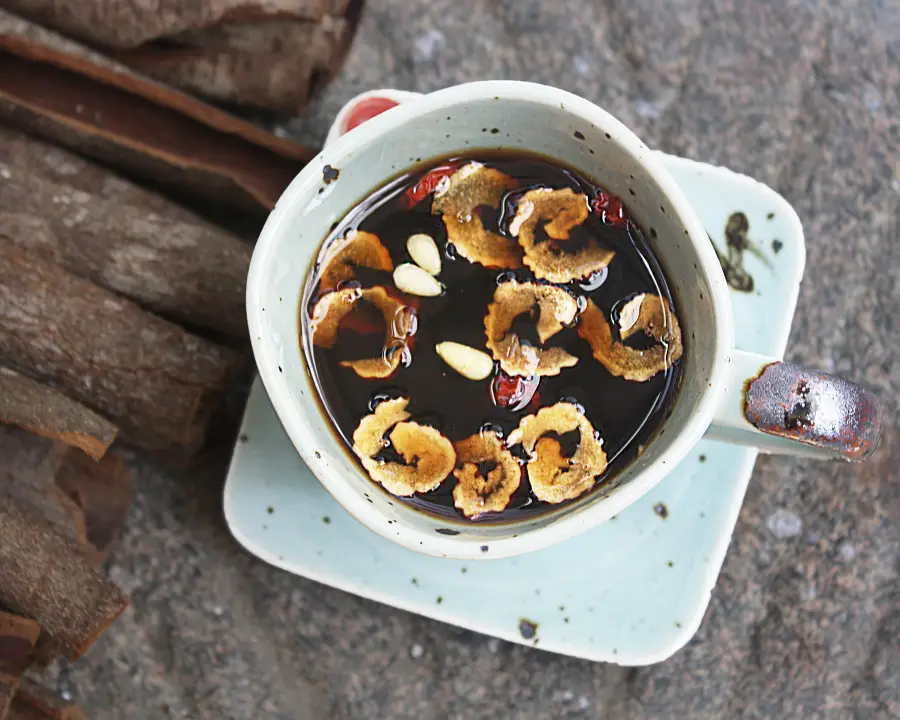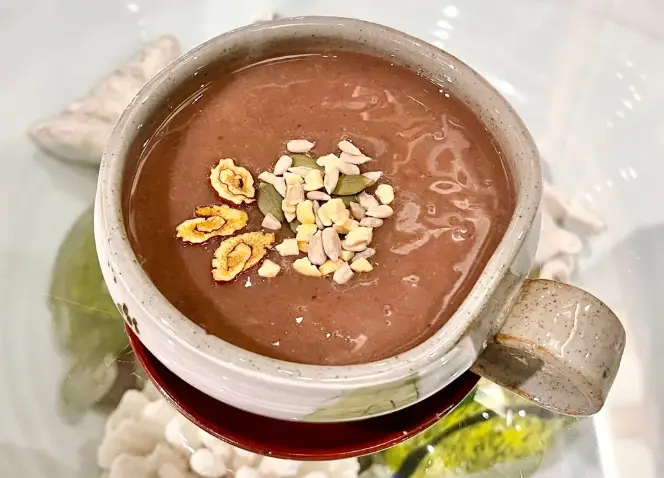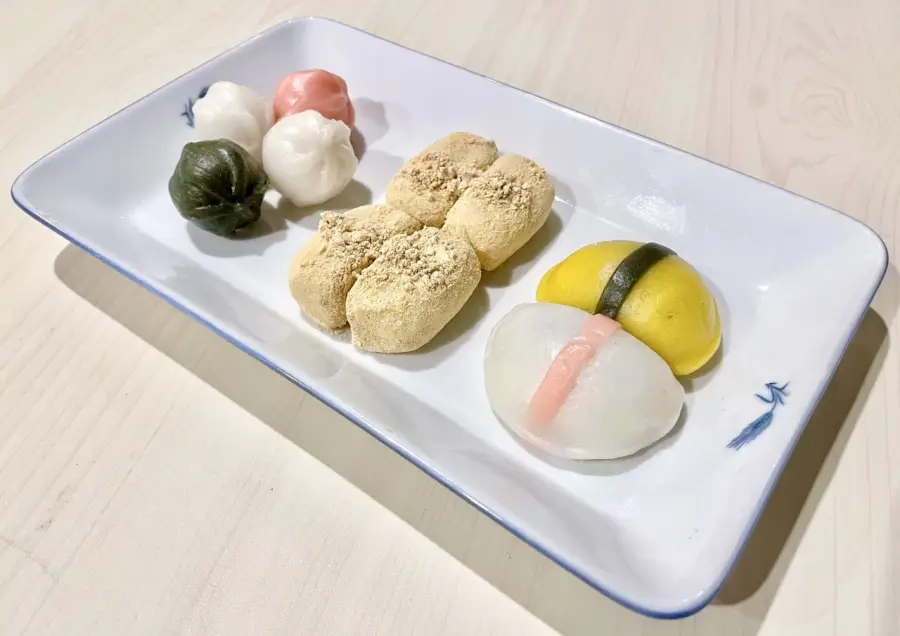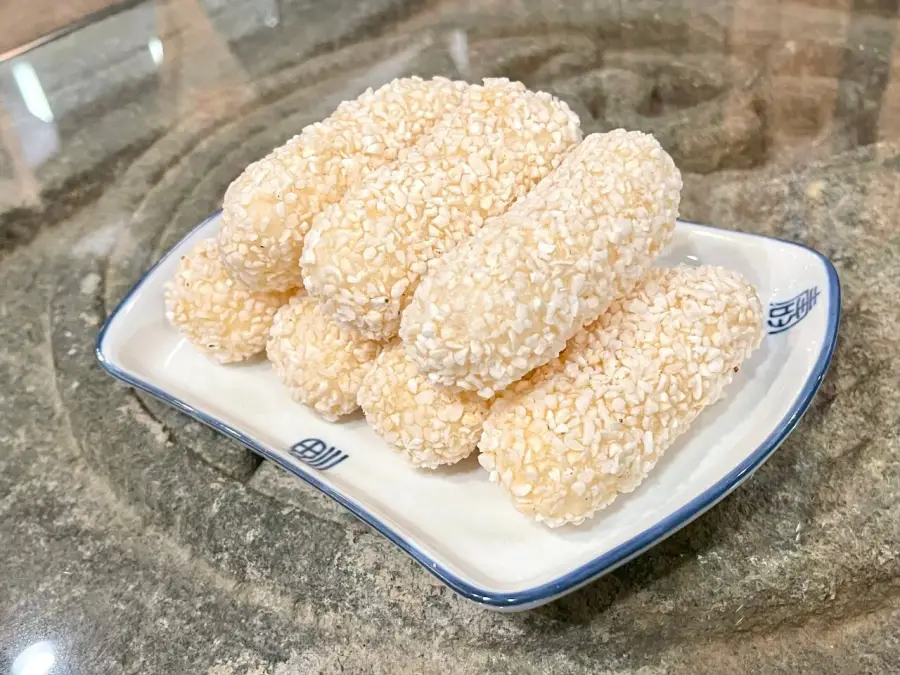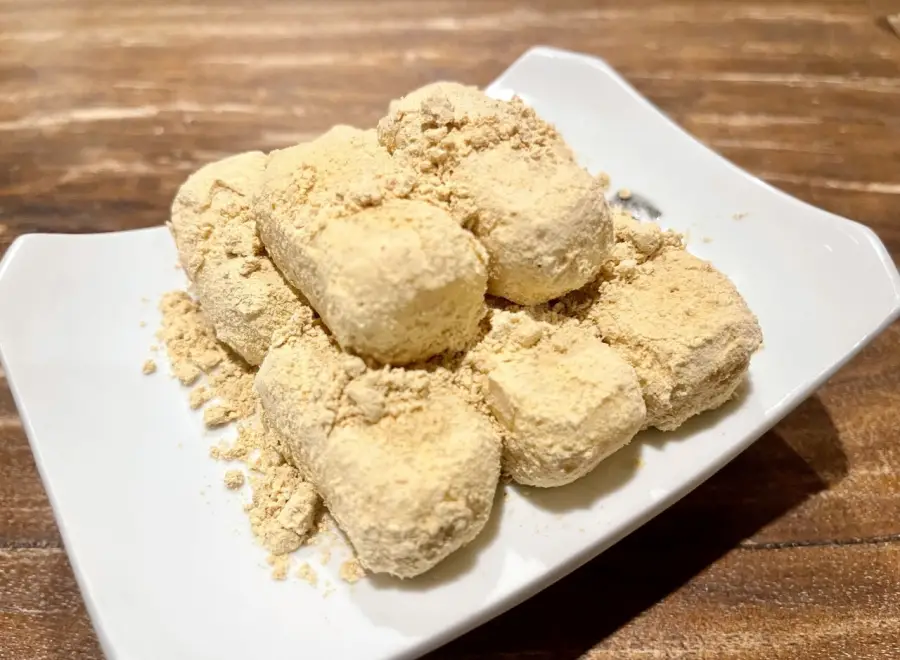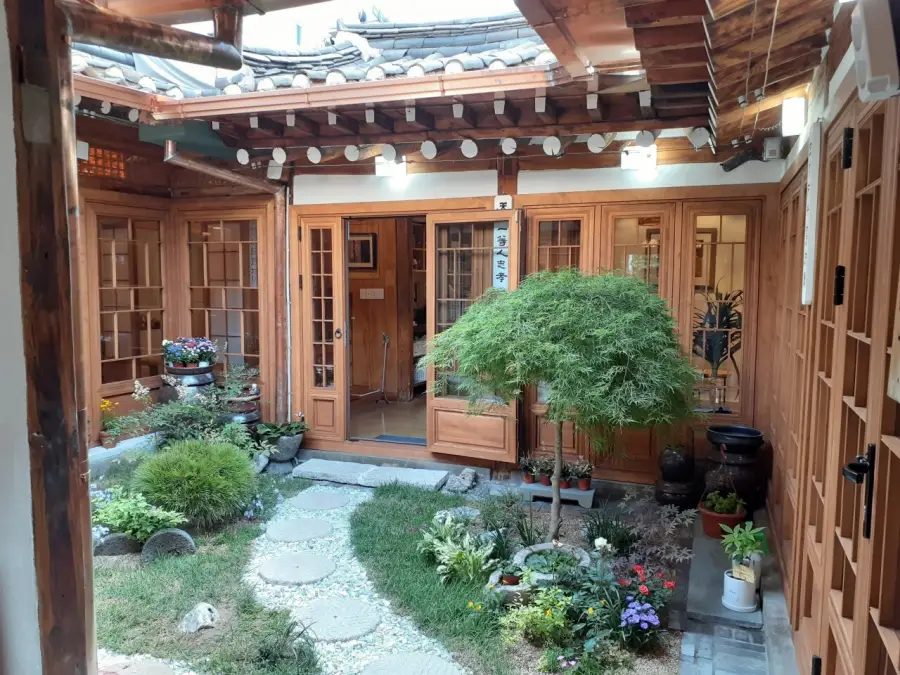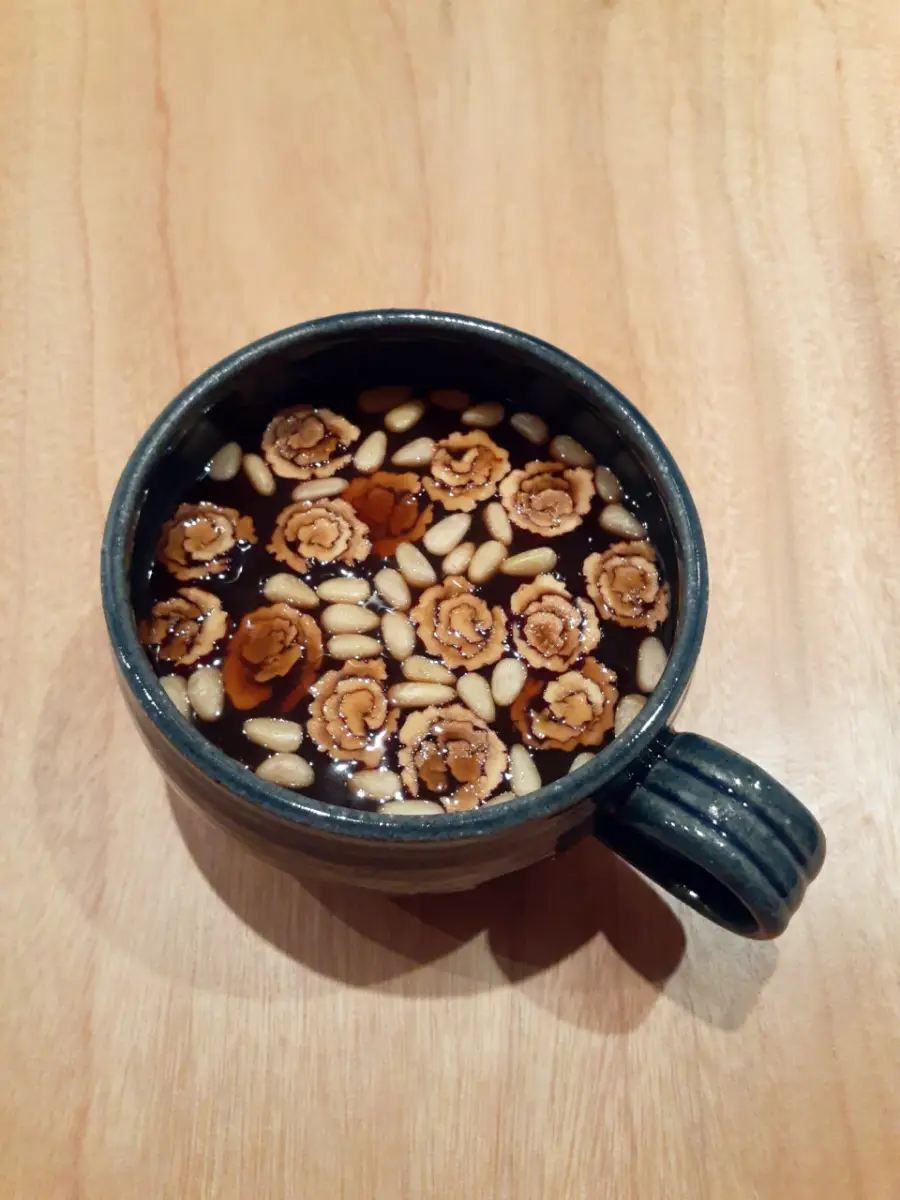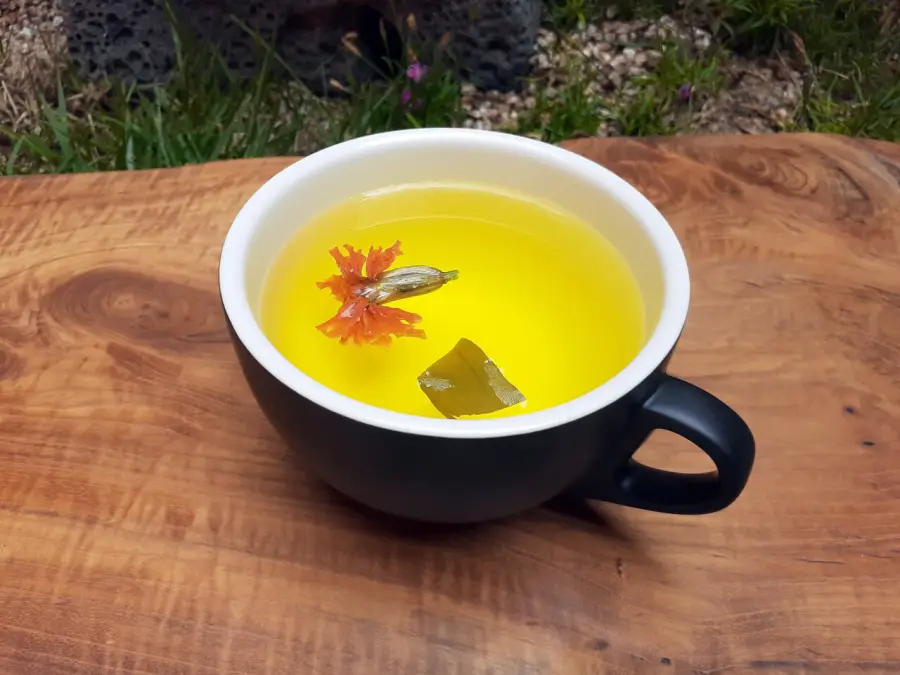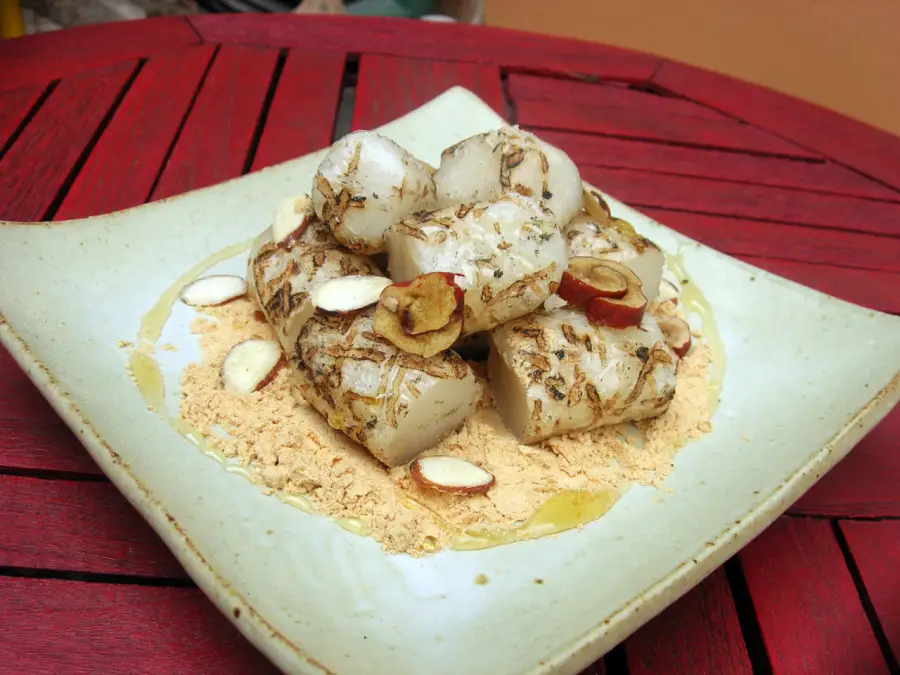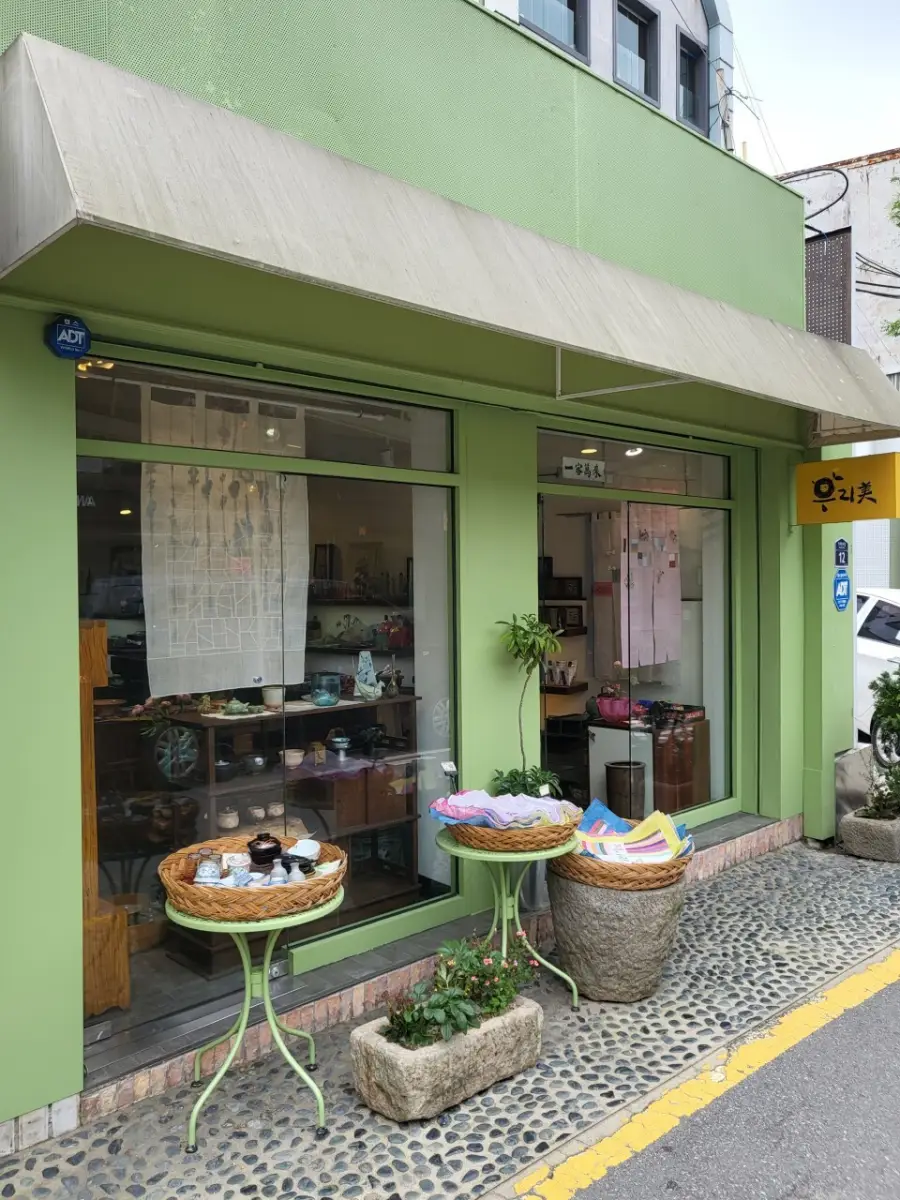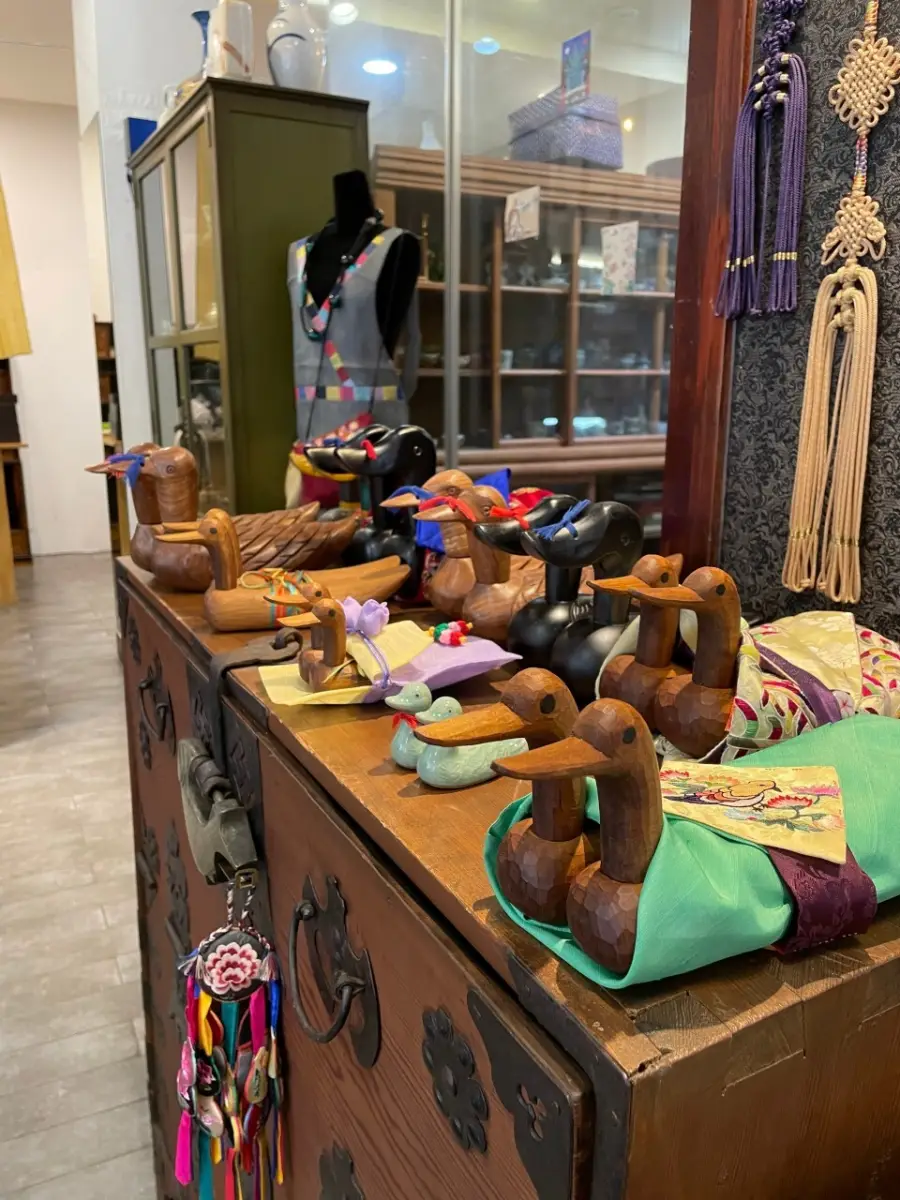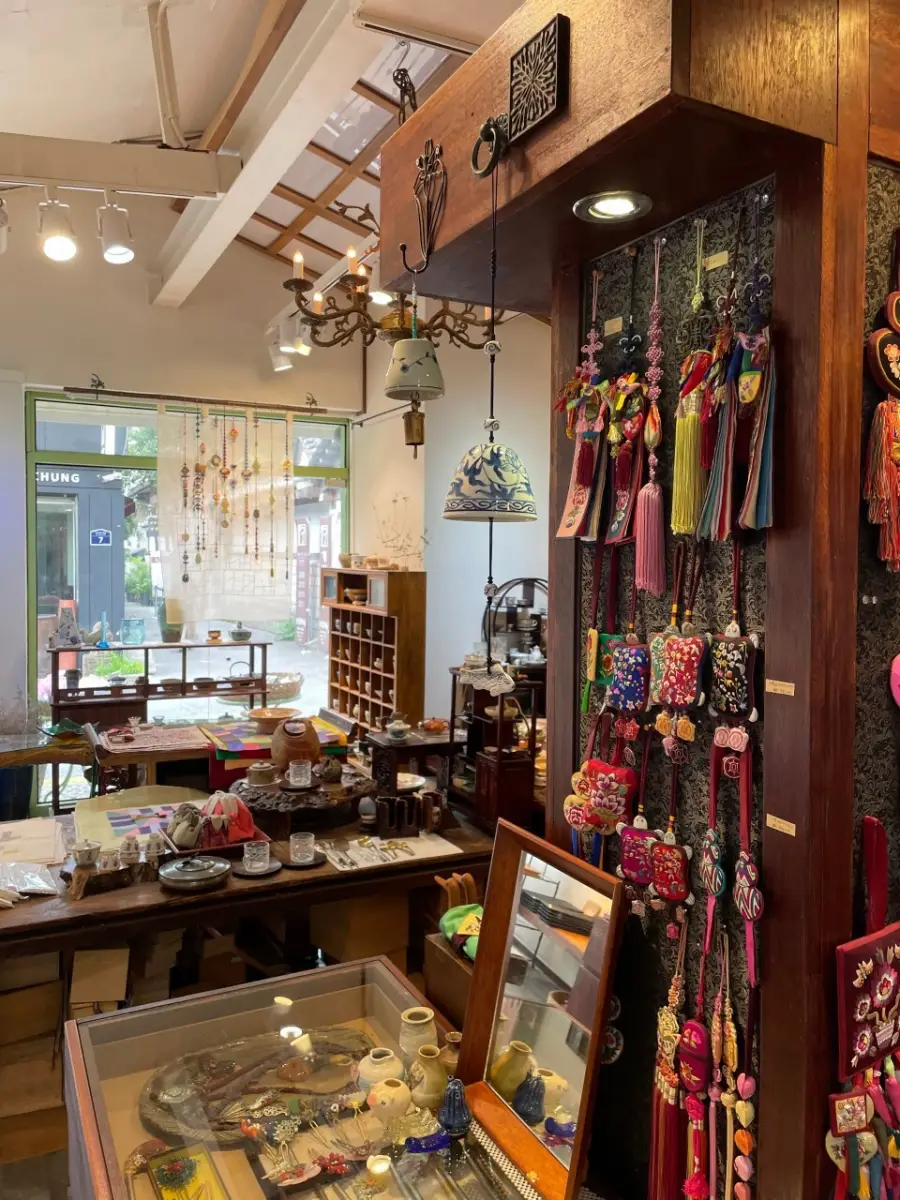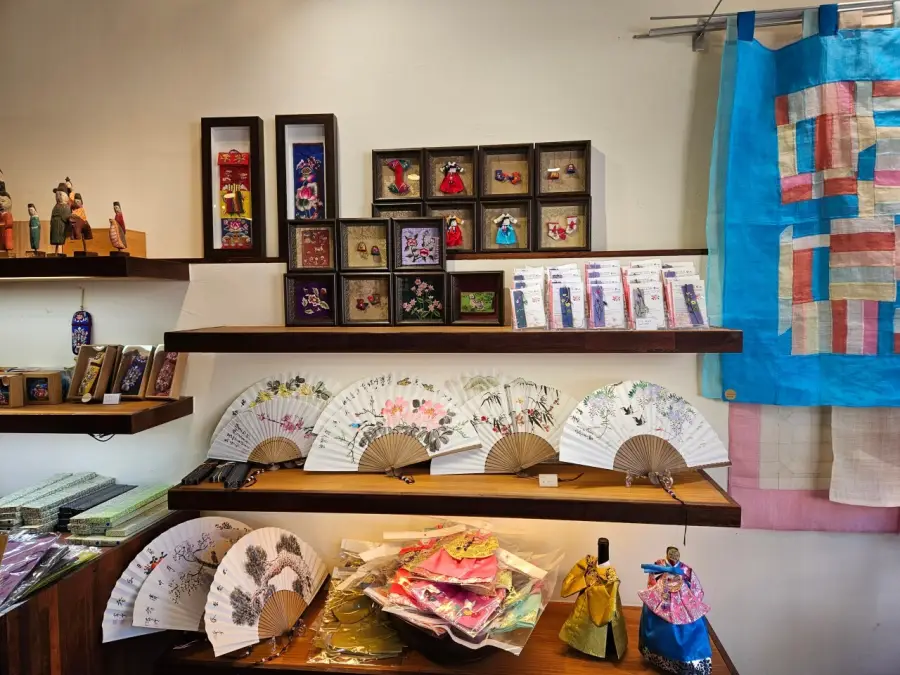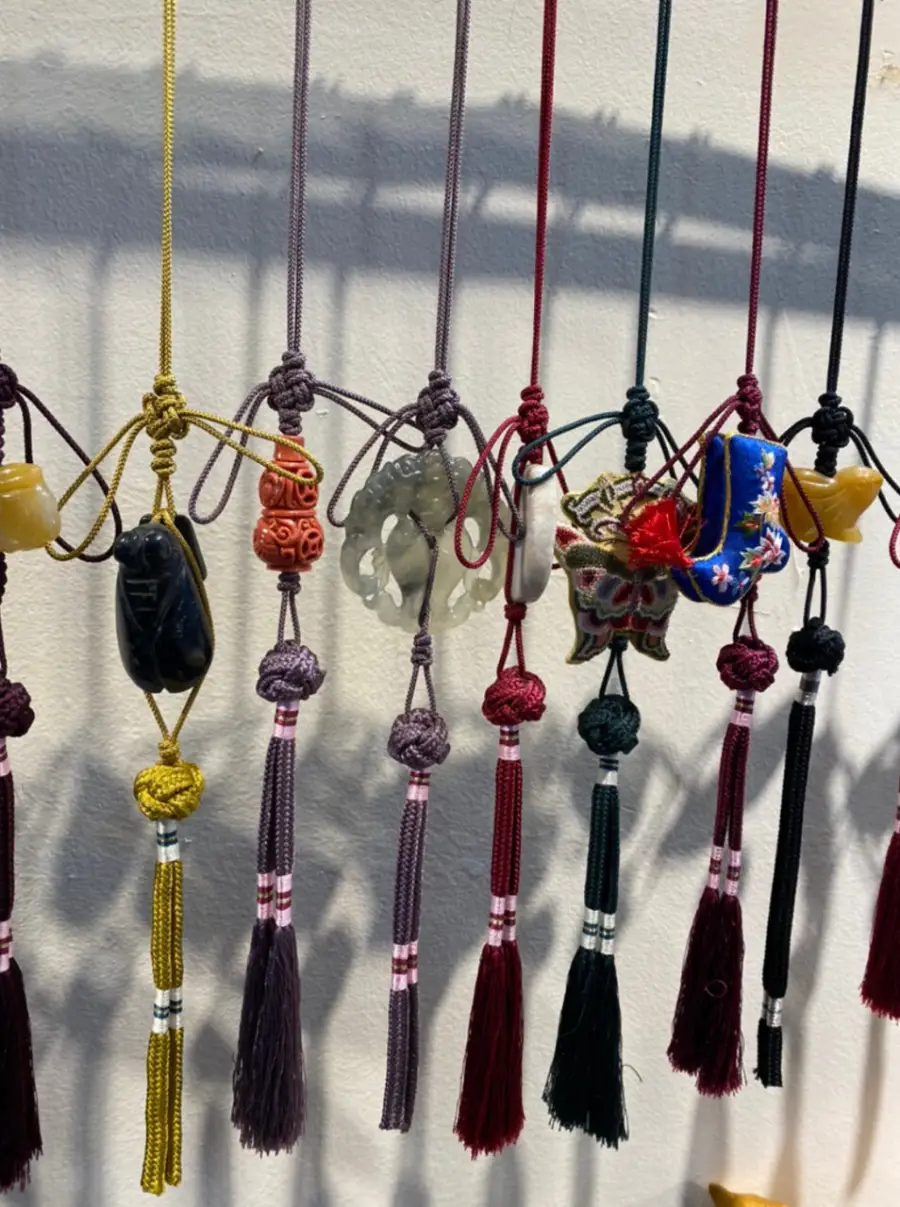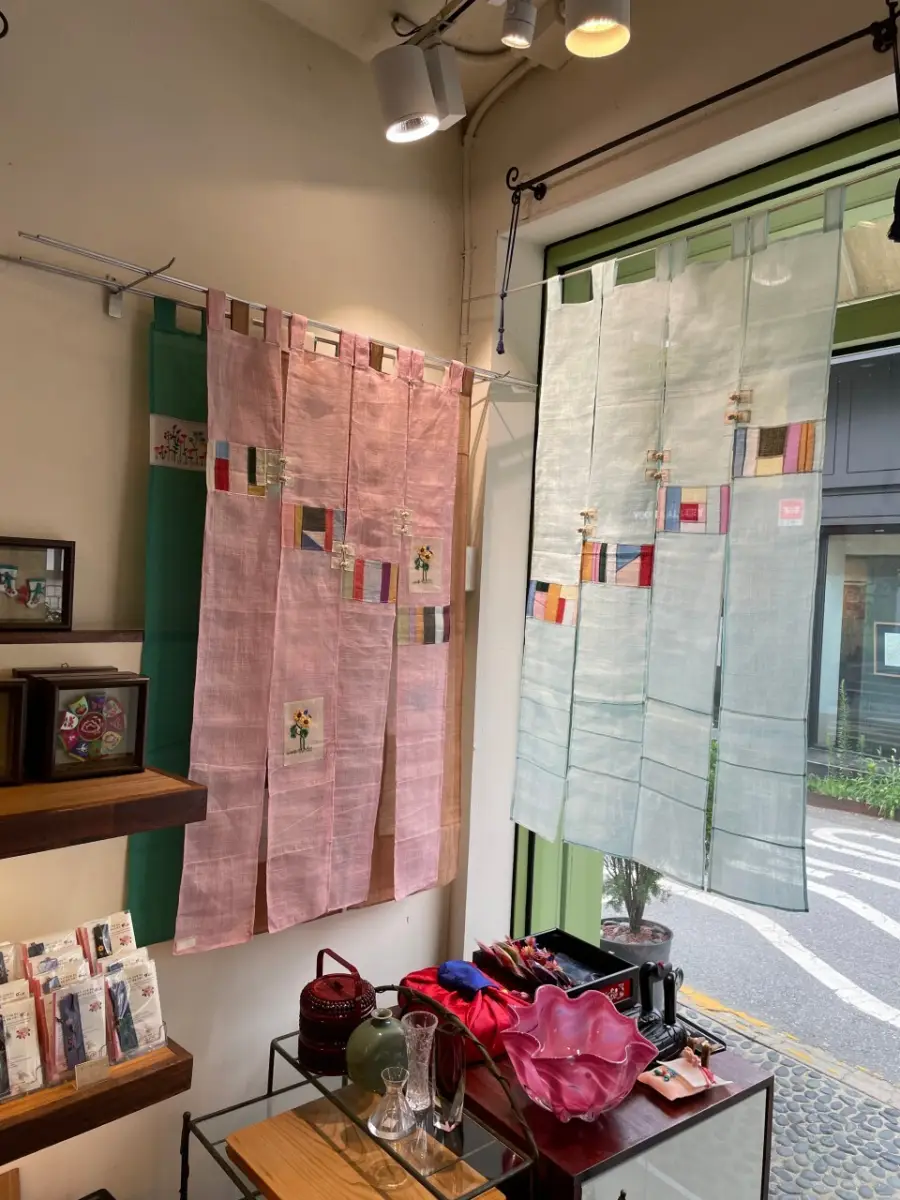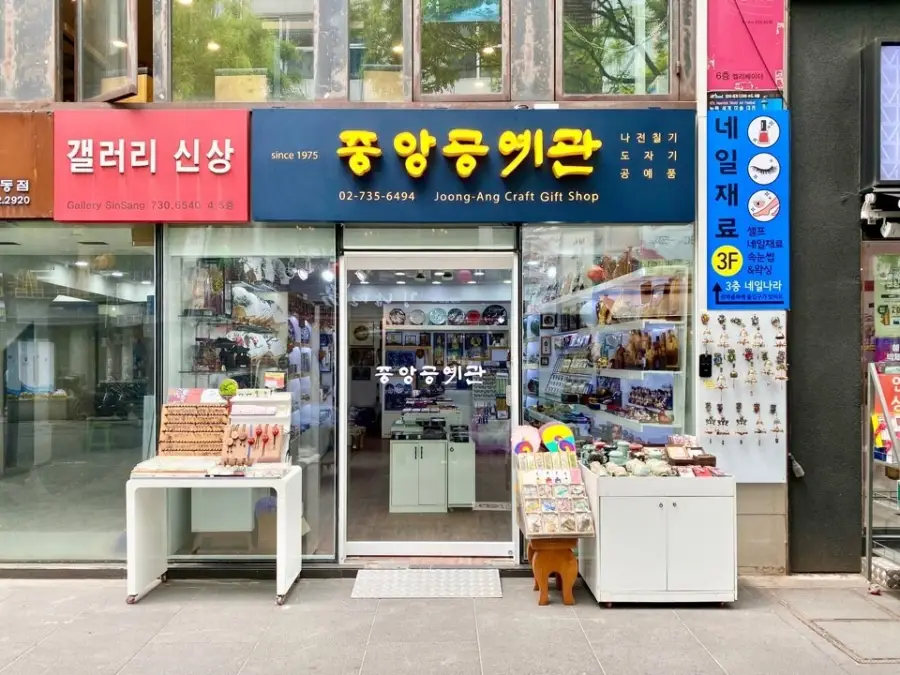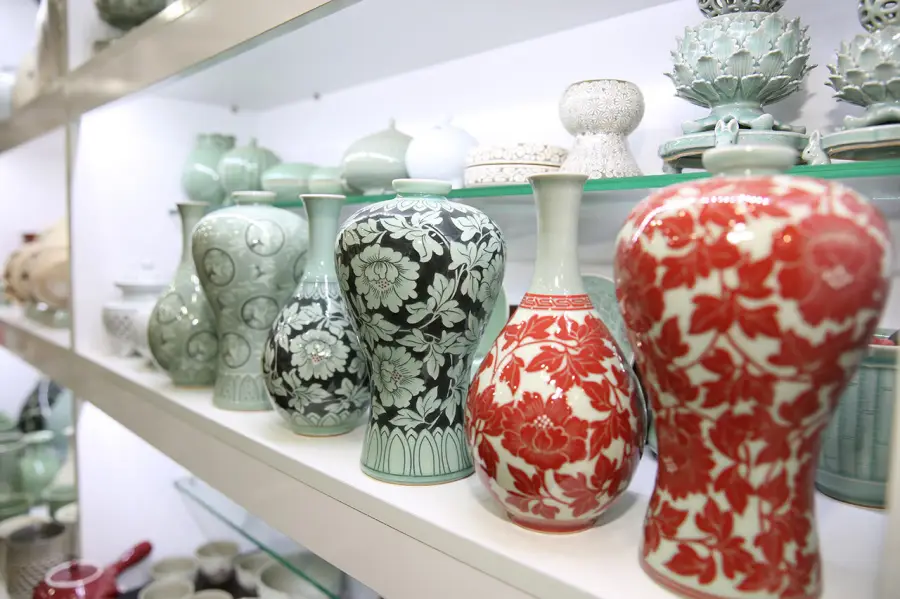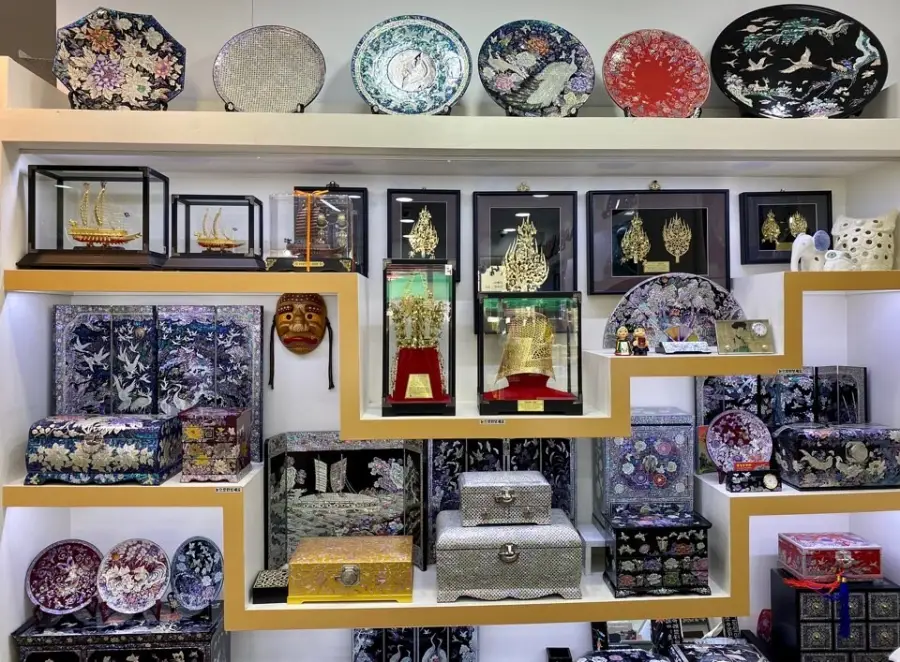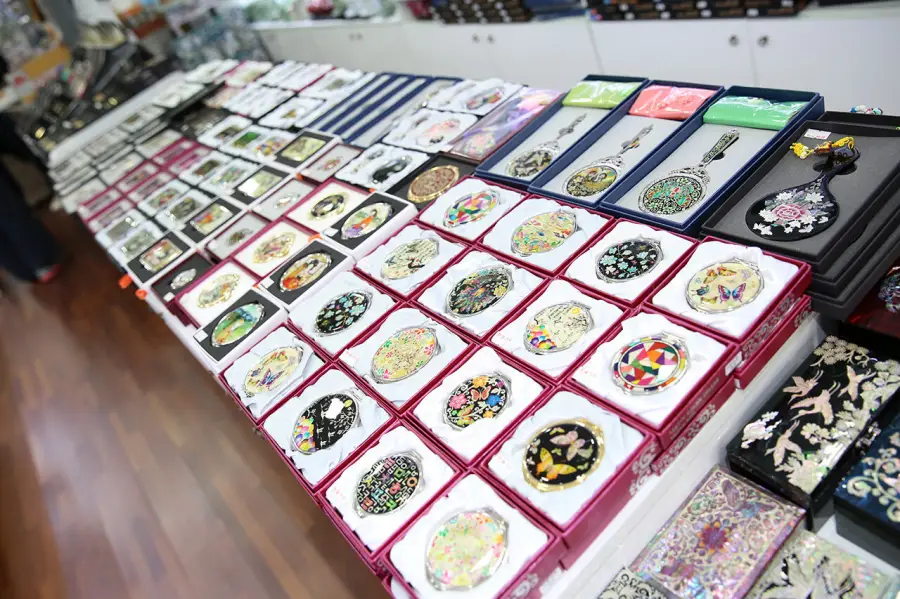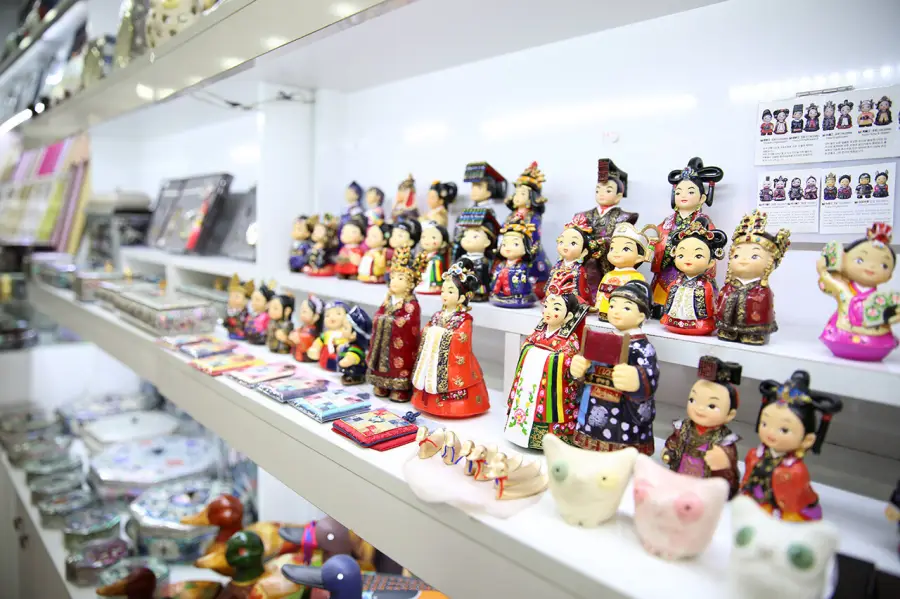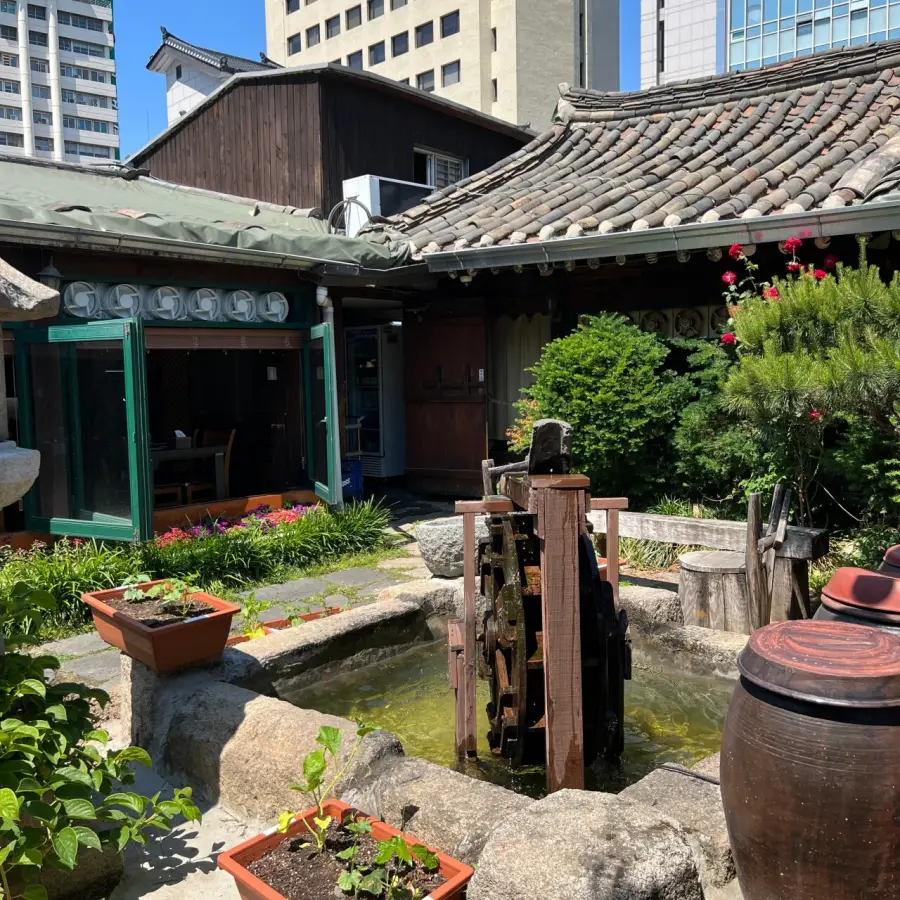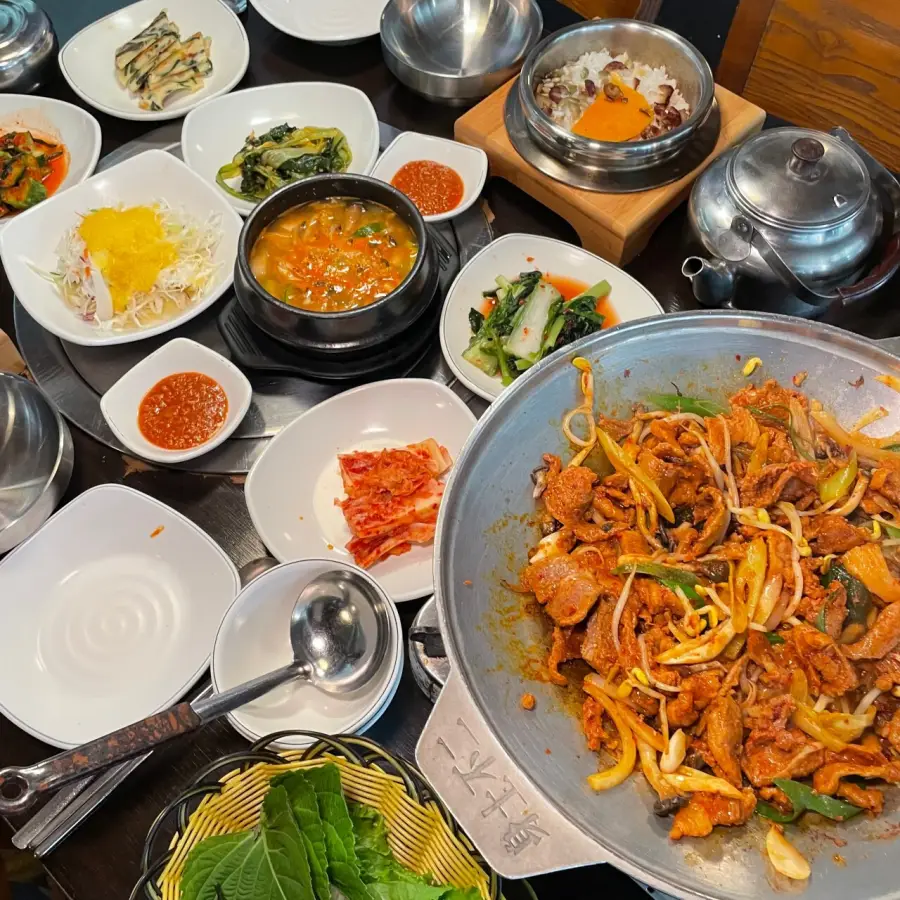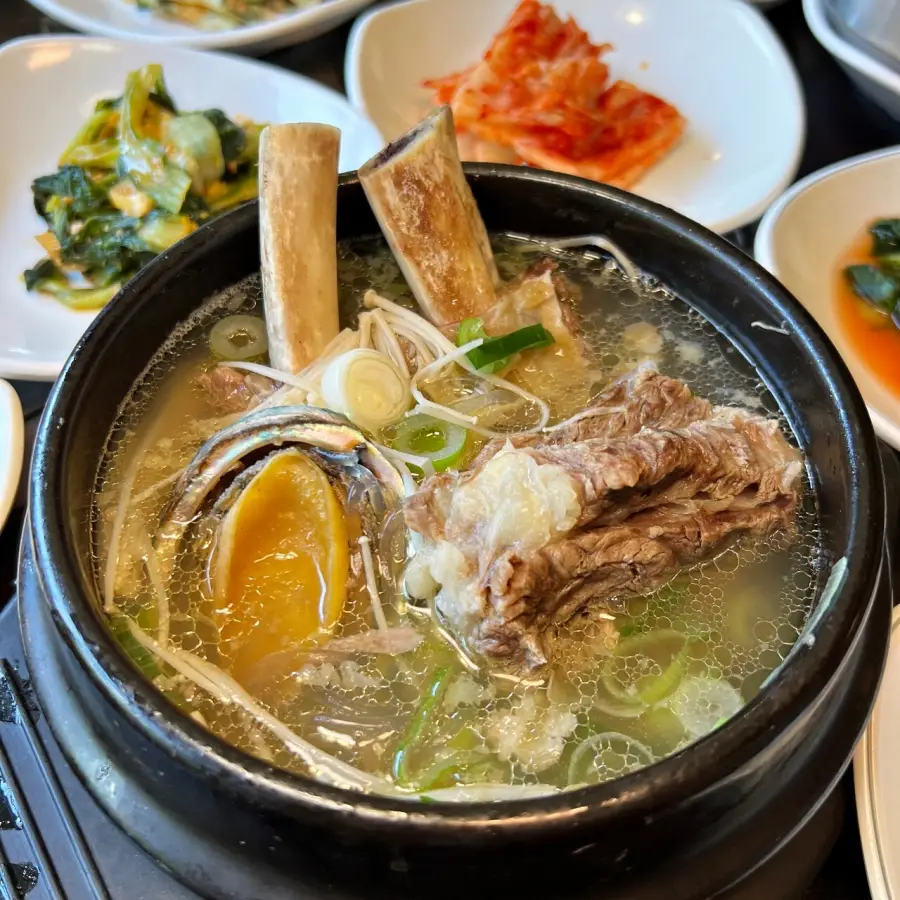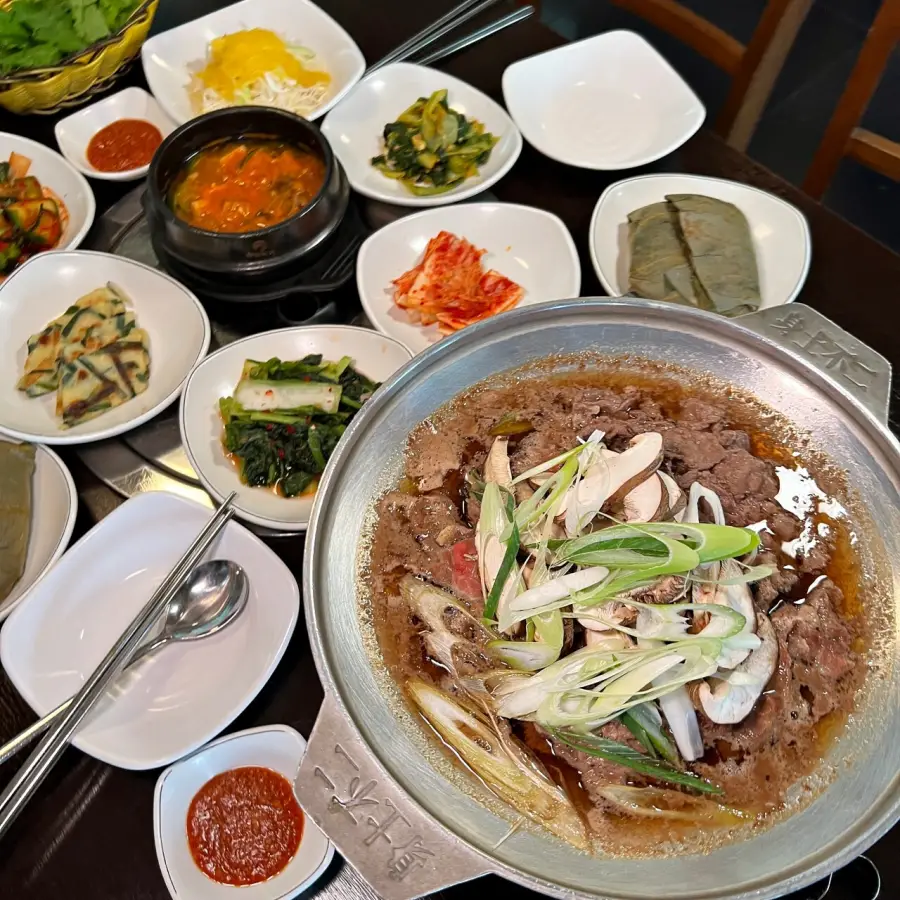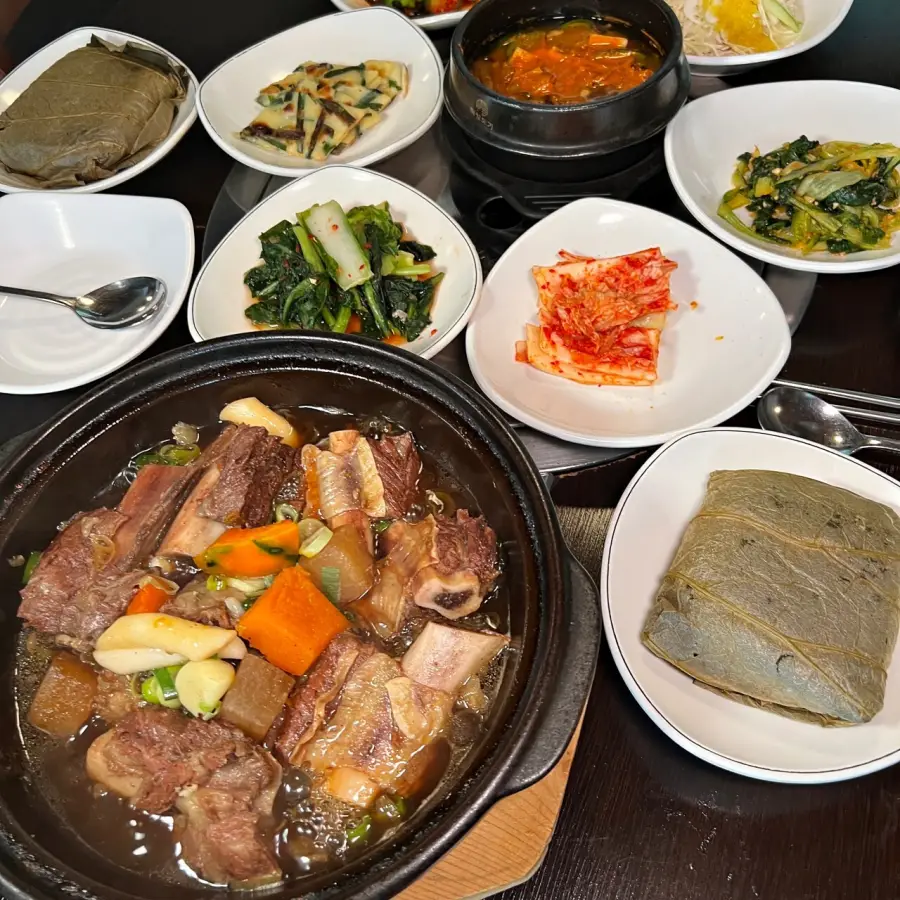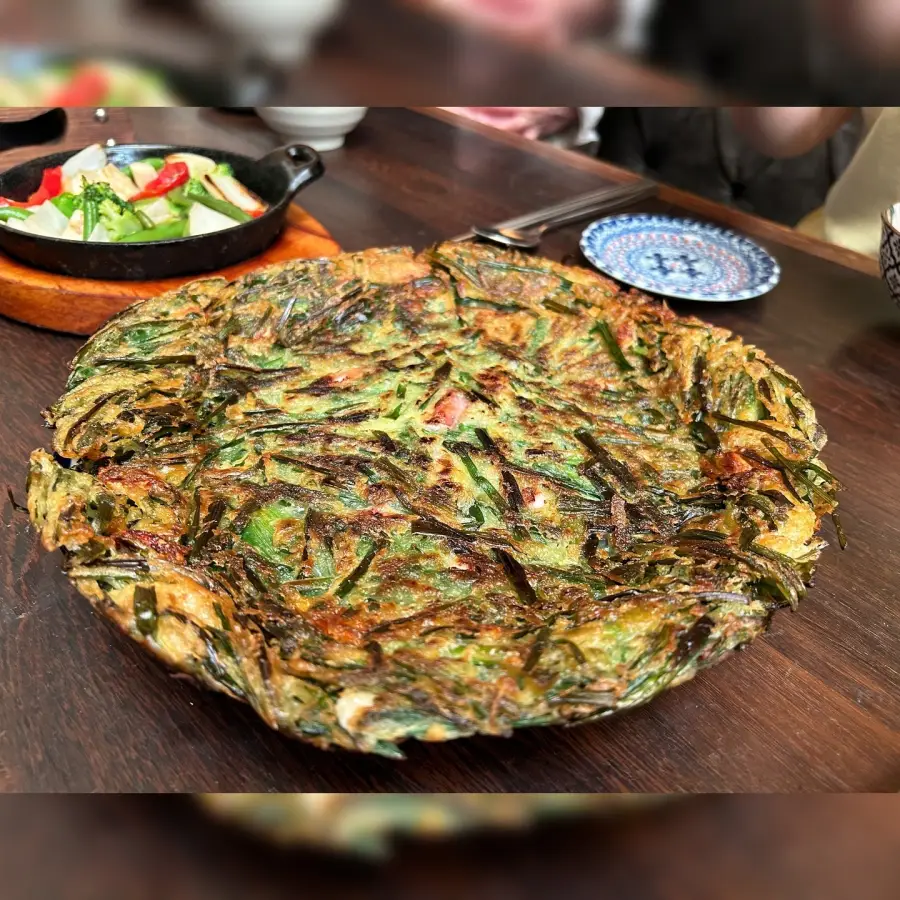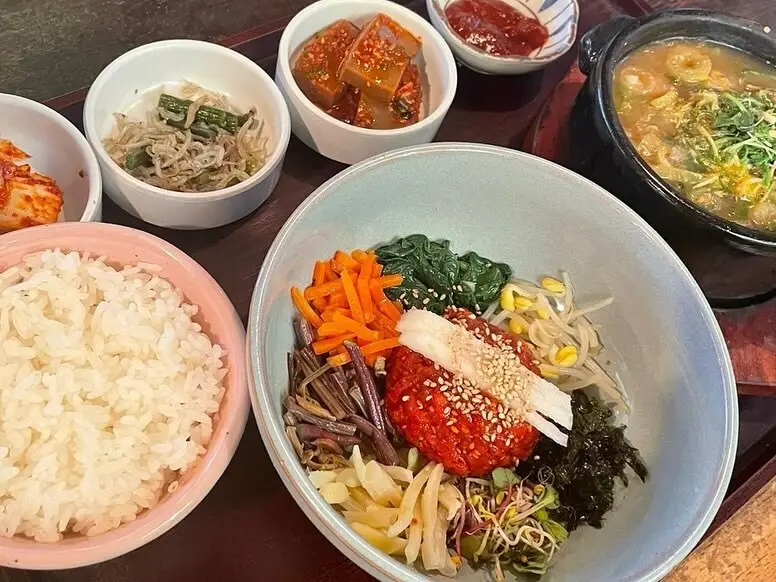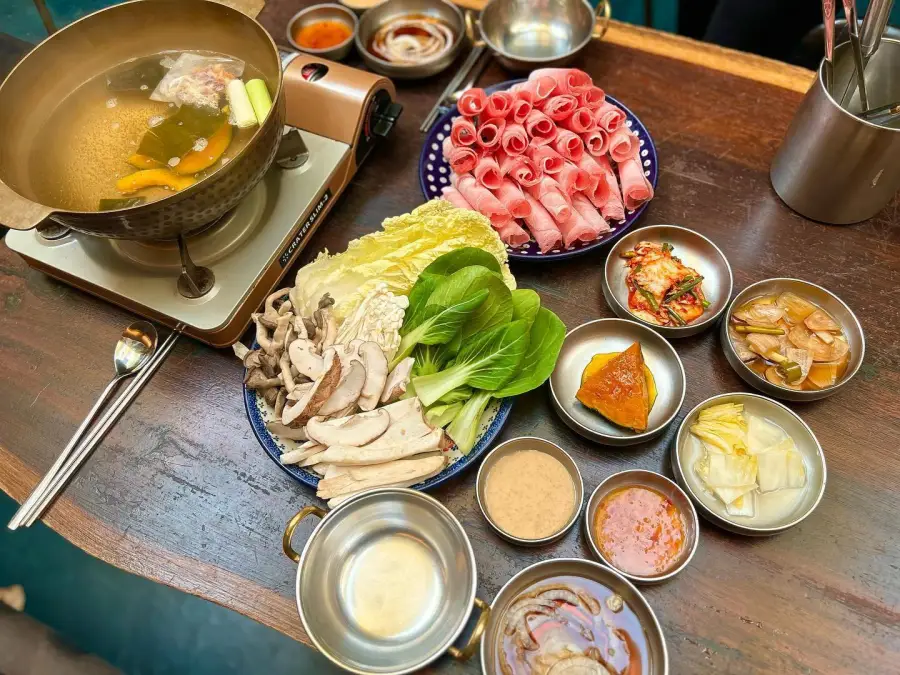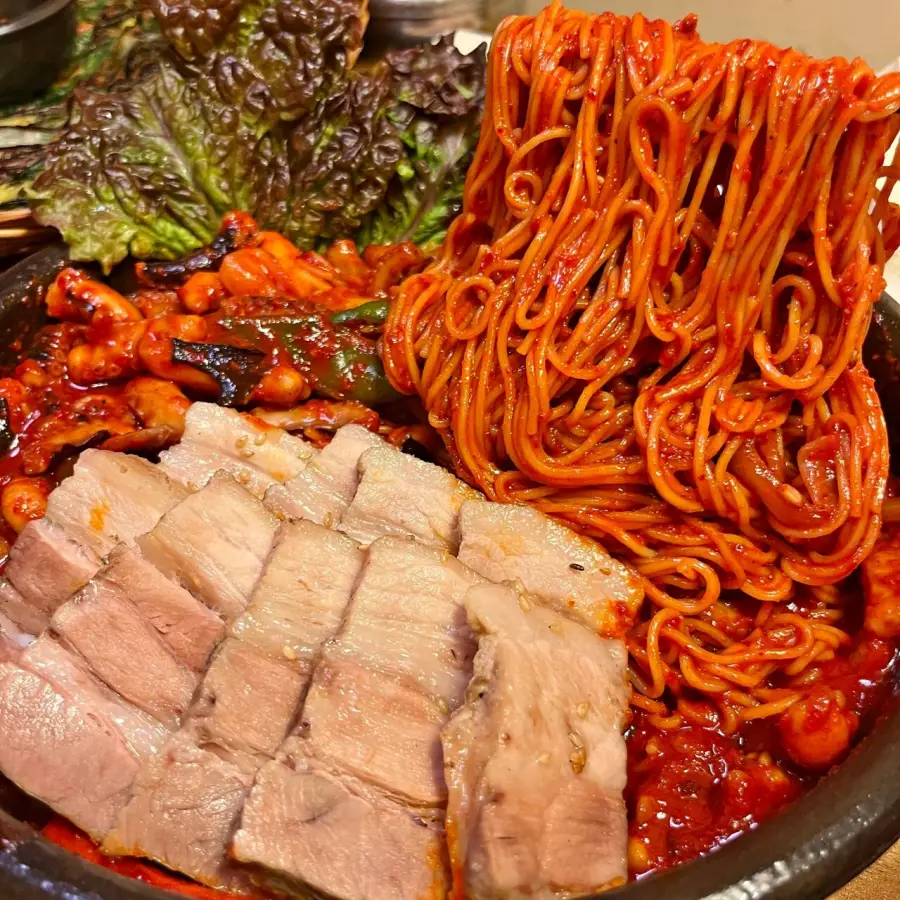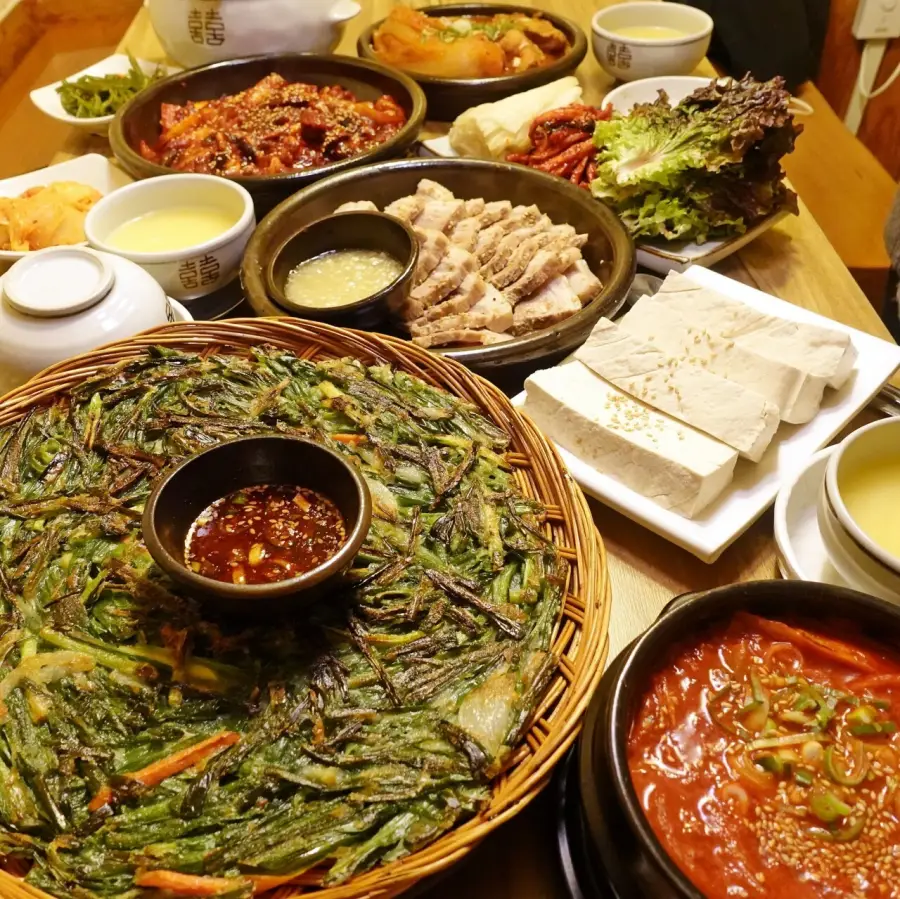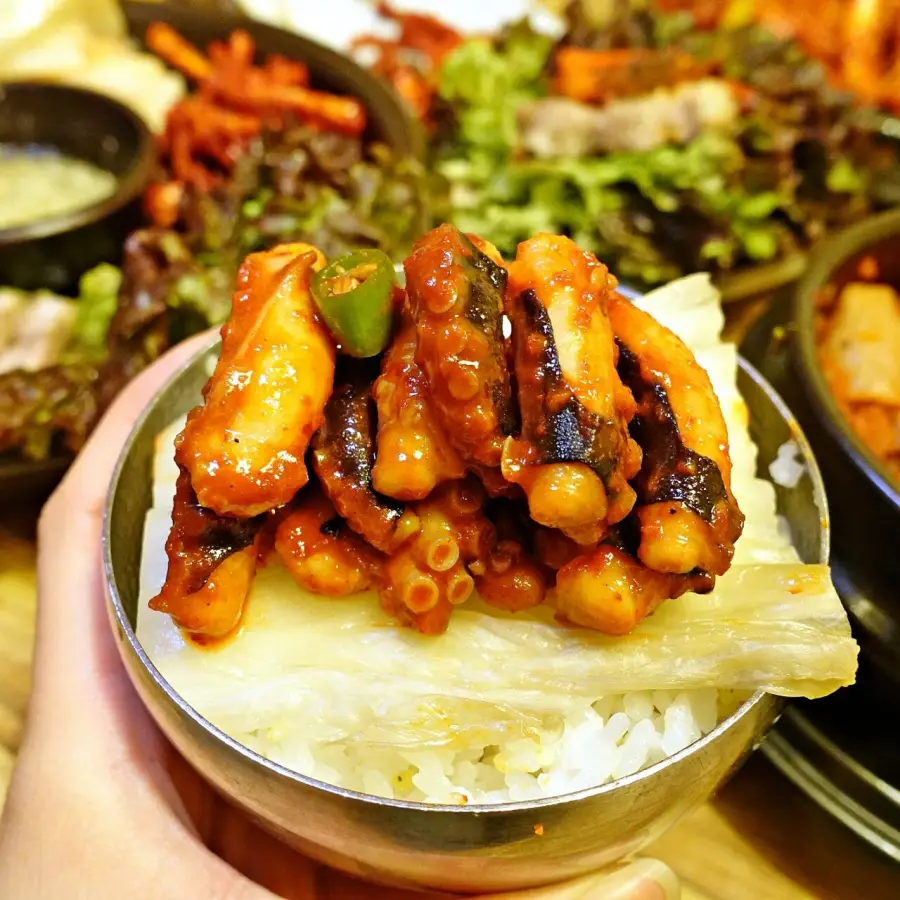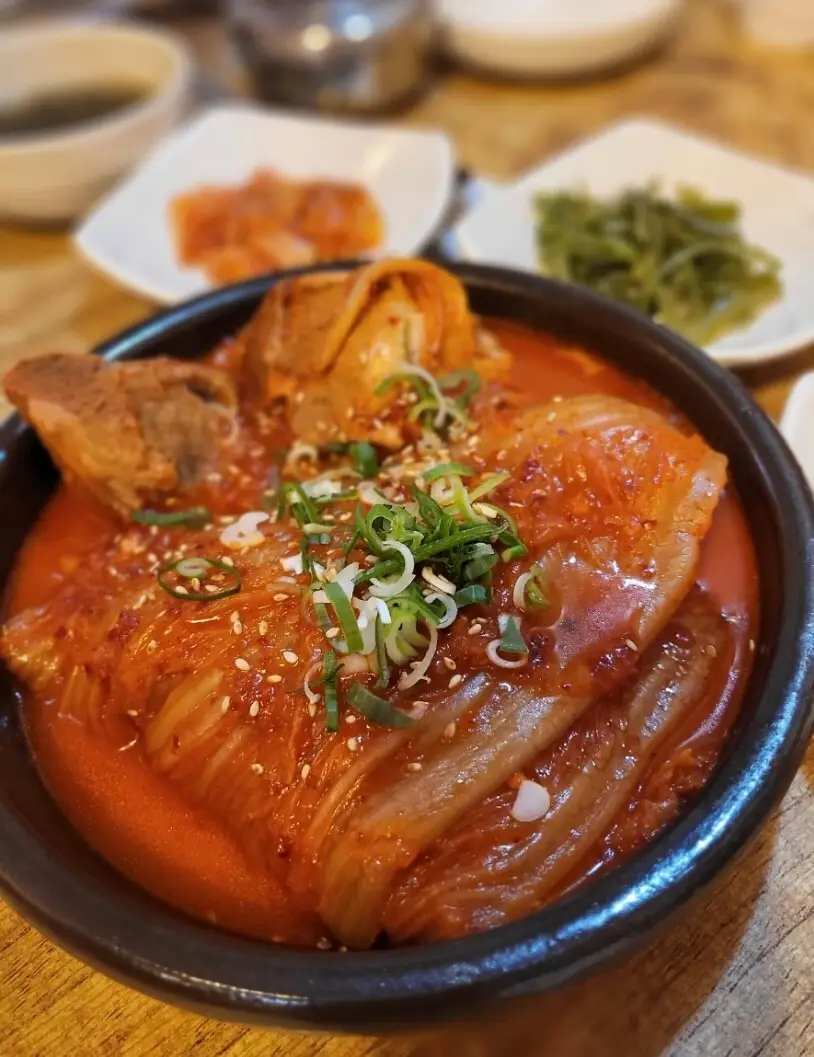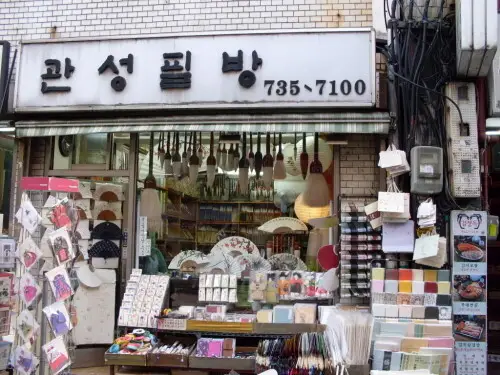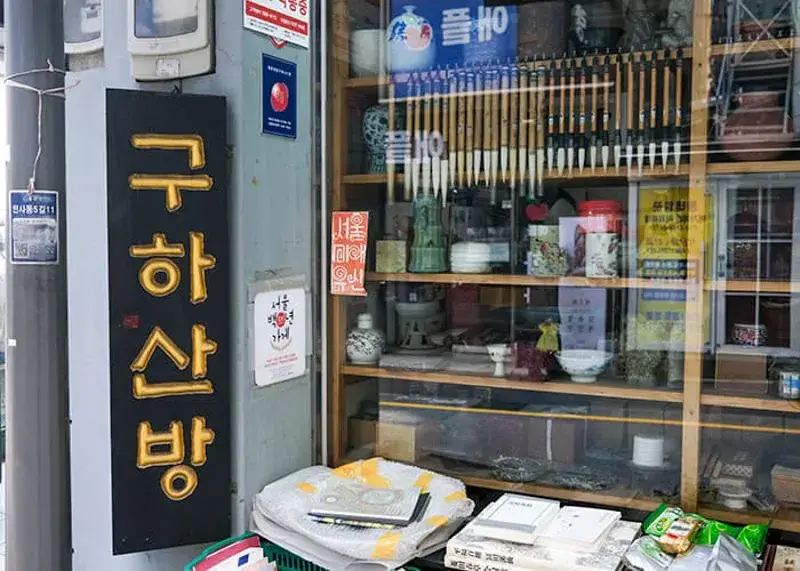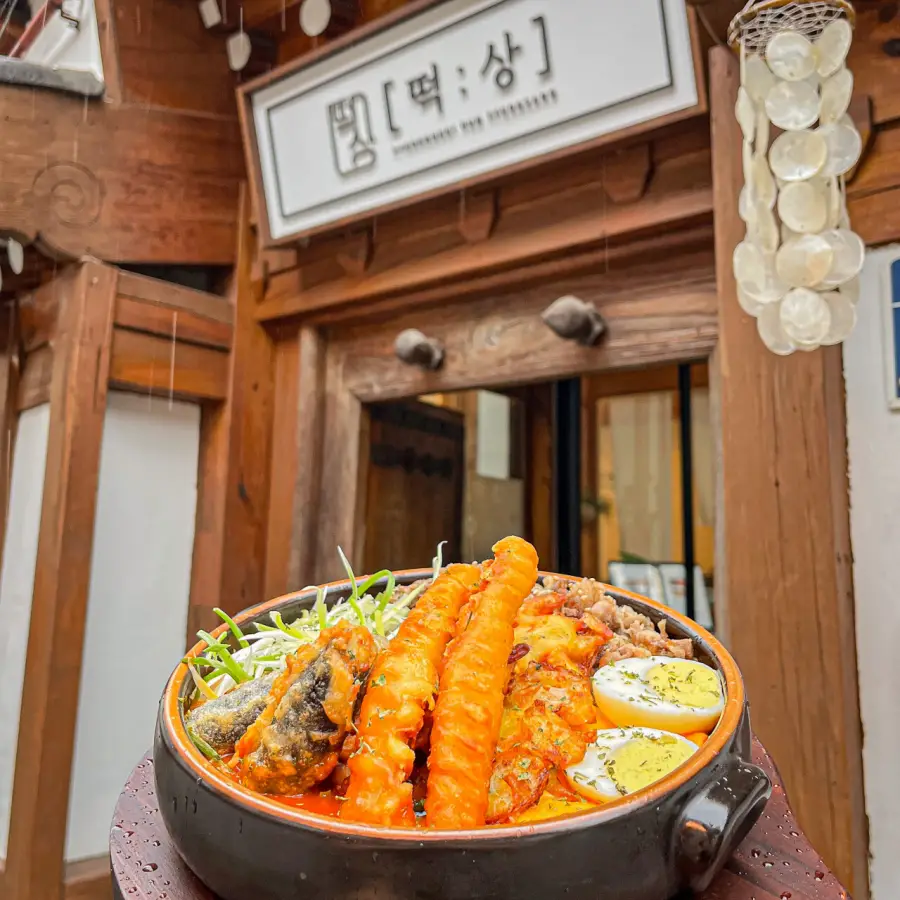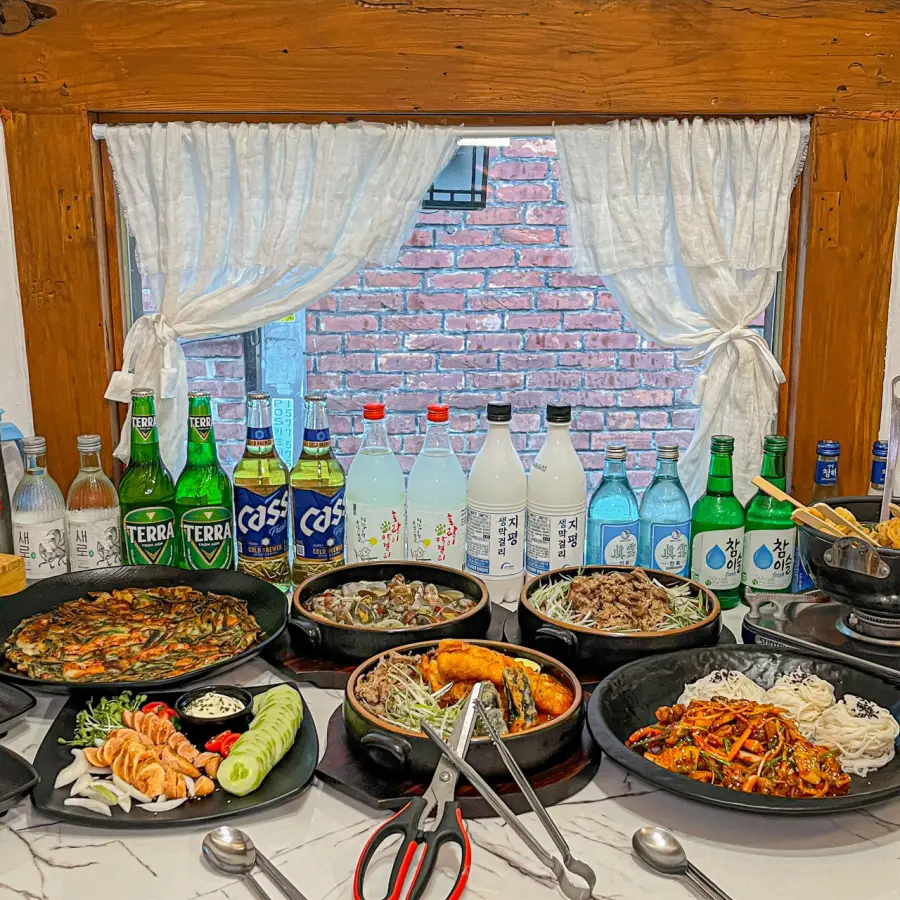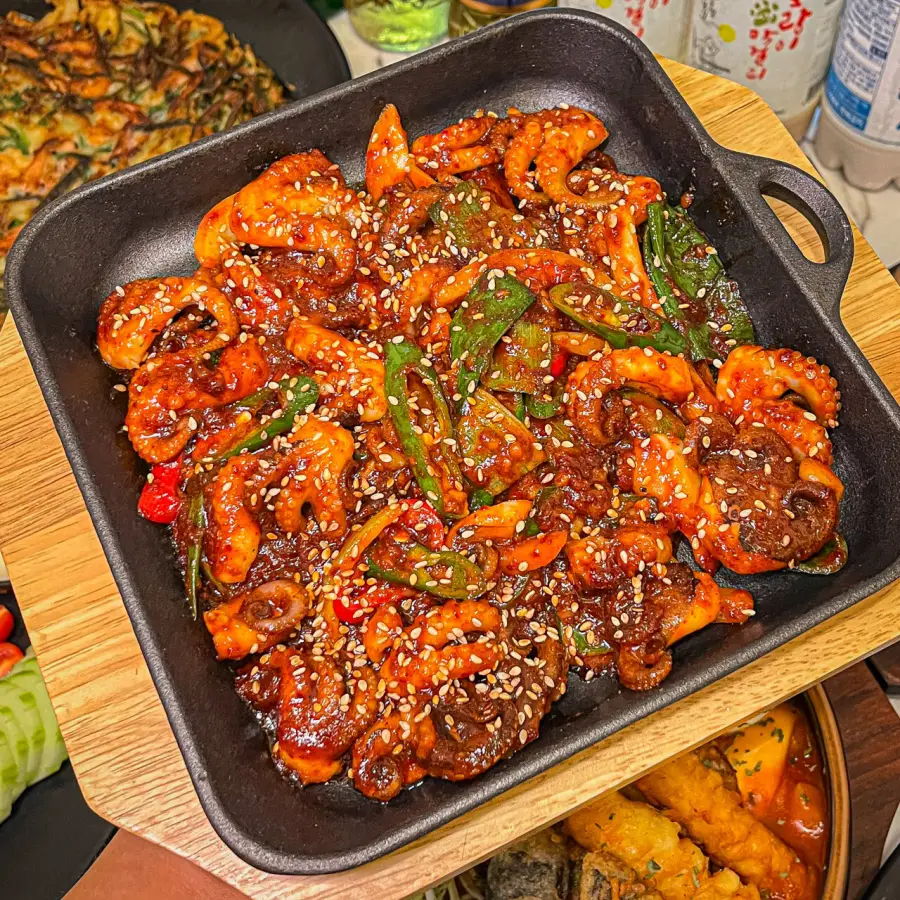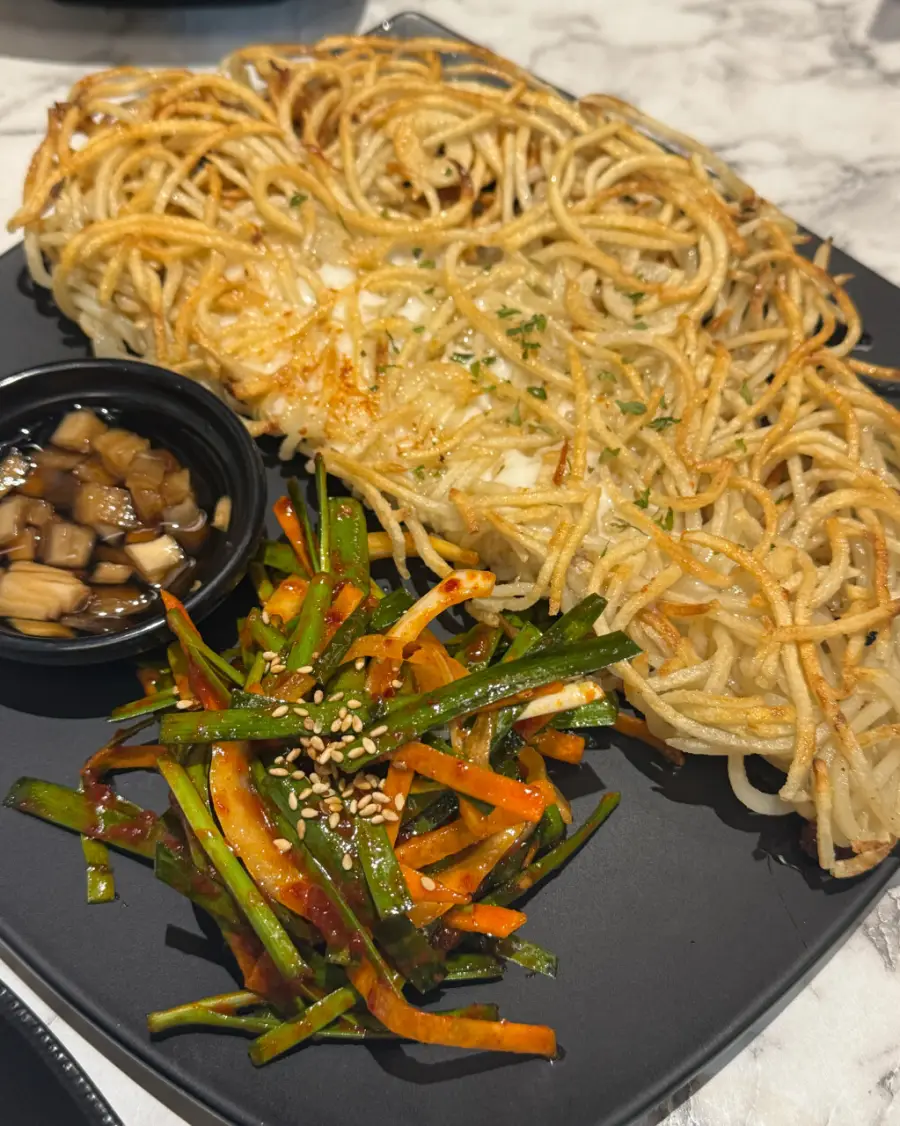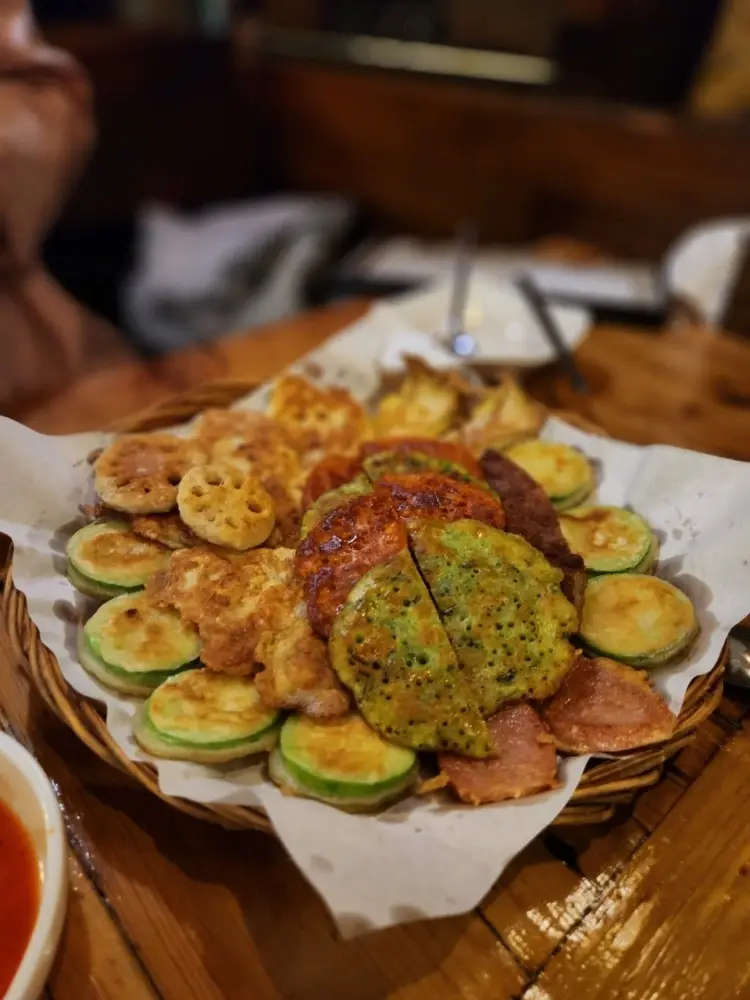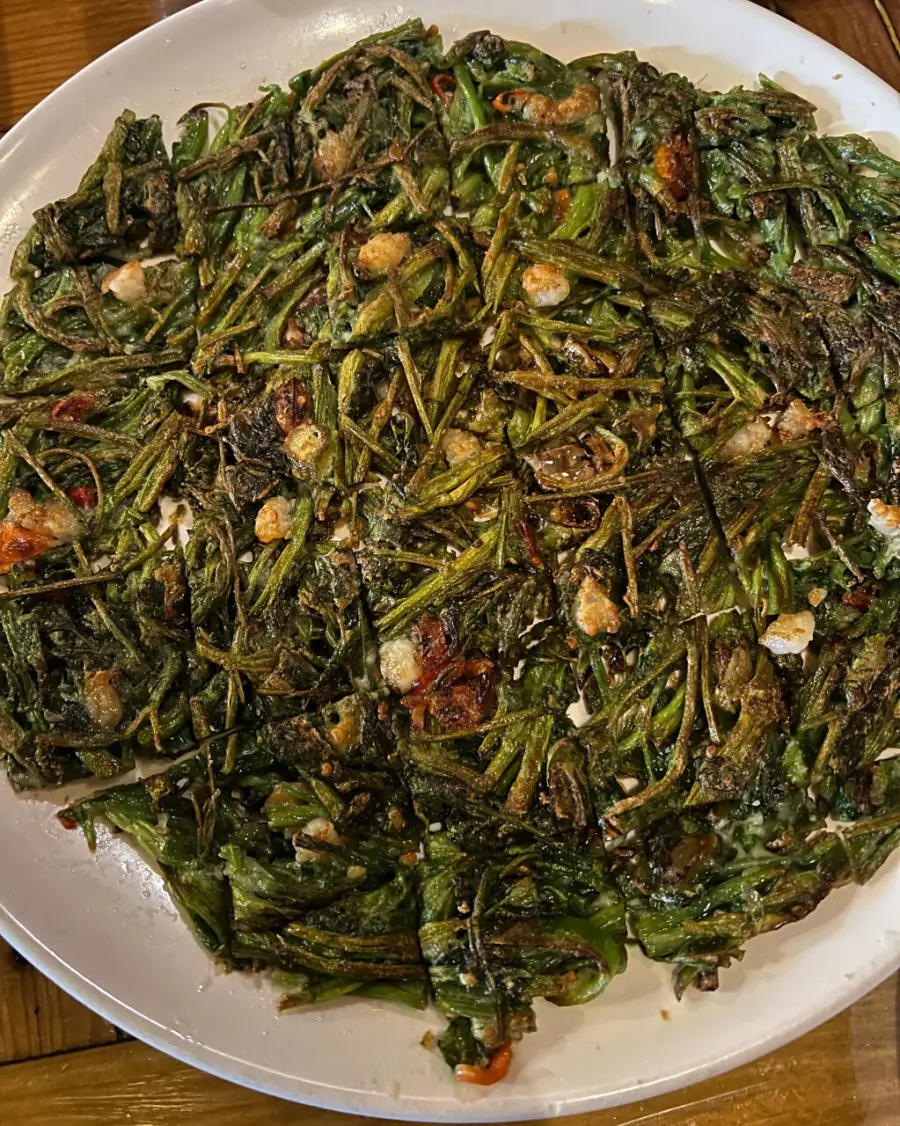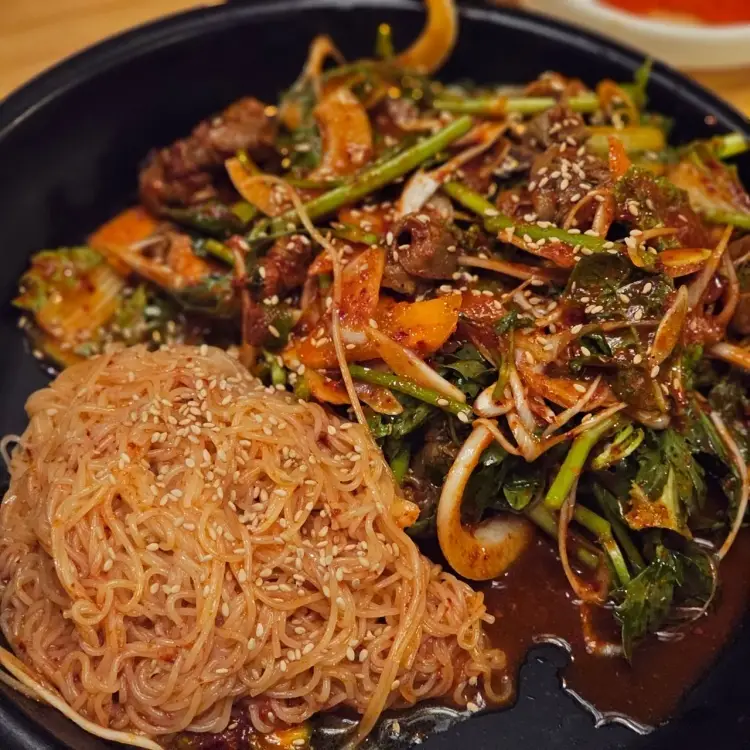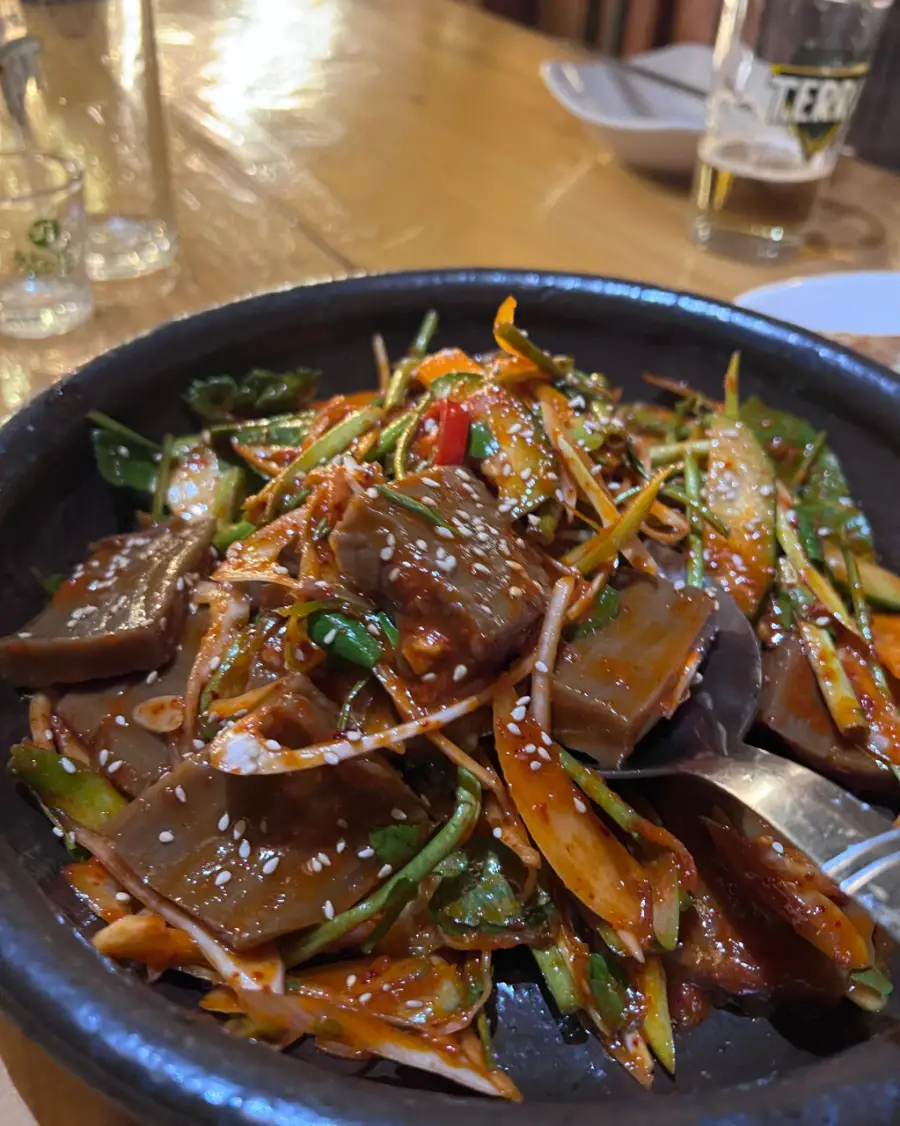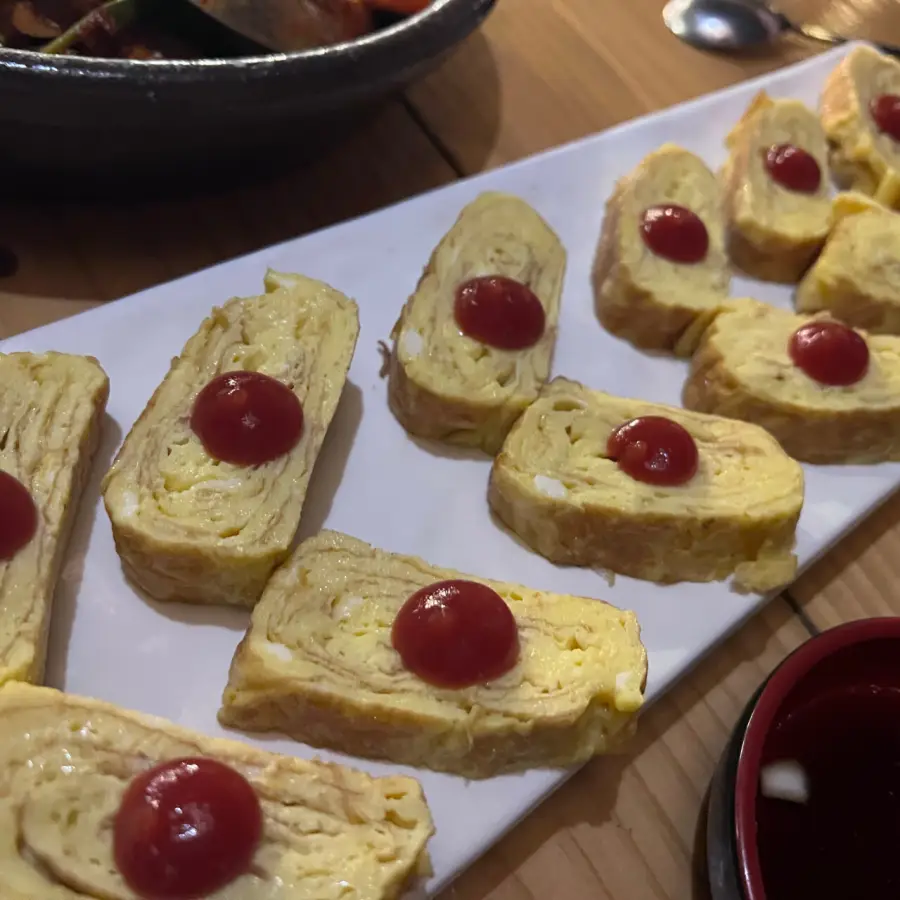Insadong
Insadong: The Heart of Korean Traditional Culture
Why not embark on a special journey through time in the heart of Seoul? Welcome to Insadong, a place that preserves the old Korean charm amidst modern skyscrapers.
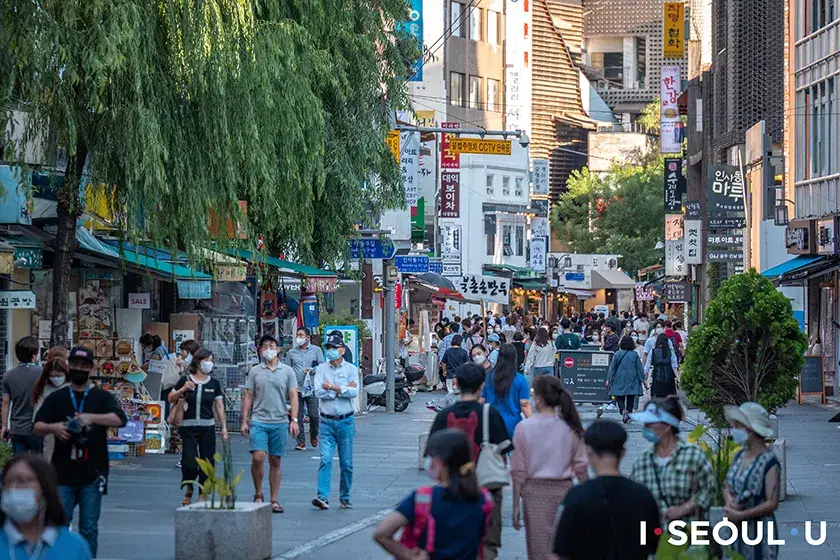
In the alleys steeped in hundreds of years of history, you’ll discover the spirit of master craftsmen, the subtle fragrance of traditional tea houses, and the artistic atmosphere of numerous galleries waiting for you.
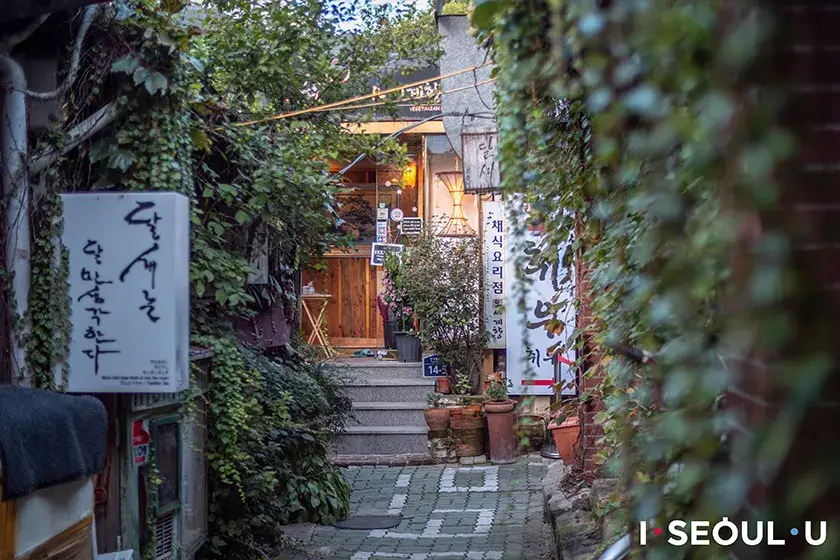
Whether you’re strolling the streets in traditional hanbok, experiencing Korean crafts firsthand in workshops, savoring traditional tea in a tranquil teahouse, or exploring the streets illuminated by soft lights at night, Insadong offers unforgettable memories for travelers. Let me guide you through the hidden charms and ways to enjoy Insadong.
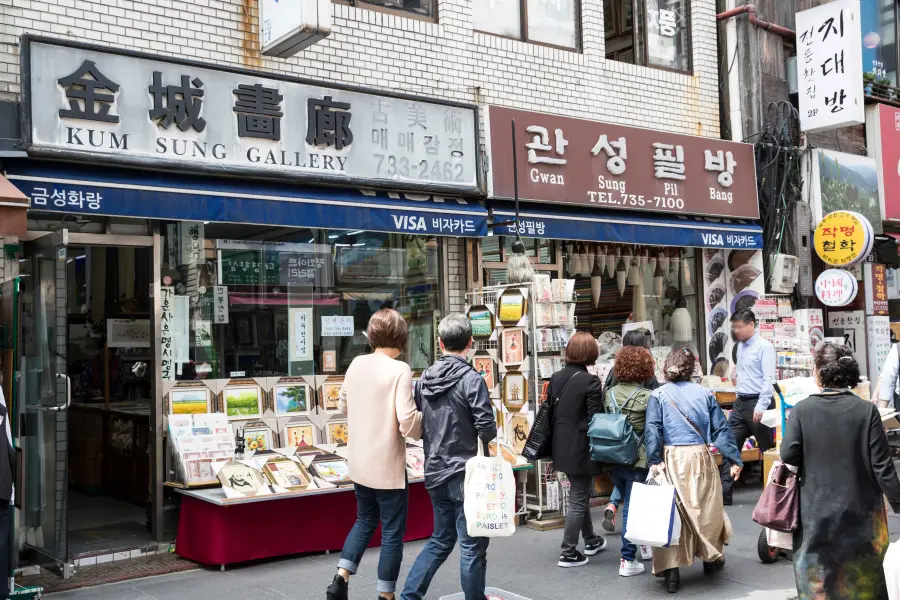
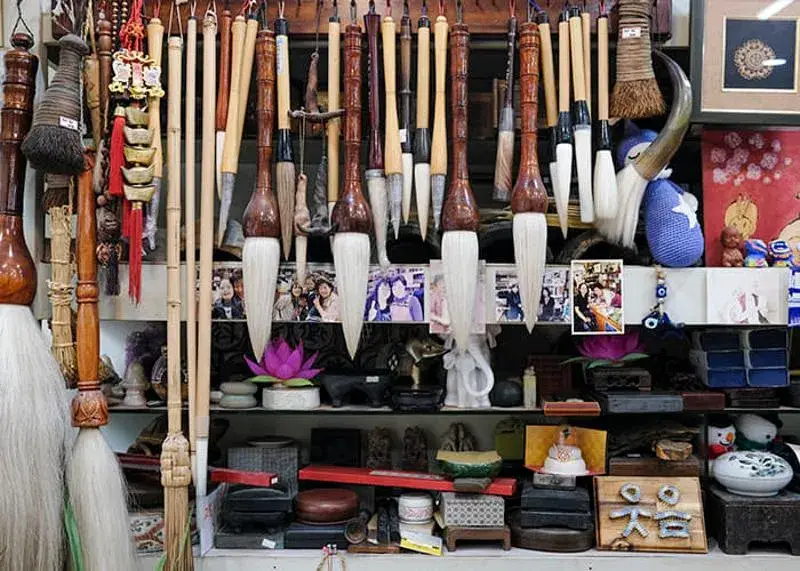

1. Overview
Introduction to Insadong
- What It’s Like
- At a Glance
What is Insadong Like?
Let me invite you to Insadong, a hidden gem in Seoul’s Jongno district. The moment you step into this area, you’ll feel as if time slows down in the midst of the bustling city. The elegant traces of Joseon Dynasty nobles and the legacy of the finest artists remain preserved in every corner of these alleys.
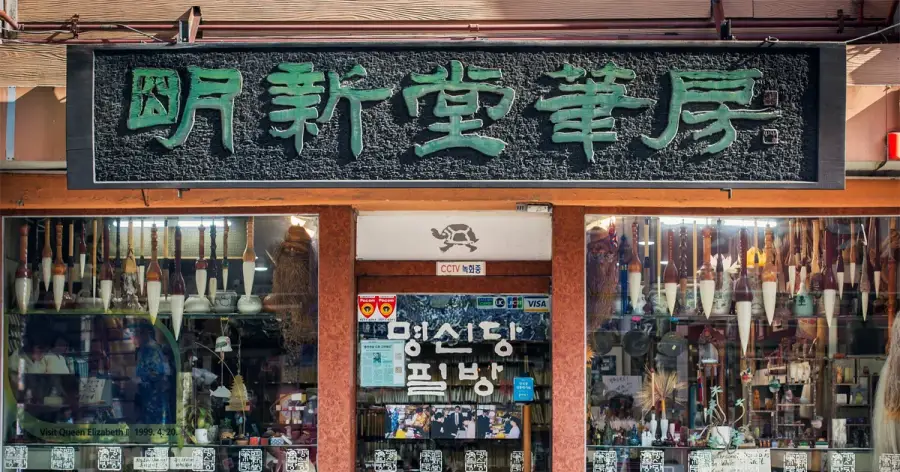
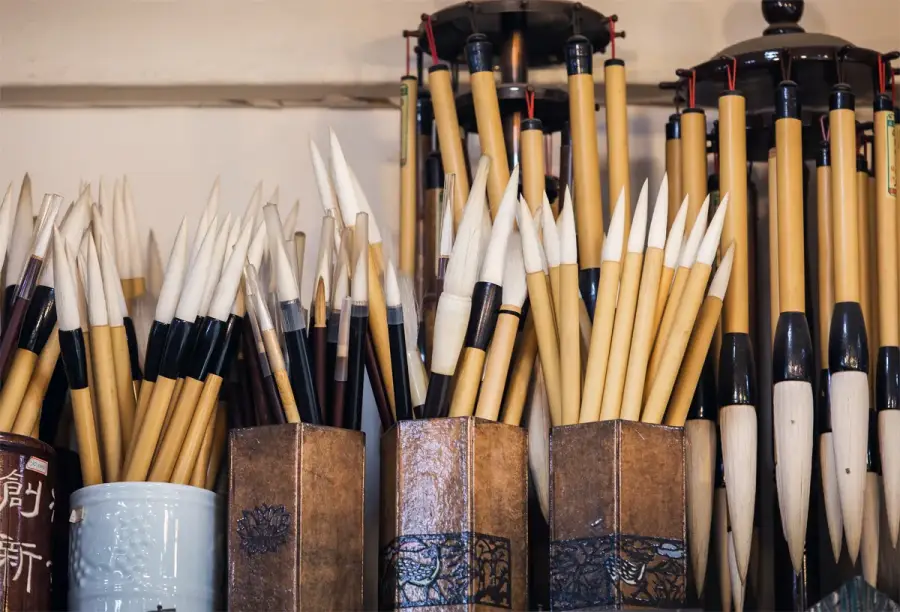
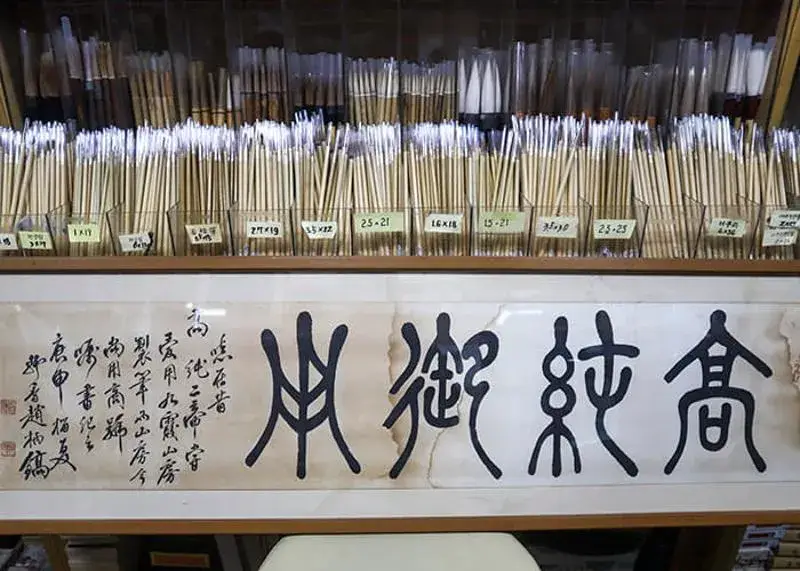
Starting from the 1930s, antique shops, traditional stationery stores, and art mounting workshops began establishing themselves here, creating the area’s unique identity. Particularly in the 1960s-70s, it became the heart of Korean art, and even today, more than 100 art galleries continue to tell the story of Korean art’s past and present.
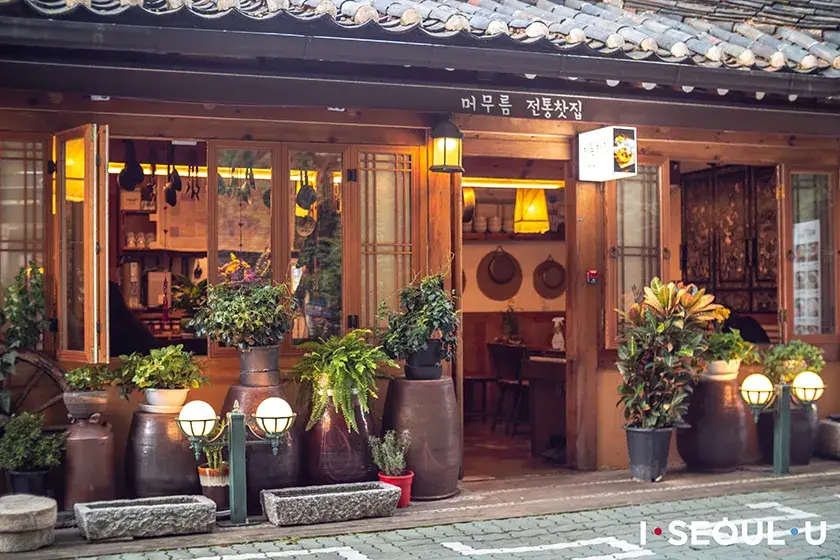
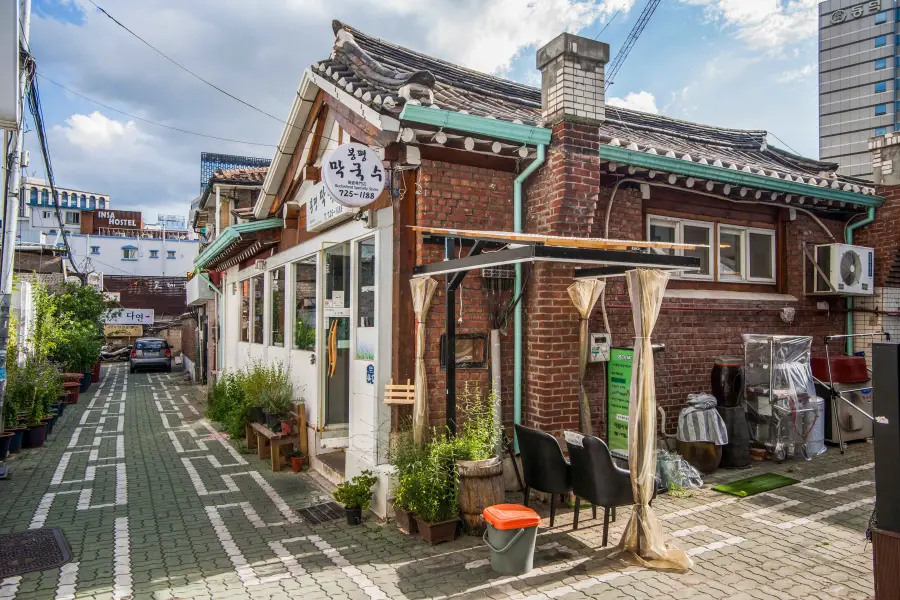
Today, Insadong is a captivating space where tradition and modernity dance hand in hand. As you follow the winding alleys, you’ll encounter master craftsmen meticulously creating hanji (traditional paper), the subtle aroma of traditional tea, and antiques bearing the weight of time. On weekends, it becomes a car-free street, allowing you to enjoy all these experiences at a leisurely pace.

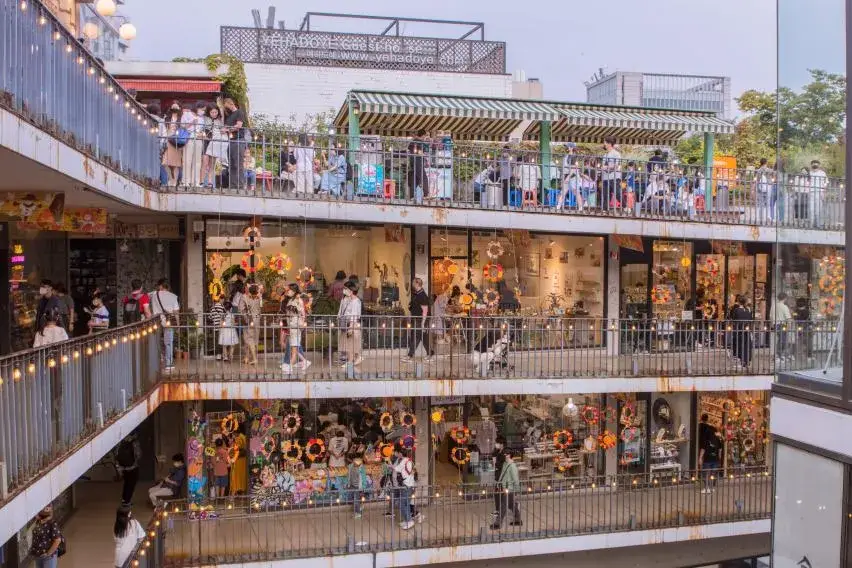
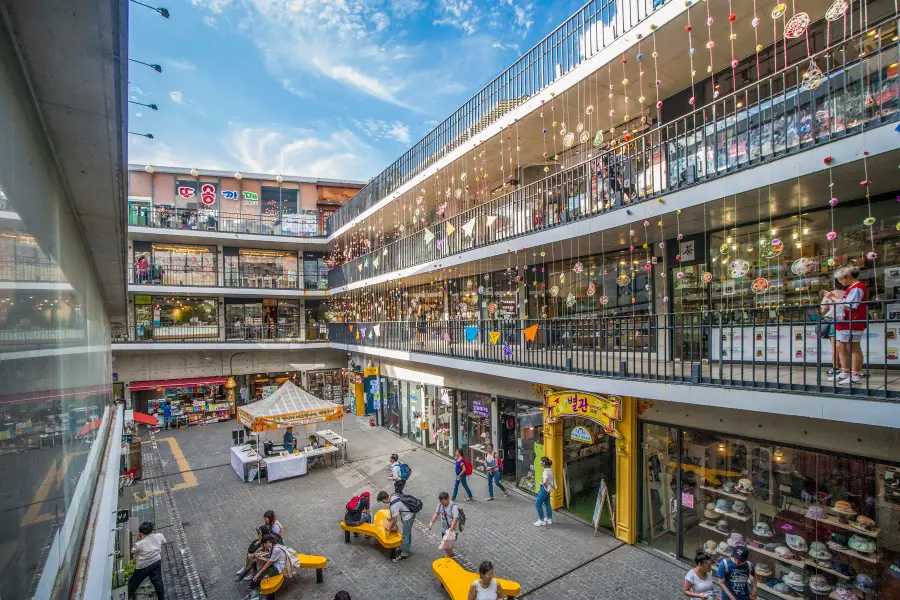
And don’t miss Ssamziegil, the jewel of Insadong. Inside its unique spiral structure, young artists’ fresh perspectives meet traditional beauty to create a special harmony. Here, you can discover works that reinterpret Korean traditions in contemporary ways.
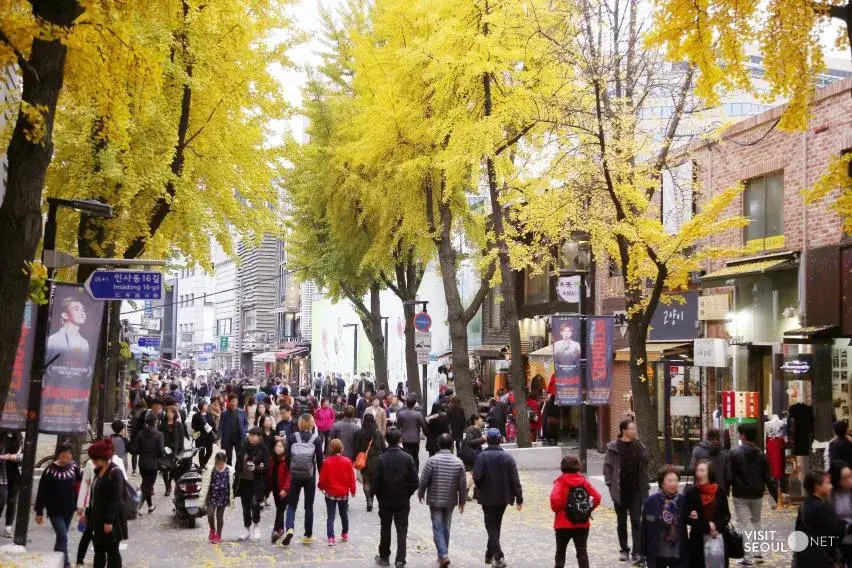
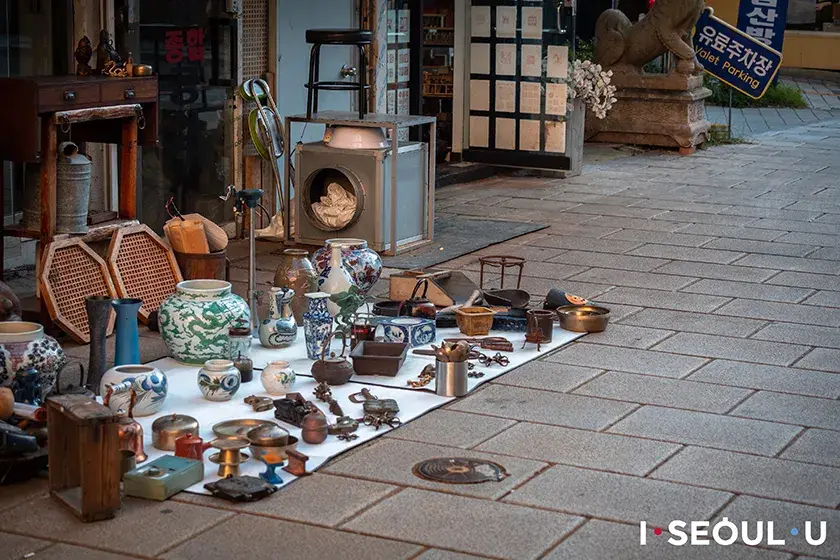
Even Seoul locals visit here on weekends to relax, experience traditional Korean culture, and find healing for their souls. How about creating your own unforgettable memories in this special street?
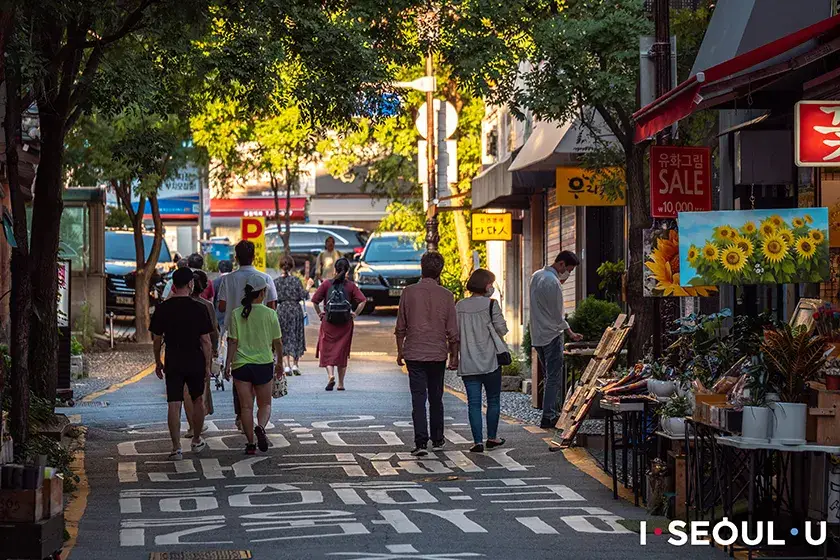
Insadong at a Glance
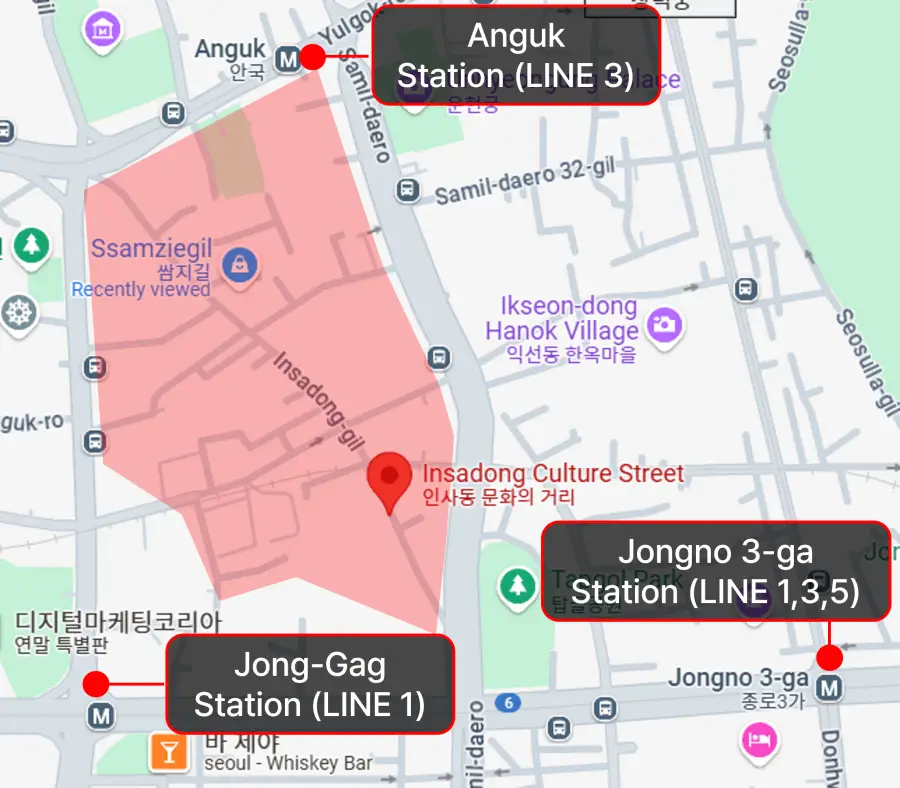
2. Information
Visit Information : Insadong
- Operating Hours
- How to Get There
Insadong Operating Hours
| Types | Operating Hours |
|---|---|
| Most shops | 10:30 AM – 8:30 PM |
| Ssamziegil | 10:30 AM – 8:30 PM |
| Restaurants | 11:00 AM – 10:00 PM |
| Cafes | 10:00 AM – 10:00 PM |
※Please note:
Operating hours may vary by store. We recommend checking in advance, especially during public holidays and traditional Korean holidays, to avoid disappointment!
How to Get to Insadong
Click ‘Here‘ to add it to Google Maps.
Line 1: Exit 3 of Jonggak Station (5-minute walk)
Line 3: Exit 6 of Anguk Station (5-minute walk)
Line 5: Exit 1 of Jongno 3-ga Station (10-minute walk)
Get off at Jongno 2-ga/Samil Bridge Stop Local Green Bus: 101, 103, 143, 150, 160 Blue Bus: 601 Red Express Bus: 9301
Get off at Insadong/Naminsa Stop Local Green Bus: 108, 109, 151, 162, 171, 172, 272 Blue Bus: 601
3. Highlight
Things to Do in Insadong
- Explore Ssamziegil
- Enjoy Traditional Tea Houses
- Try on Hanbok
- Explore Traditional Crafts
- Gallery Tour Experience
- Sample Traditional Food
- Visit Traditional Stationery Stores
- Browse Antique Shops
- Experience Insadong Maru
- Visit Traditional Bars
- Enjoy Evening Walks
Explore Ssamziegil

Ssamziegil, Insadong’s landmark, is a must-visit destination. With its spiral structure inspired by traditional hanok roof lines, this unique building offers an enchanting maze-like experience where you can discover various traditional crafts and modern items as you ascend.
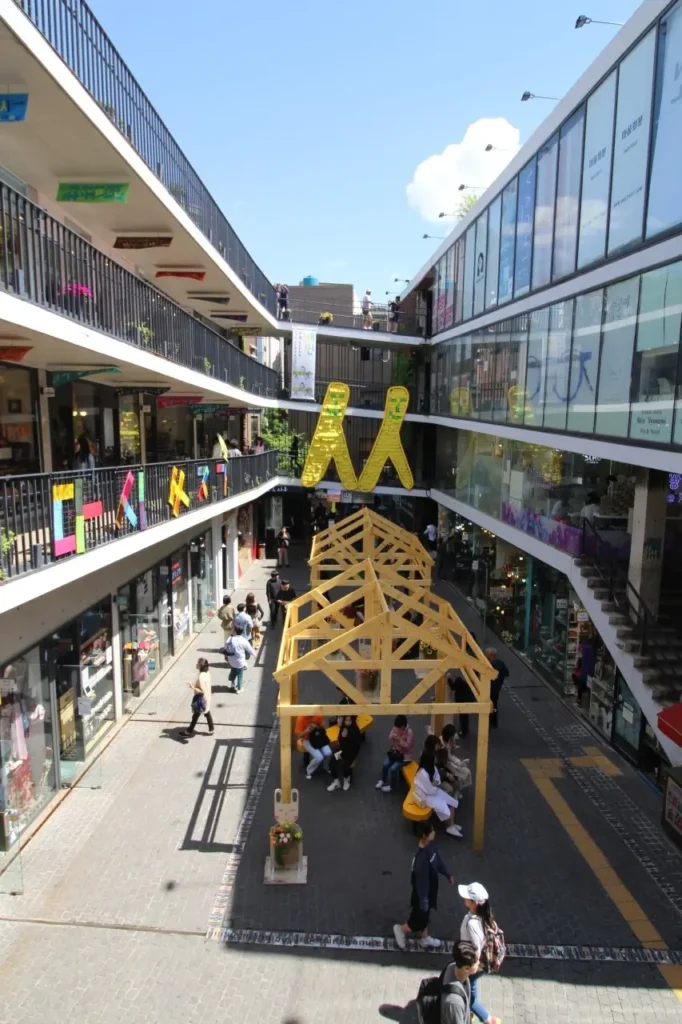

From the first to fourth floor, you’ll find workshops and craft stores showcasing contemporary interpretations of traditional Korean crafts. The spiral structure centered around an open courtyard, reaching toward the sky, is particularly impressive. The space harmoniously blends young artists’ unique works with traditional crafts, and hosts various cultural events weekly.
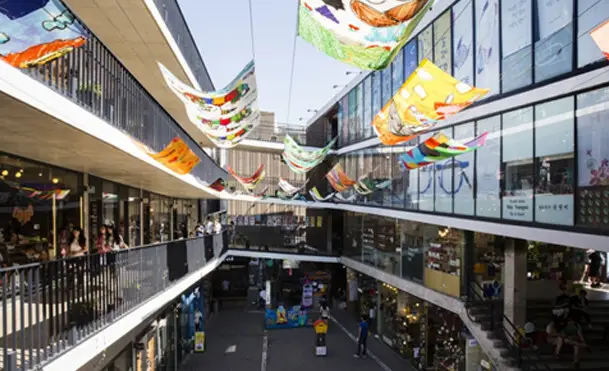

On weekends, you can enjoy small performances in the outdoor courtyard and sometimes participate in traditional craft workshops. Don’t forget to visit the rooftop garden for a panoramic view of Insadong street – it’s perfect for memorable photos. Also, treat yourself to a relaxing cup of tea at the traditional teahouse on the fourth floor.

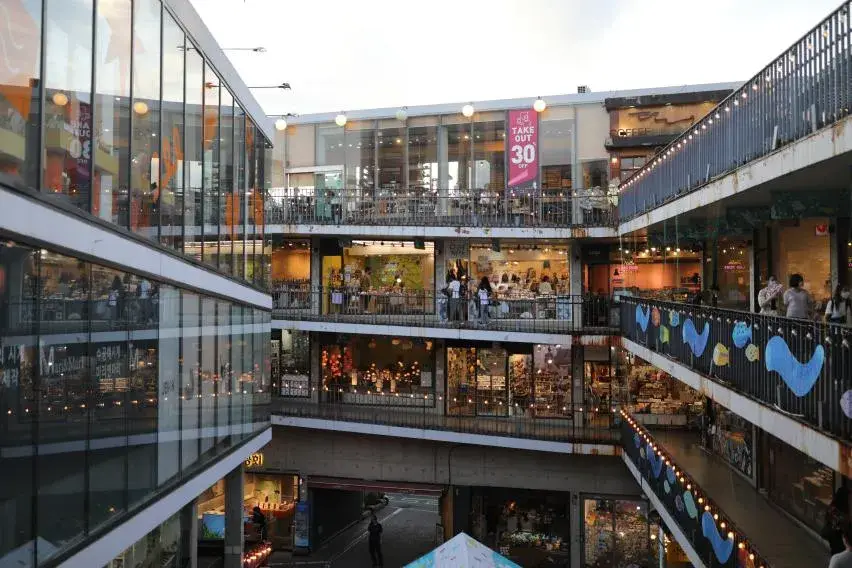
Enjoy Traditional Tea Houses
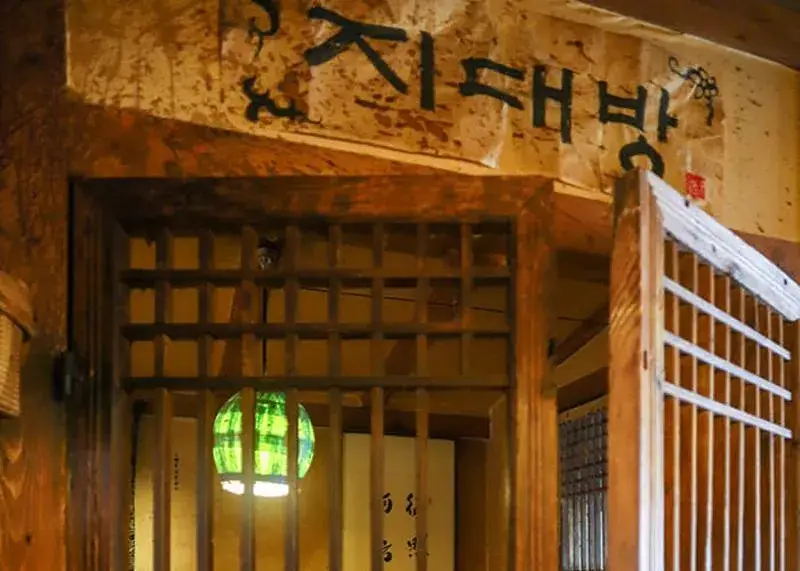
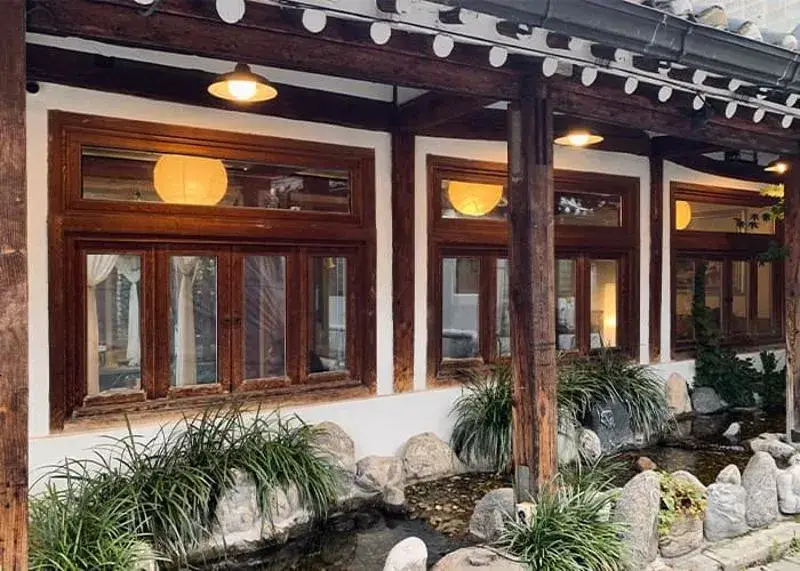

Tucked away in Insadong’s alleys are traditional tea houses where you can experience Korean tea culture. These tea houses, many converted from traditional hanok buildings, offer the perfect setting to savor the deep flavors and aromas of traditional Korean teas.
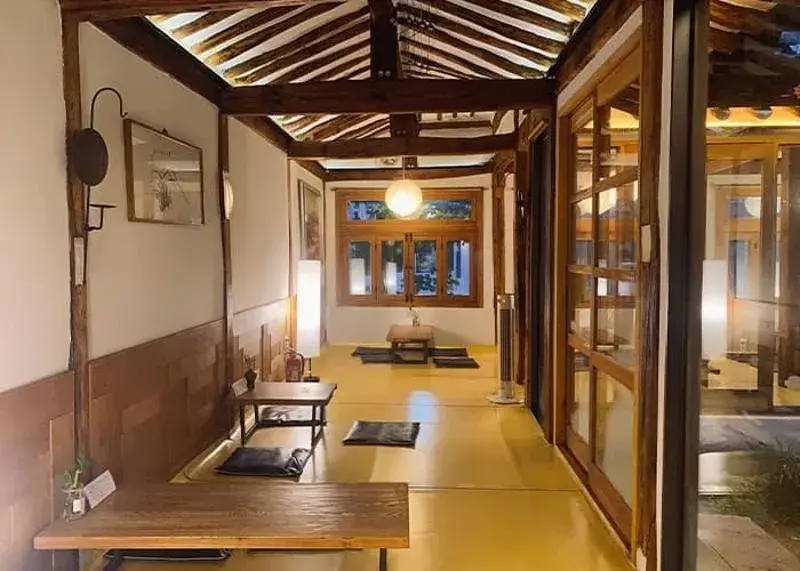
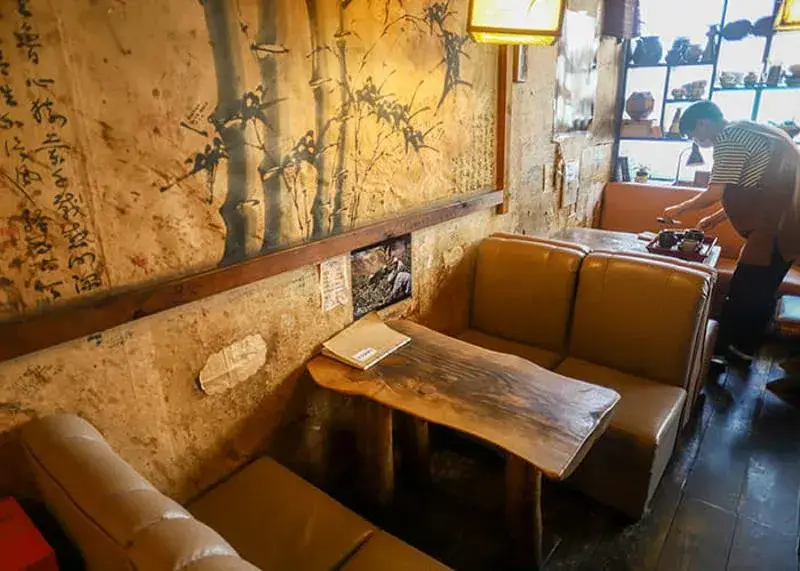

From classic options like Ssanghwa-cha (medicinal tea), Jujube tea, and Omija tea to seasonal specialties, there’s a wide variety to explore. The experience is particularly special in hanok tea houses, where you can watch tea being prepared in the traditional way. Enjoy your tea and traditional snacks under the soft sunlight filtering through hanji windows.
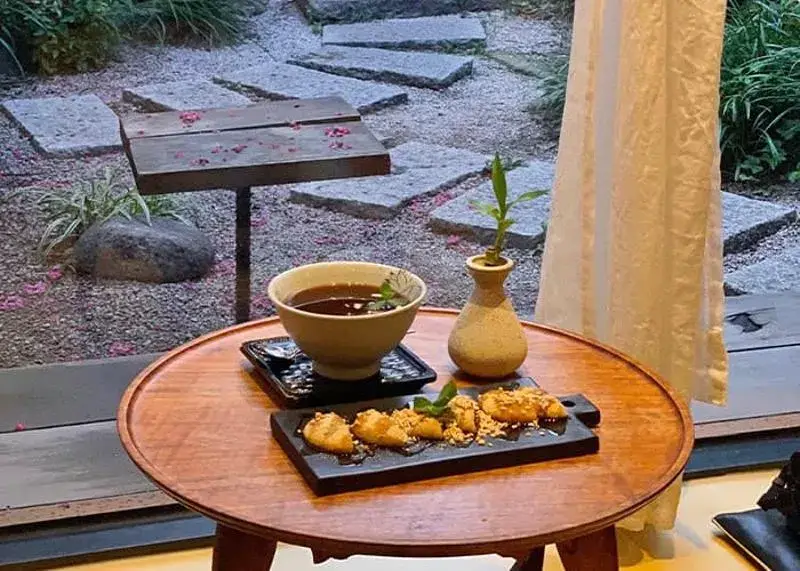
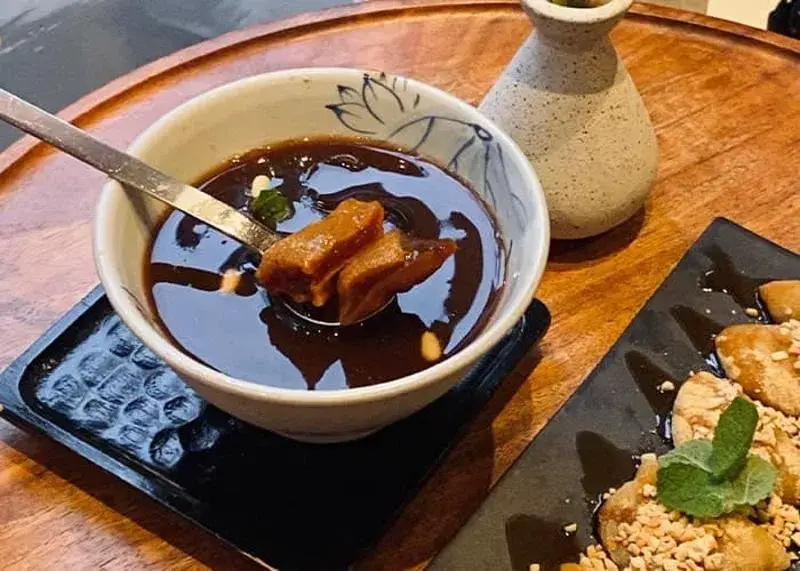
Each season brings its own special teas: cherry blossom tea in spring, lotus tea in summer, chrysanthemum tea in fall, and ginger tea in winter. Taking a moment to enjoy a cup of tea here offers a peaceful escape from the busy world.
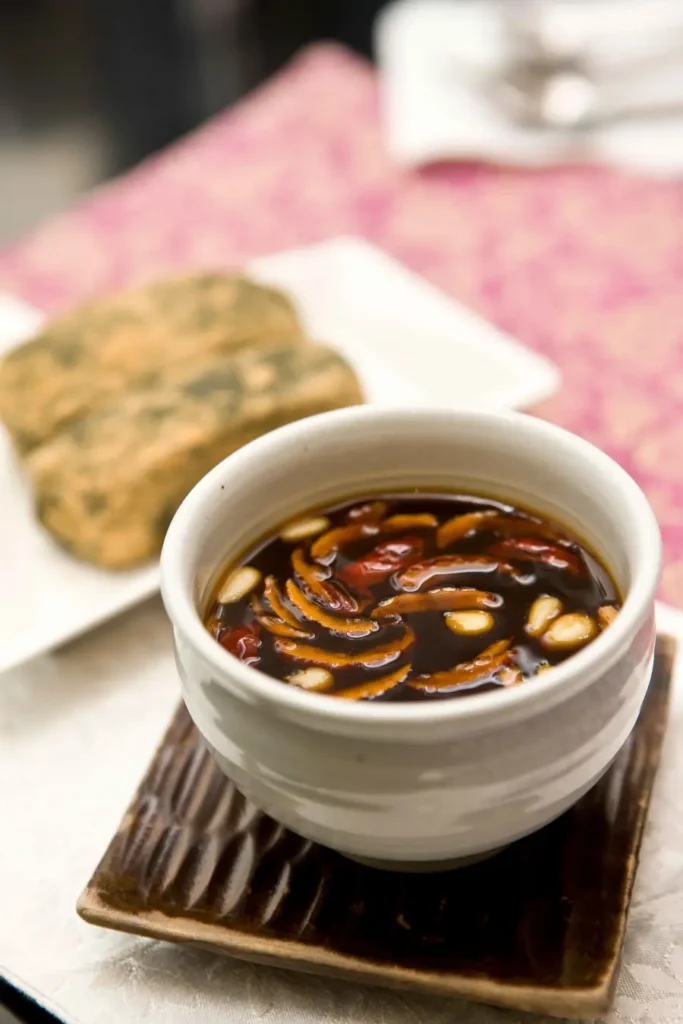
Here’s a list of recommended Tea houses to visit in Insadong.
Hanok Tea House
Hanok Tea House, located in Seoul’s Insadong, is a traditional tea house offering a warm and cozy atmosphere within a renovated hanok. Signature items include meticulously brewed traditional teas and various Korean desserts like dried persimmons and injeolmi (rice cakes), with seasonal offerings such as patbingsu (red bean shaved ice) and mango bingsu during summer.
Traditional Teahouse Insadong
Insadong Tea House, located in Seoul’s Insadong, is a traditional tea house where visitors can enjoy a variety of traditional Korean teas and snacks in a serene hanok setting. Signature offerings include Ssanghwa tea, citron tea, and jujube tea, often served with traditional Korean sweets, providing an authentic tea culture experience.
Sinyet chatjip (Shin Tea House)
Shin Yet Tea House, located in Seoul’s Insadong, is a traditional hanok tea house renovated from a 130-year-old residence, offering a serene atmosphere. Guests can enjoy a variety of traditional teas such as ssanghwa-cha, jujube tea, and omija tea, accompanied by snacks like injeolmi and hangwa, with the option to sit in warm ondol rooms.
Namusae Tea house
Namu Sae Tea House, located in Seoul’s Insadong, is a traditional hanok café offering a serene atmosphere to enjoy a variety of traditional teas and snacks. Signature items include the special ssanghwa tea and sweet red bean porridge, with the traditional red bean shaved ice also being popular. The interior features both floor seating and table seating areas, allowing guests to choose according to their preference.
Try on Hanbok
Insadong has numerous hanbok rental shops where you can experience wearing Korea’s traditional attire. Take a stroll through the streets in beautiful hanbok, and capture special photos against the backdrop of traditional hanok buildings and quiet alleyways. Most rental shops provide hair accessories and bags to complete your traditional look.
Hanbok is available in various sizes and designs to suit everyone, regardless of age or gender. Recently, modern interpretations of hanbok (called ‘lifestyle hanbok’) have become popular, especially among foreign tourists, as they’re lighter and easier to move in.
When wearing hanbok, you can enjoy free admission to nearby Gyeongbokgung Palace and Changdeokgung Palace, making it a perfect opportunity to combine hanbok experience with palace tours. Many rental shops also offer hair styling services to help you achieve the perfect traditional Korean look.
Explore Traditional Crafts

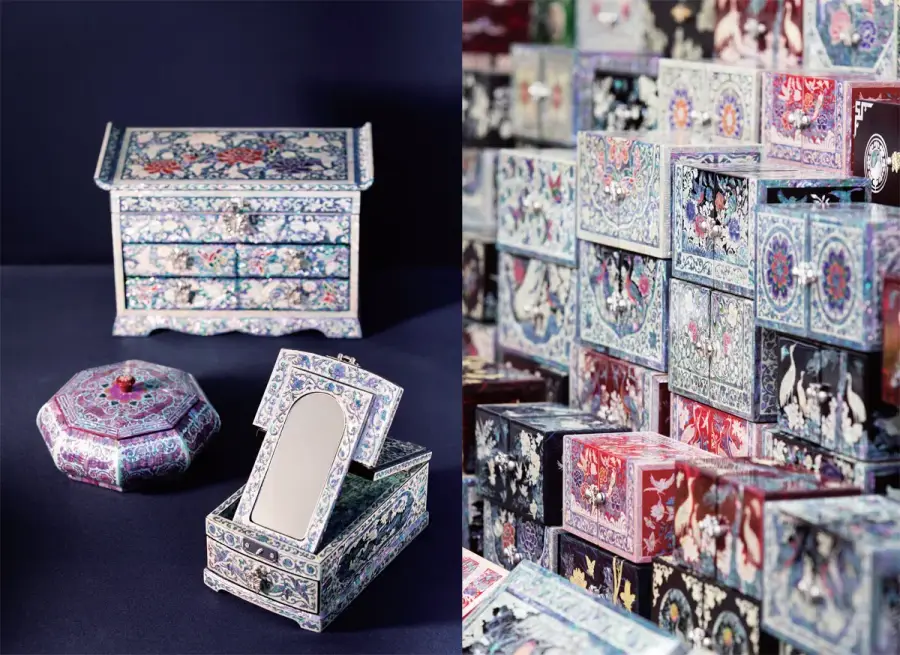
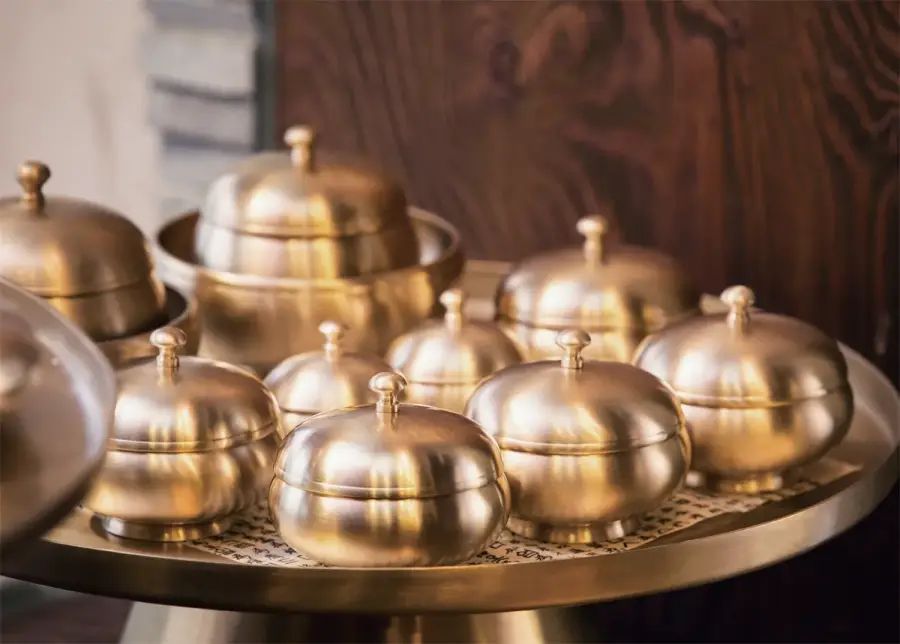
Insadong is lined with workshops and stores where you can discover Korean traditional crafts. From centuries-old pottery to intricate mother-of-pearl inlay work and elaborate embroidery, you’ll find a wide range of craftwork. Products made from hanji (traditional Korean paper) are particularly popular, offering both practicality and beauty. Traditional jewelry and accessories reinterpreted with a modern touch make perfect souvenirs.
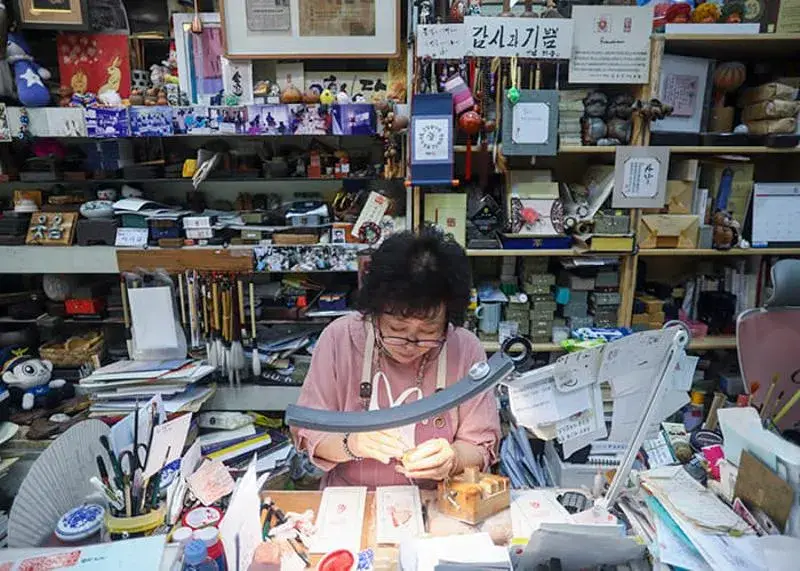


In the workshops, you can watch master artisans at work. From the delicate brushstrokes of blue-and-white porcelain artists to the precise handiwork of hanji craftsmen and the focused gaze of mother-of-pearl inlay masters – all these represent living traditions you can encounter in Insadong. Recently, you can also find works by young craftspeople offering modern interpretations of traditional techniques.
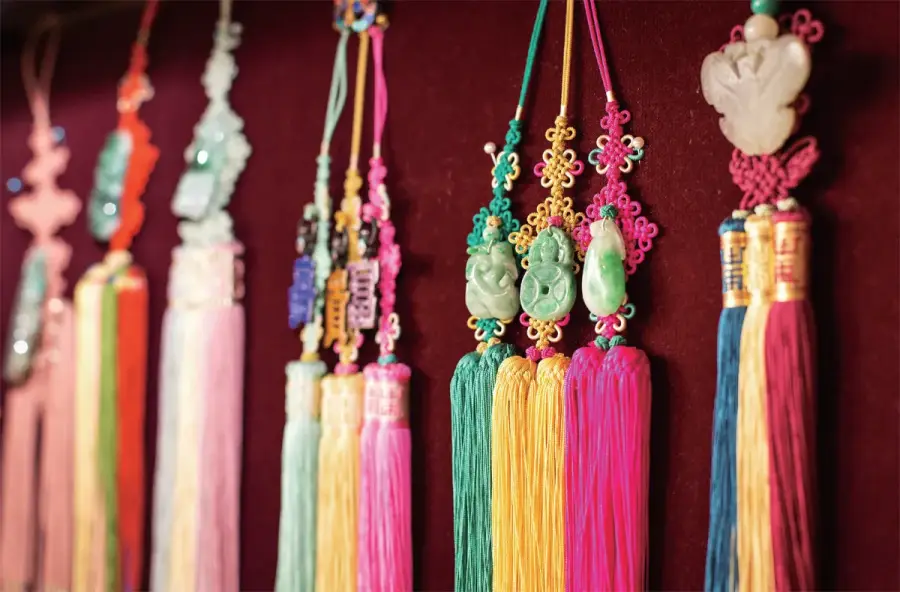
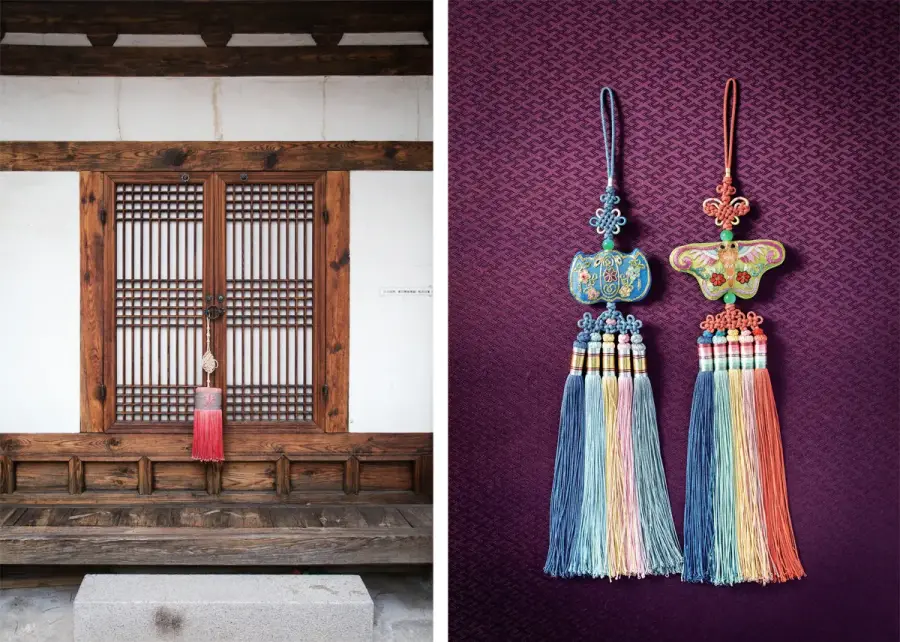
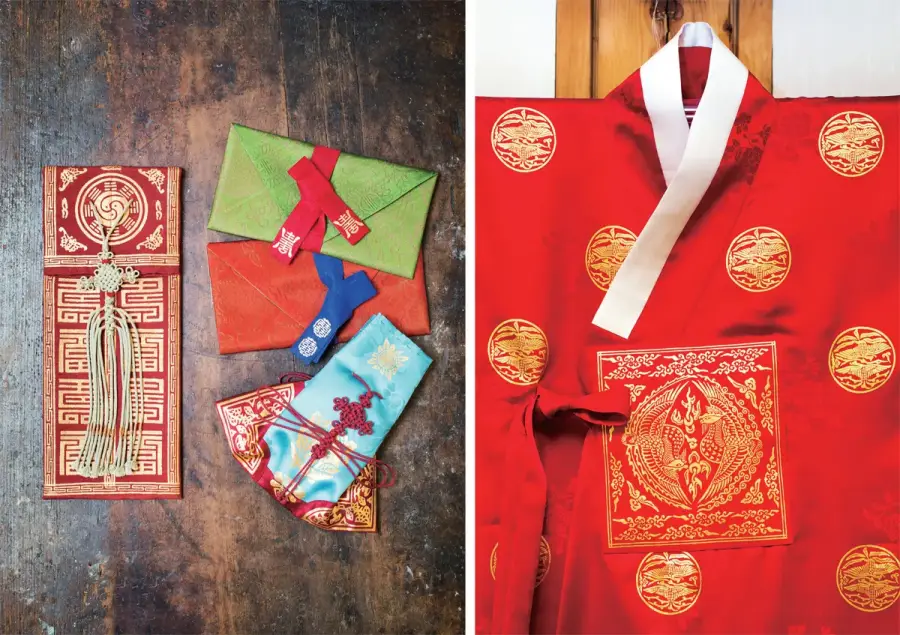
Some workshops offer hands-on programs where you can try creating traditional crafts yourself. You can try making hanji, simple pottery, or traditional knots through various programs. You can take your handmade pieces home as special souvenirs.
Here’s a list of recommended Traditional Crafts to visit in Insadong.
Woorimi
Ourimi, located in Insadong, Seoul, is a traditional craft shop offering elegant Korean handmade crafts and vintage items. Popular products include norigae (traditional ornaments), mother-of-pearl boxes, and hand-embroidered pouches, attracting many international visitors.
Jungang Craft Center
Joongang Craft Souvenir Shop, located in Seoul’s Insadong, is a traditional craft store with over 40 years of history. They offer a variety of Korean traditional crafts at reasonable prices, including mother-of-pearl jewelry boxes, lacquerware business card cases, and traditional fans. The store is situated at 17 Insadong-gil, easily accessible from Anguk Station (Line 3), Exit 6.
Gallery Tour Experience

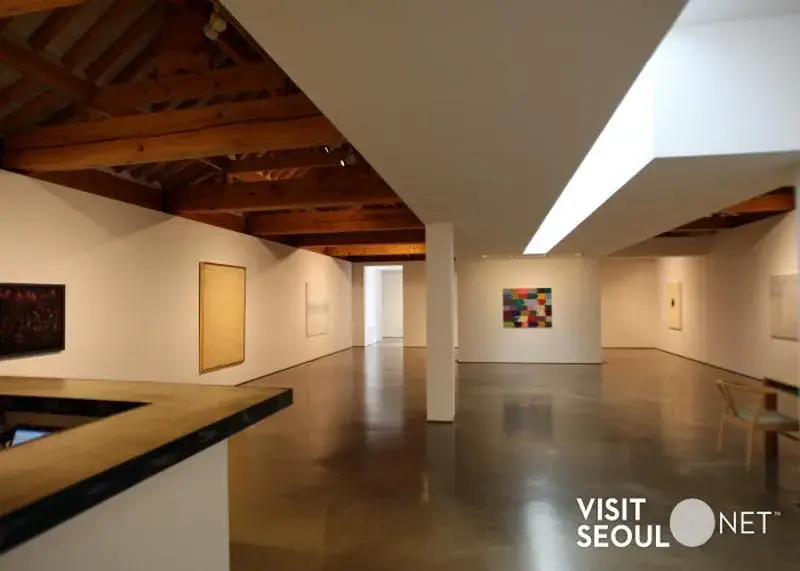
Insadong is the heart of Korean art, home to over 100 galleries. You can appreciate various genres from traditional to contemporary art. Most galleries offer free admission on weekends. From exhibitions by famous artists to experimental works by emerging artists, you can experience the past, present, and future of Korean art in one place.

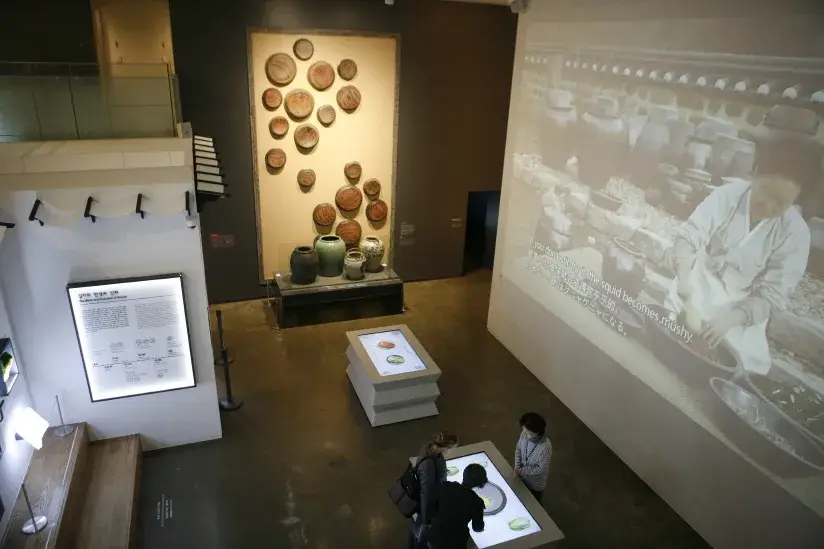
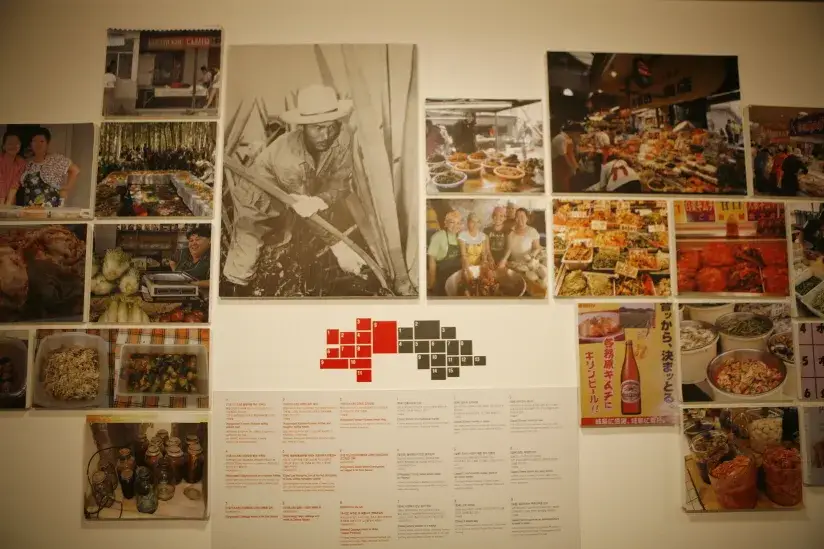
Each gallery curates unique exhibitions, making a full day of gallery hopping consistently engaging. Most galleries also sell exhibition catalogs and art merchandise. Many venues offer works by young artists at reasonable prices, making it exciting to discover collectible pieces.

Sample Traditional Food

Insadong is home to many restaurants serving traditional Korean cuisine. You can enjoy authentic versions of representative Korean dishes like bibimbap, samgyetang (ginseng chicken soup), and hanjeongsik (Korean table d’hôte).
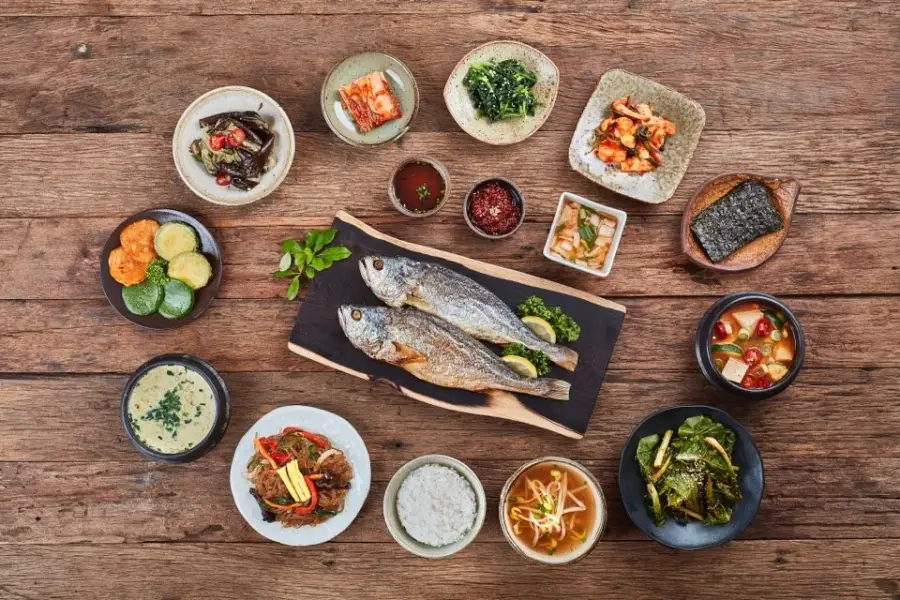
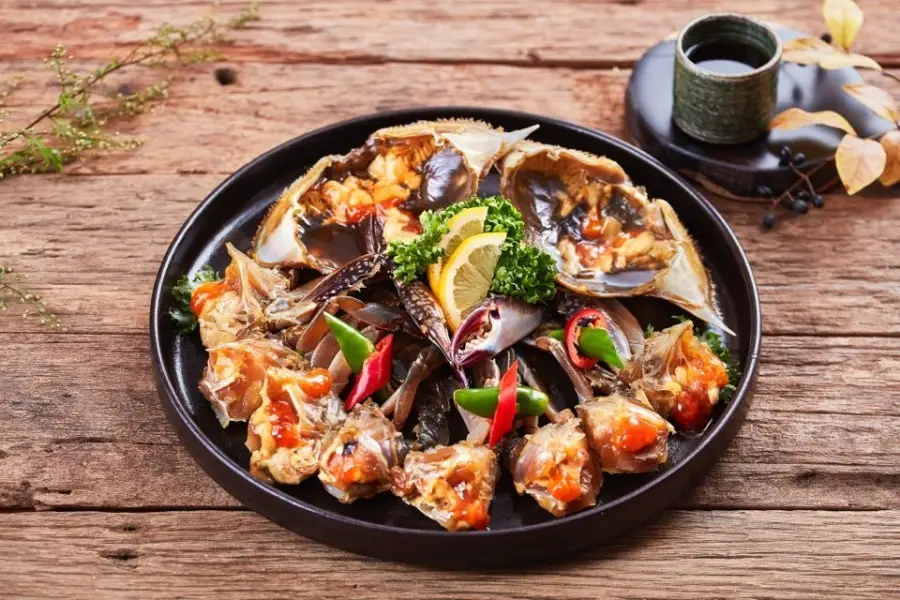


Restaurants housed in converted hanok buildings offer elegant traditional Korean course meals. The traditionally arranged table settings and refined dishes provide a feast for both eyes and palate.

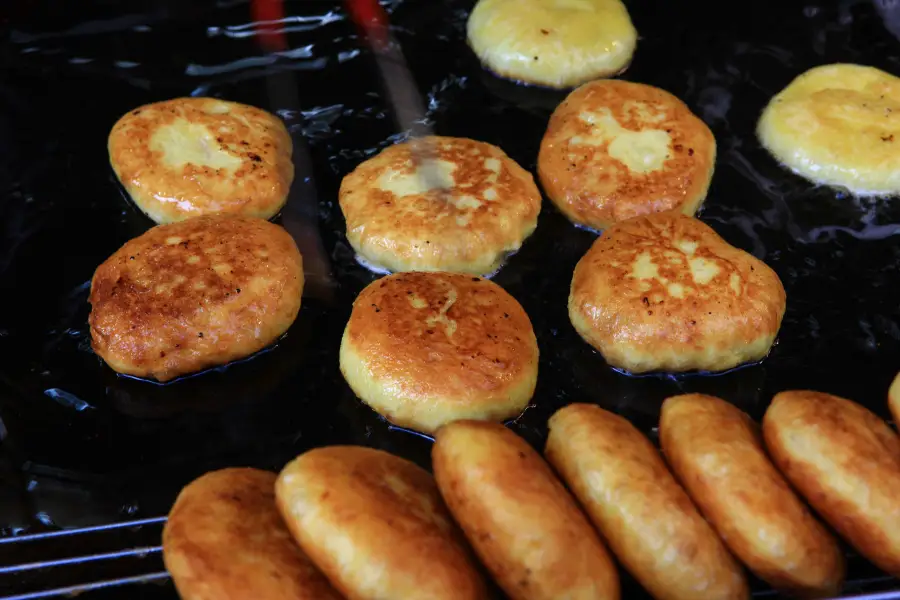
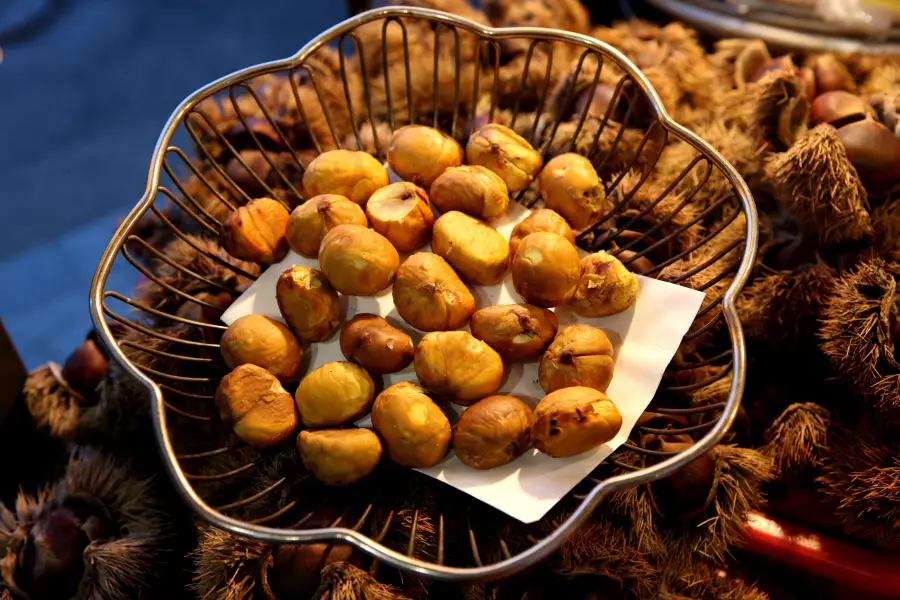
Don’t miss the street food either. Snacks like hotteok (sweet filled pancakes), taraegwa (traditional twisted cookies), and roasted sweet potatoes are perfect for enjoying while walking. Be sure to try Insadong’s special dessert, ‘twisted bread ice cream’ – this sweet combination of traditional pastry and ice cream is a unique treat you can only experience in Insadong.
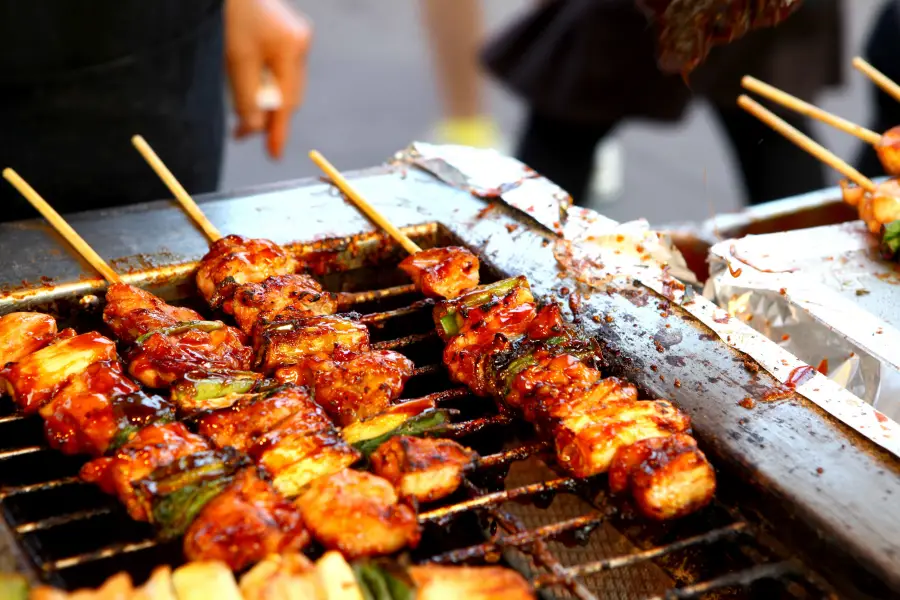
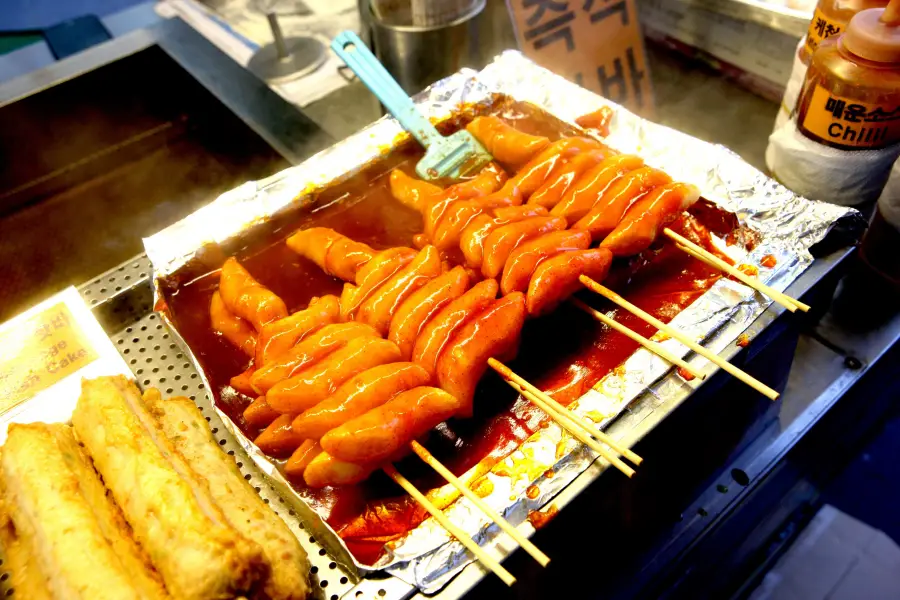
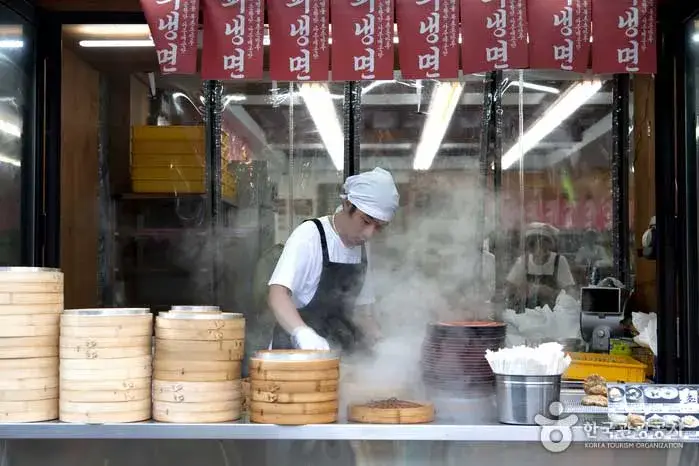
Here’s a list of recommended restaurants to visit in Insadong.
Choe Daegam’s
Choi Daegamne is a hanok-style Korean restaurant located in Seoul’s Insadong, offering a variety of traditional Korean dishes in an authentic setting. Signature dishes include bulgogi and lotus leaf rice, with a selection of refined set menus prepared from fresh ingredients. The spacious garden featuring a waterwheel provides a charming atmosphere, making it suitable for family gatherings or date spots.
Doma Insadong
Doma Insadong Branch is a modernized Korean hot pot restaurant, best known for its galbi hot pot rice and Iberico pork neck charcoal grill. It offers a wide selection of meticulously prepared Korean dishes with fresh ingredients.
Insadong Maneul Bossam
Insadong Garlic Bossam is a Korean restaurant located in Seoul’s Insadong, renowned for its tender bossam served with a flavorful garlic sauce. Signature dishes include garlic bossam and buchu (chive) pancake, which pair well with chestnut makgeolli. The traditional hanok-style interior offers a comfortable dining experience.
Visit Traditional Stationery Stores
Insadong is also famous as a mecca for traditional calligraphy and the Four Treasures of the Study. In long-established stationery stores, you can find premium brushes, hanji, and ink sticks. Some shops that have maintained their presence for decades offer high-quality brushes made by master craftsmen. Each brush is meticulously handcrafted, making them works of art in themselves.
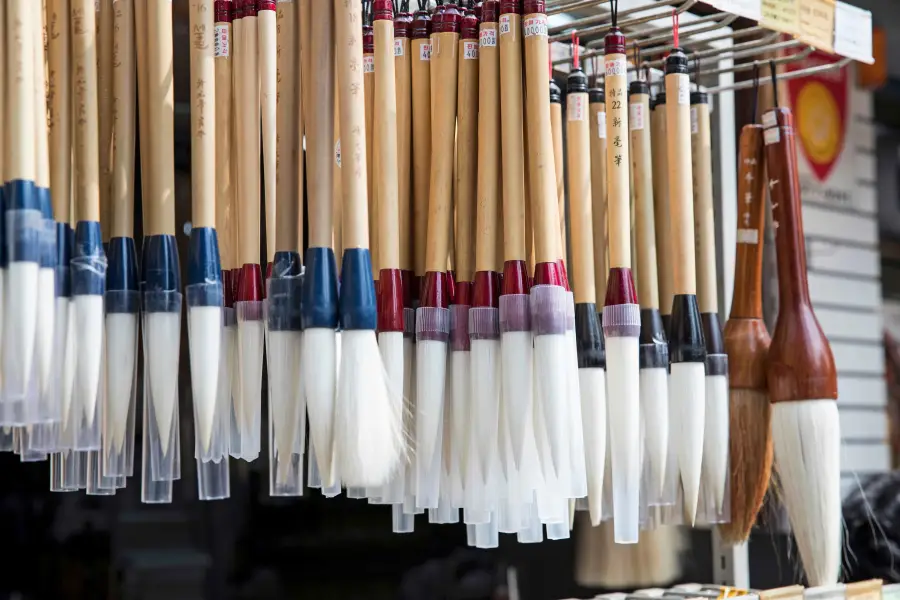

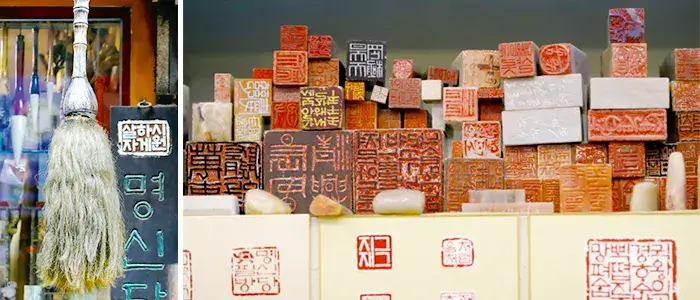
You can see and touch various types and textures of hanji. Traditional hanji is said to last for a thousand years without deteriorating. You can also find traditional seal stamps with cultural patterns and other scholar’s tools like ink sticks and inkstones. These traditional stationery items are popular as special souvenirs.

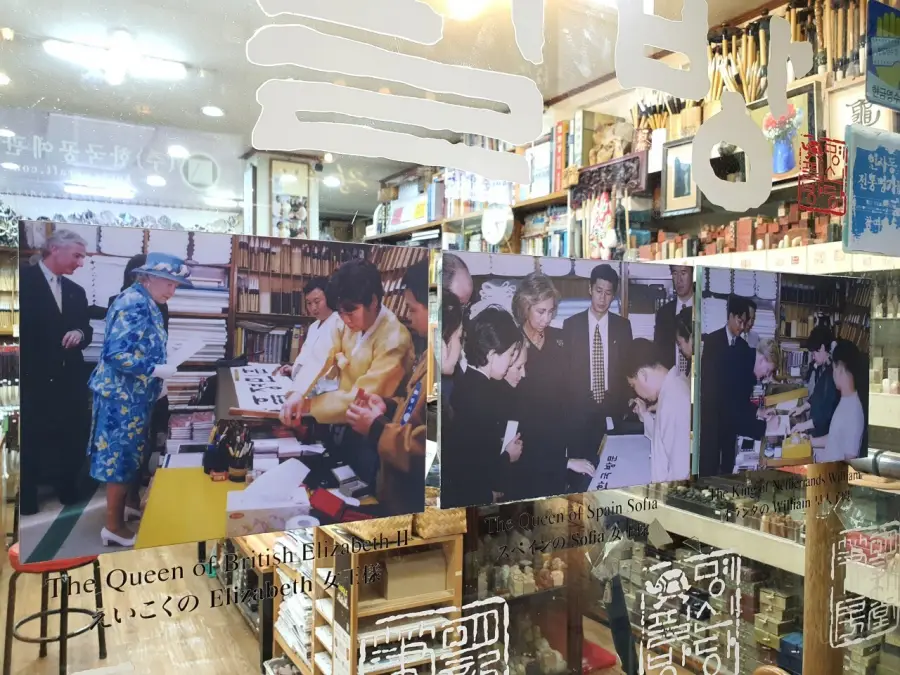
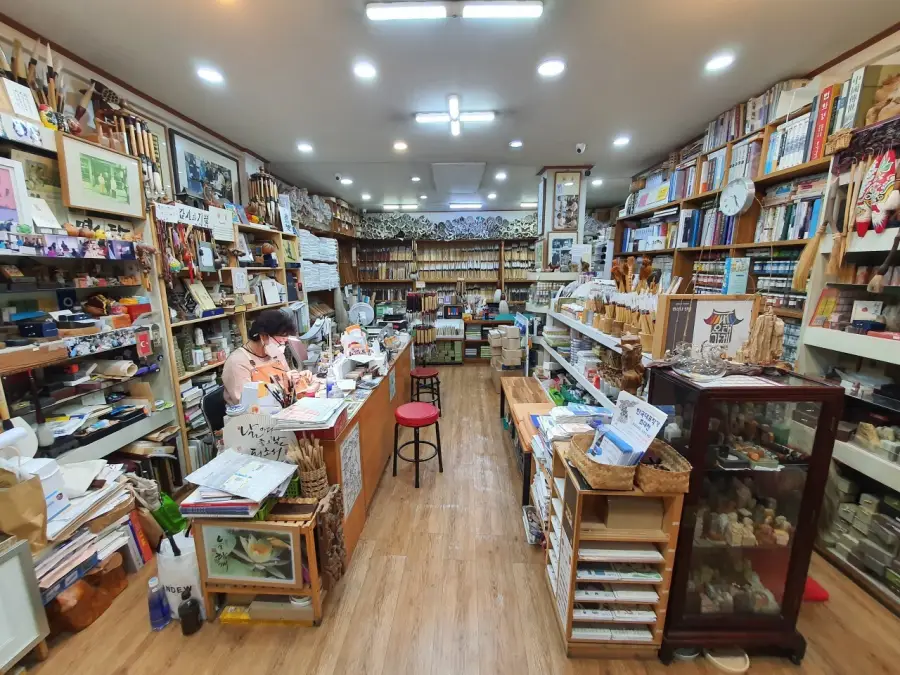
Browse Antique Shops
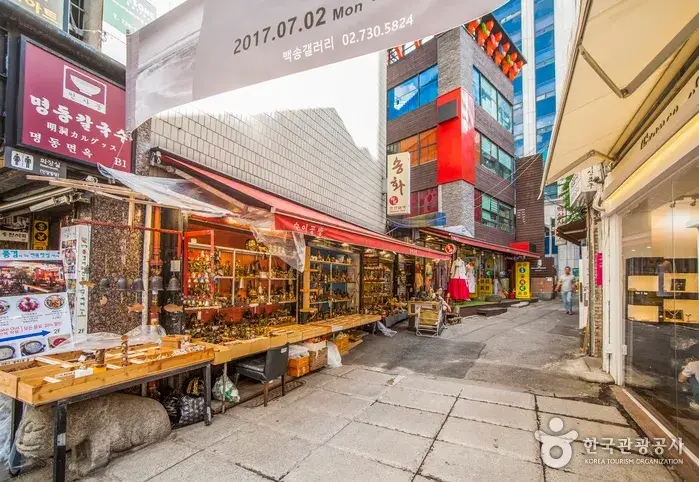

Insadong’s antique shops are filled with treasures that carry traces of time. You can explore antiques from various periods, from the Joseon Dynasty to the modern era. The displays include everything from blue-and-white porcelain and buncheong celadon to folk crafts and traditional furniture.
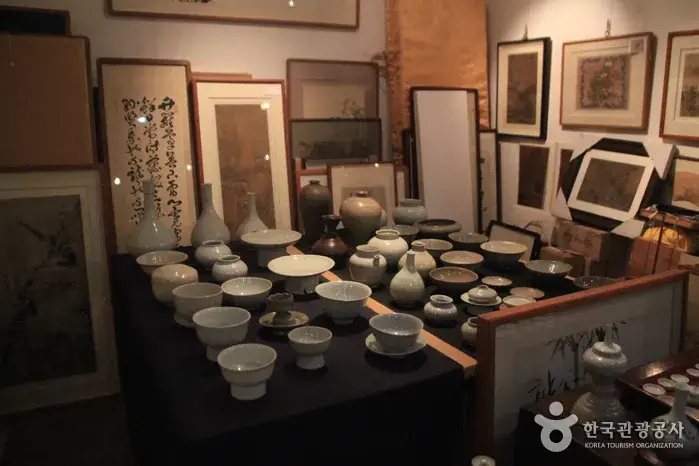
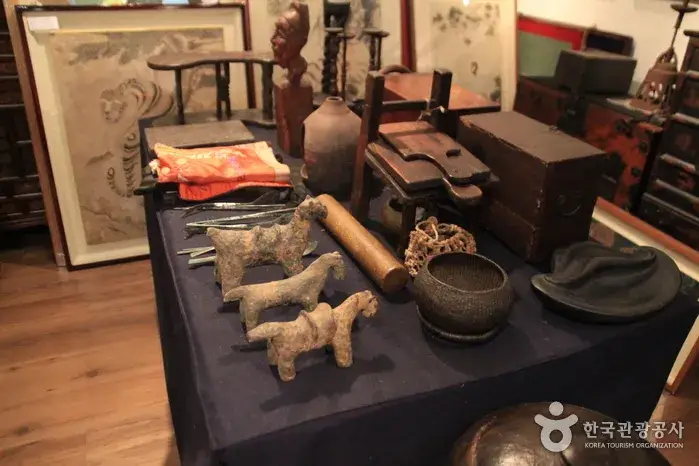
These items are carefully selected by experts, and each piece holds historical value. As you explore the antique shops, you’ll naturally learn about Korean history and culture. You can find items across various price ranges, from small decorative pieces to high-end artworks, making it possible to find something special that matches your taste and budget.


Experience Insadong Maru

Located in the heart of Insadong, ‘Insadong Maru’ is a cultural complex where you can experience Korean culture reinterpreted with a modern touch. The venue regularly hosts traditional cultural experience programs and performances. You can enjoy everything from traditional craft workshops to Korean traditional music performances.

The basement performance hall features traditional Korean music concerts every weekend. You can take special photos at photo zones throughout the building and enjoy a panoramic view of Insadong from the rooftop garden. It’s a place where you can experience Korean culture reimagined with contemporary sensibilities.

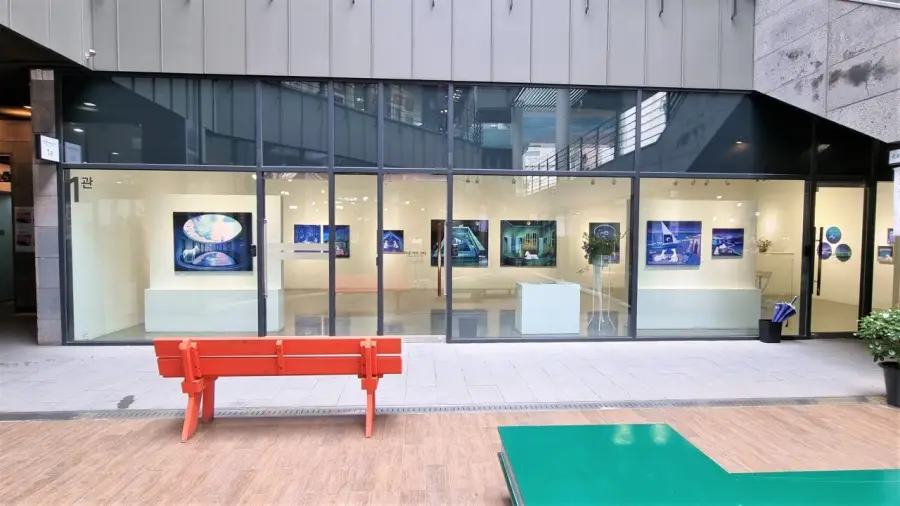
Visit Traditional Bars
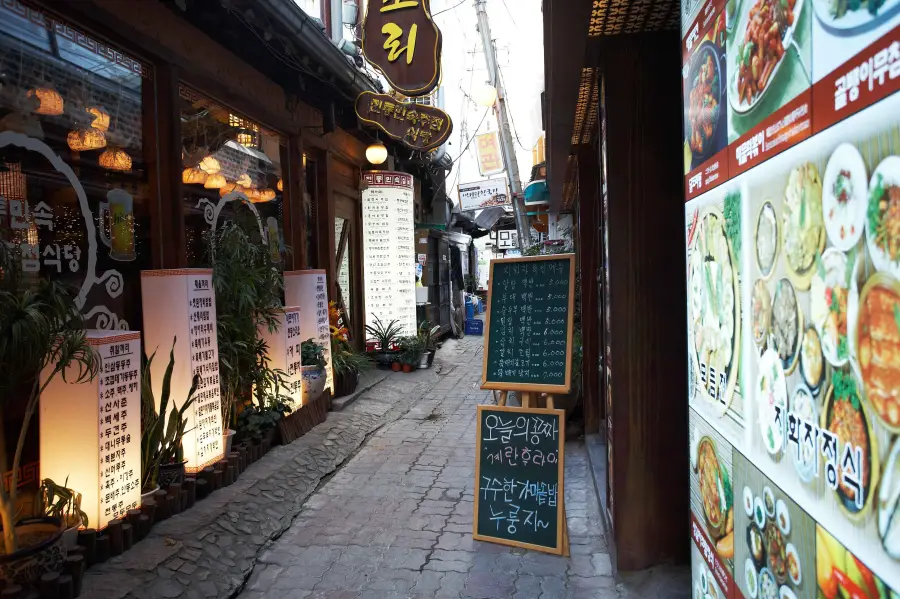
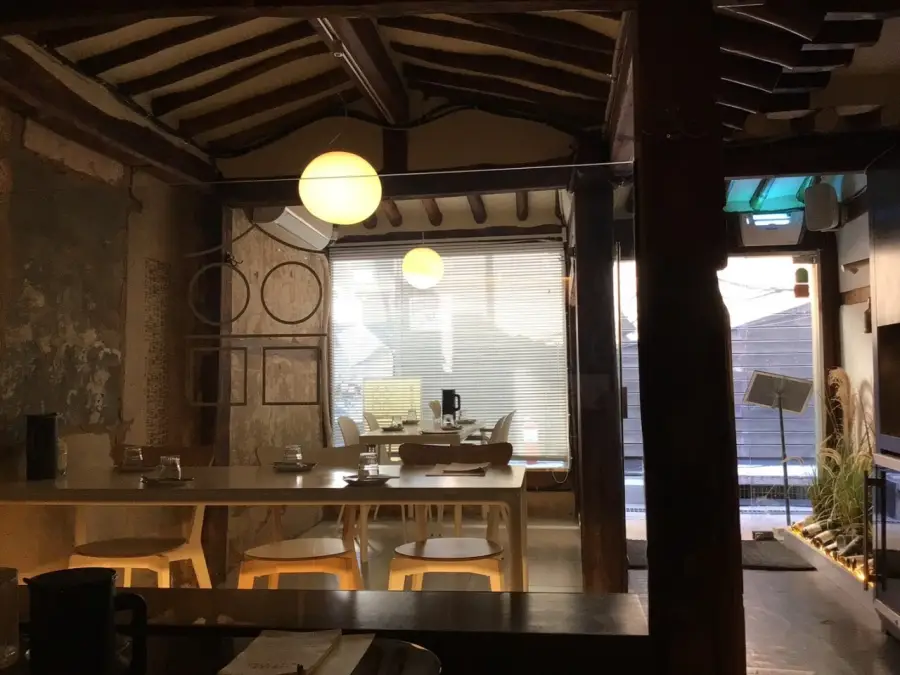
As the sun sets, Insadong’s alleys come alive with traditional bars. Establishments serving makgeolli (rice wine) and traditional Korean alcohol create a unique atmosphere. Bars housed in converted traditional buildings offer a variety of Korean traditional alcoholic beverages, with many specializing in regional makgeolli and traditional liquors.


The traditional food served as accompaniments is also special. Korean pancakes like pajeon, kimchijeon, and dubu kimchi (kimchi with tofu) are popular among foreign visitors. Some bars offer explanations of traditional alcohol-making processes and tasting programs, allowing you to gain a deeper understanding of Korean drinking culture.

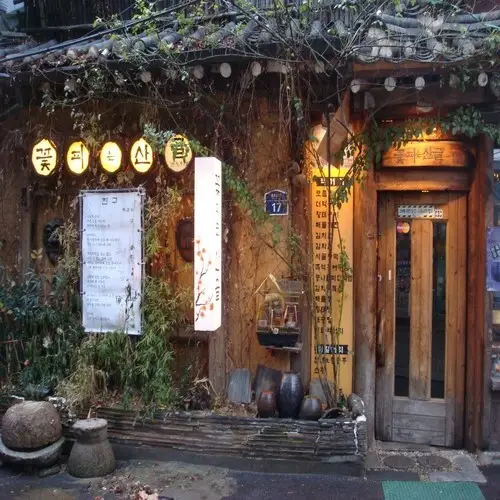
Here’s a list of recommended Traditional Bars to visit in Insadong.
TteokSang
Tteoksang is a hanok-style pub located in Seoul’s Insadong, offering a variety of tteokbokki dishes and highballs. Signature dishes include chadolbagi tteokbokki and seafood buchu jeon, all served in a comfortable traditional hanok interior.
Kkotpineun Sangol
Kkotpineun Sangol is a traditional Korean pub located in Seoul’s Insadong, offering a variety of jeon (Korean pancakes) and makgeolli (rice wine) in an authentic hanok setting. Signature dishes include minari (water parsley) jeon and gamja (potato) jeon, paired with a selection of traditional liquors. The interior is adorned with vintage items, creating a cozy and nostalgic atmosphere.
Enjoy Evening Walks
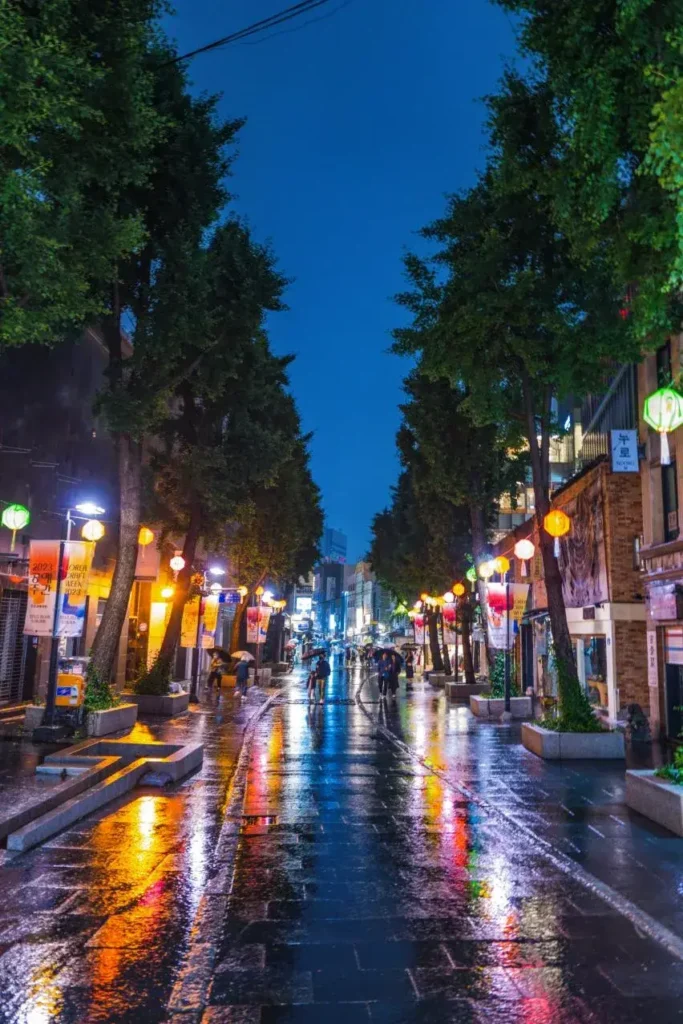
Insadong reveals different charms at dusk. The streets decorated with traditional lanterns create a soft, romantic atmosphere. The night view created by the harmonious lighting of Ssamziegil and surrounding shops offers a different kind of enchantment from daytime.
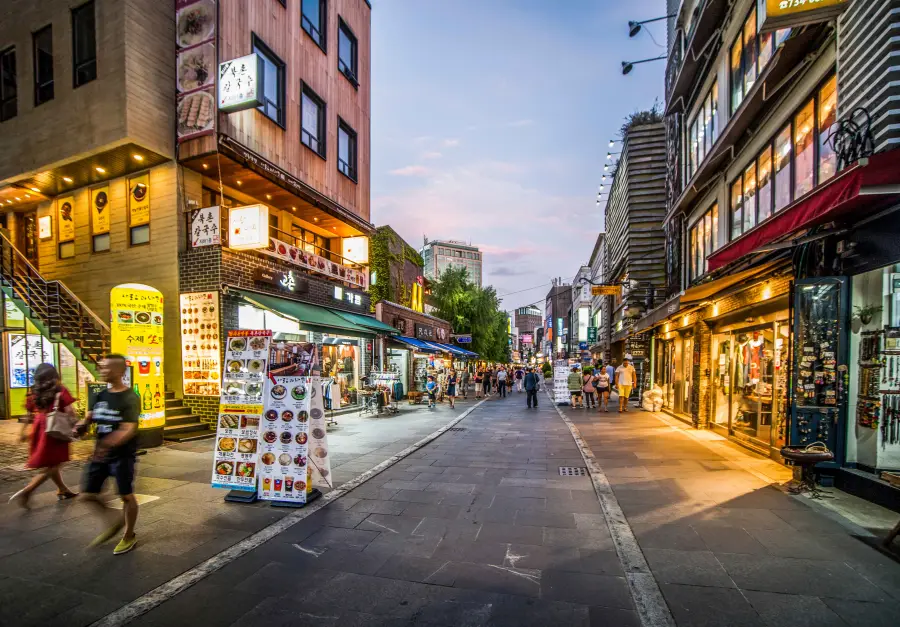
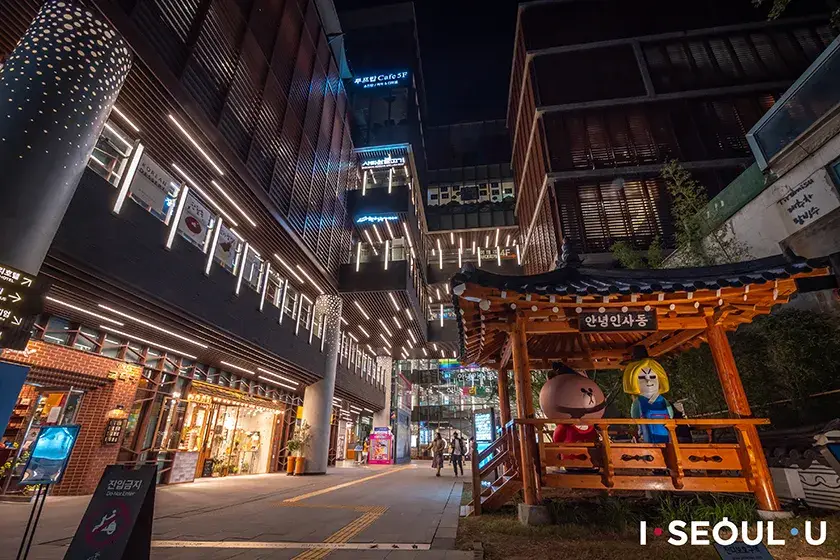
Taking an evening walk accompanied by street performers’ music will create special memories. As most tourists leave in the evening, you can enjoy the quieter streets at your own pace. The tranquil streetscape under subtle lighting will leave you with unforgettable memories.

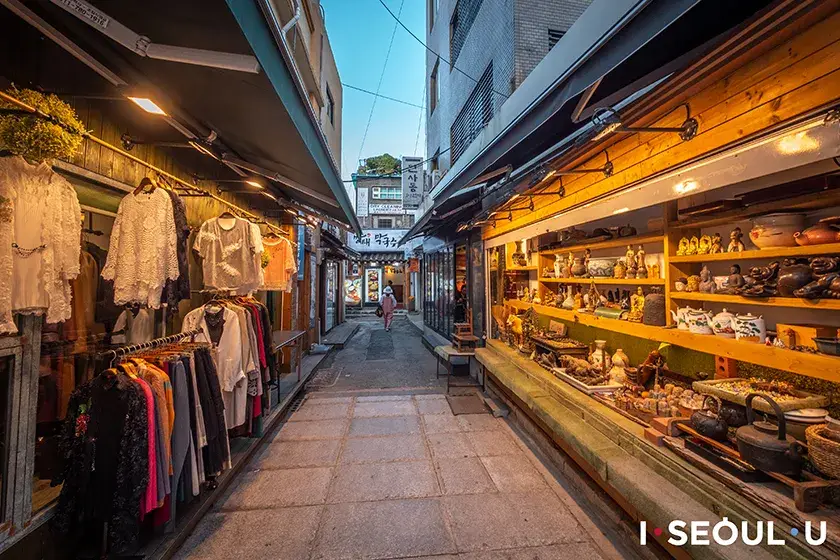
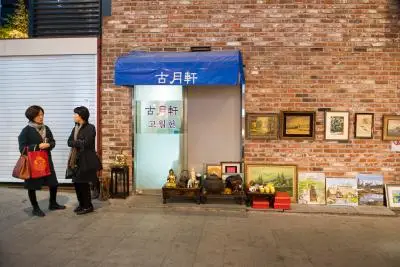
Insider Tips for
Insadong Like a Local
- Visit on Weekend Mornings
- Explore the Hidden Alleys
- Avoid Peak Lunch Hours
- Take Advantage of Cultural Experience Programs
- Compare Prices While Shopping
Visit on Weekend Mornings
For the best Insadong experience, we recommend visiting on weekend mornings. Especially between 10-11 AM on Saturdays, when shops are just opening, you can explore at a leisurely pace. Before the tourist crowds arrive, you can enjoy a peaceful walk and soak in Insadong’s morning atmosphere.

During this time, you can watch artisans opening their shops and preparing for the day. It’s also a great time to browse and chat with shopkeepers in a calm environment.

Explore the Hidden Alleys
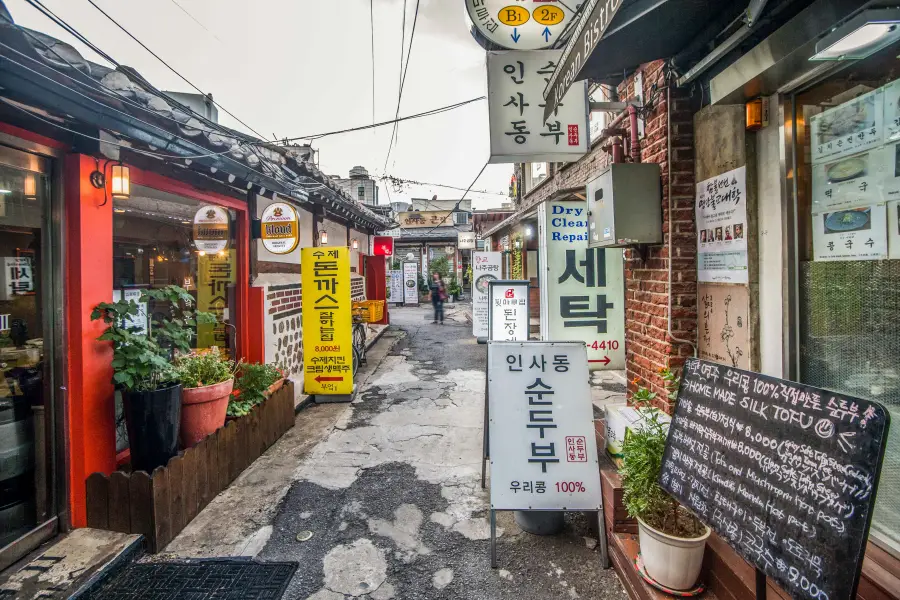
The real charm of Insadong lies hidden in the back alleys, not on the main street. Venture off the main road into the winding side streets. You’ll discover old antique shops, charming craft workshops, and cozy tea houses. Particularly behind Ssamziegil, you’ll find local-favorite restaurants and small artist workshops known only to residents. Even if you feel a bit lost, that’s part of the authentic Insadong experience!
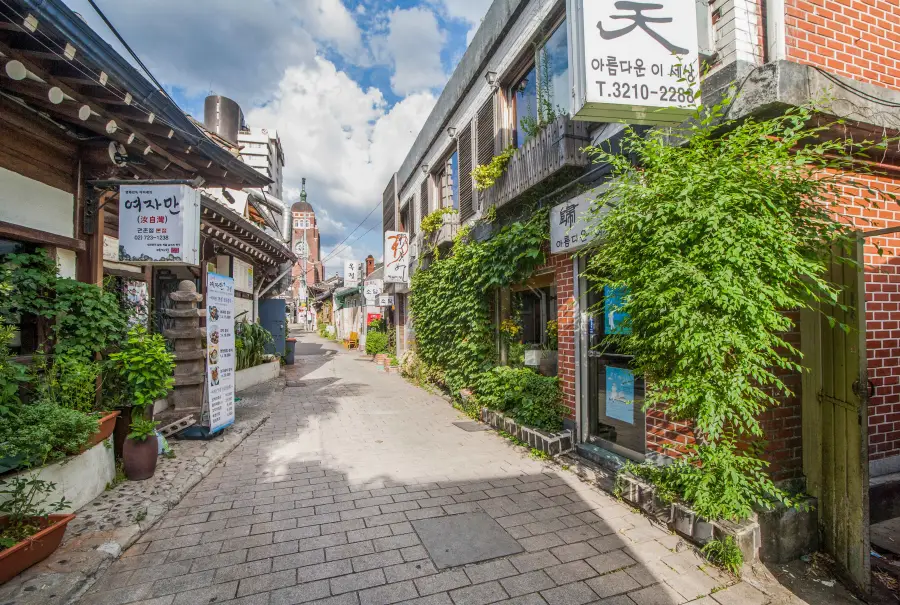
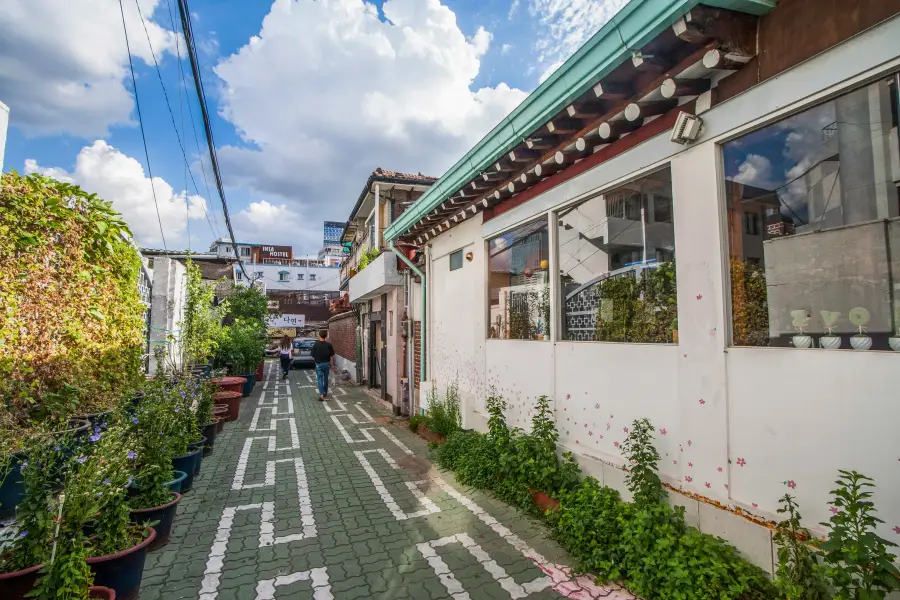
Avoid Peak Lunch Hours

Insadong’s popular restaurants get very crowded during lunch hour (12-1 PM). To avoid long wait times, we recommend dining either before 11:30 AM or after 2 PM. Many traditional Korean restaurants (hanjeongsik) require reservations, so it’s best to book popular places a day in advance. By avoiding peak hours, you can enjoy your meal more comfortably.


Take Advantage of Cultural Experience Programs
Many workshops and cultural facilities in Insadong offer special cultural experience programs for foreign visitors. These include trying on hanbok, learning traditional tea etiquette, pottery making, and Korean calligraphy.

Most programs are available in English, so don’t worry about language barriers. We recommend stopping by the Korea Tourism Organization’s Insadong Tourist Information Center, where they can introduce you to free programs as well.
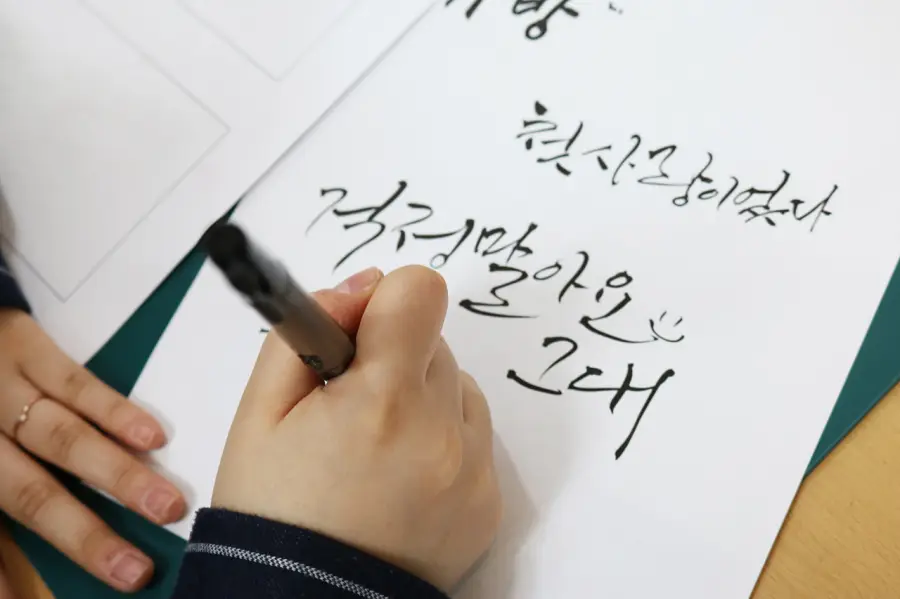
Compare Prices While Shopping
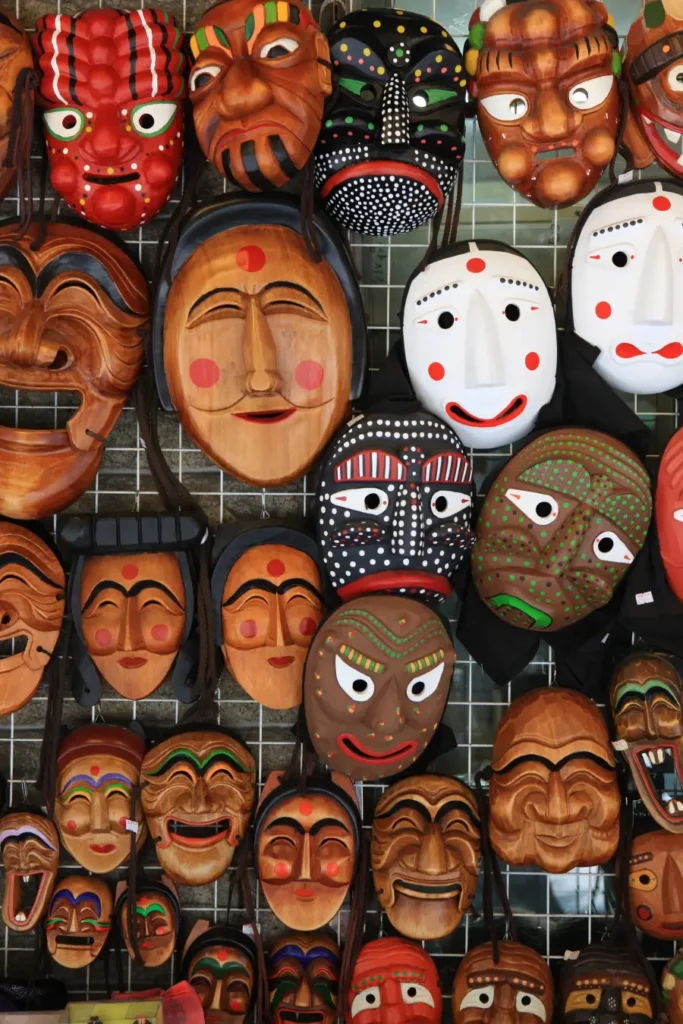
Many shops in Insadong sell similar items. Especially for souvenirs and traditional crafts, prices and quality can vary between stores. Instead of buying at the first shop you see, take time to browse multiple stores and compare.
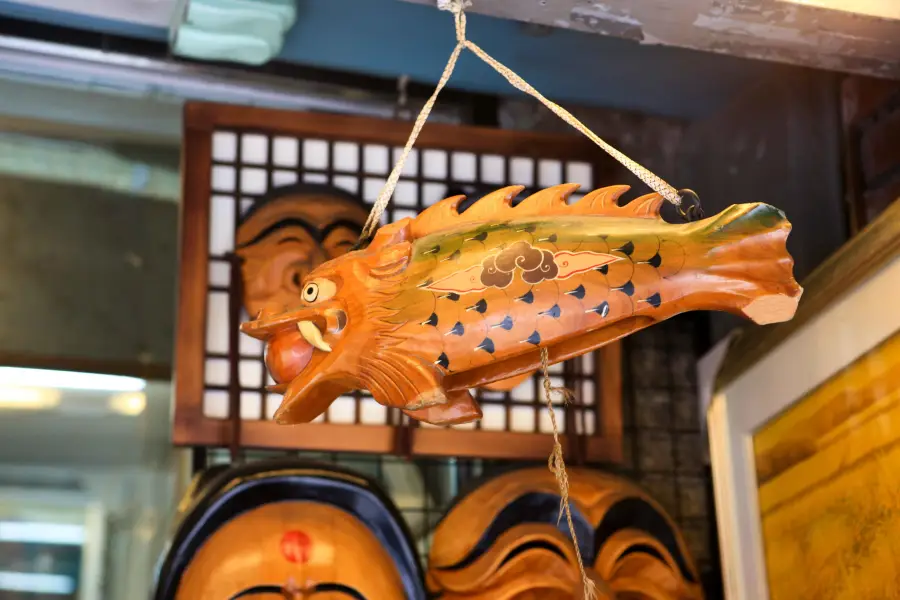

It’s good to check prices at Ssamziegil and the main street first, then compare with shops in the back alleys. Generally, stores deeper in the alleys tend to offer more reasonable prices.


Is Insadong
Worth Visiting?
Come Visit Insadong,
Where Seoul’s Traditional Culture Lives and Breathes
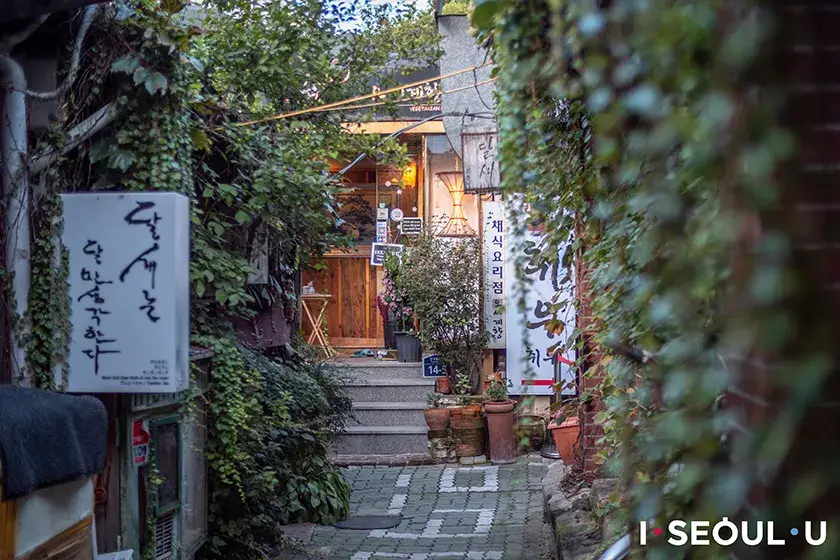
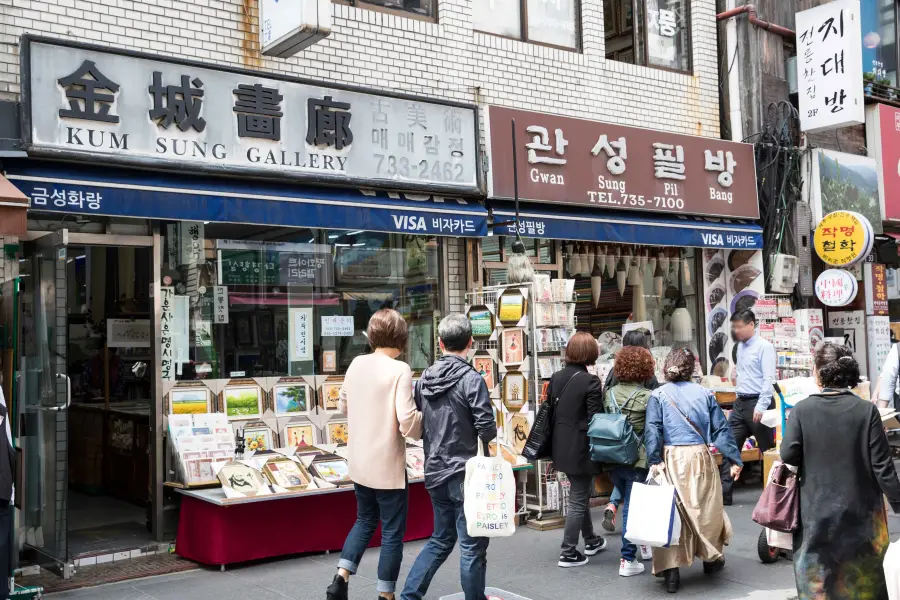
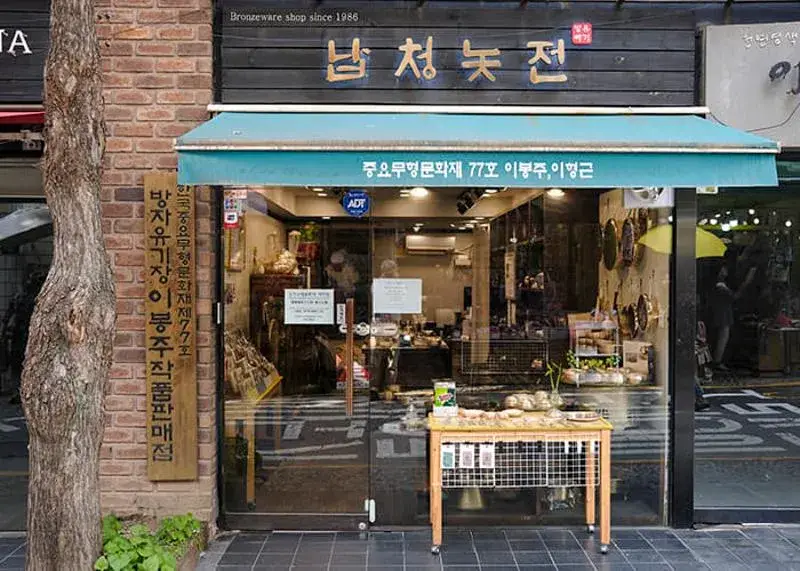
Come visit Insadong, where Seoul’s traditional culture lives and breathes. As you stroll through the tranquil alleys where time seems to stand still, your heart will warm to the unique scenery found right in the center of modern Seoul. From handcrafted items touched by master artisans’ devoted hands, to traditional teas wafting subtle fragrances, to the refined taste of Korean cuisine, and above all, the friendly merchants who share stories behind it all – Insadong is not just a tourist destination, but a living museum of Korean culture.

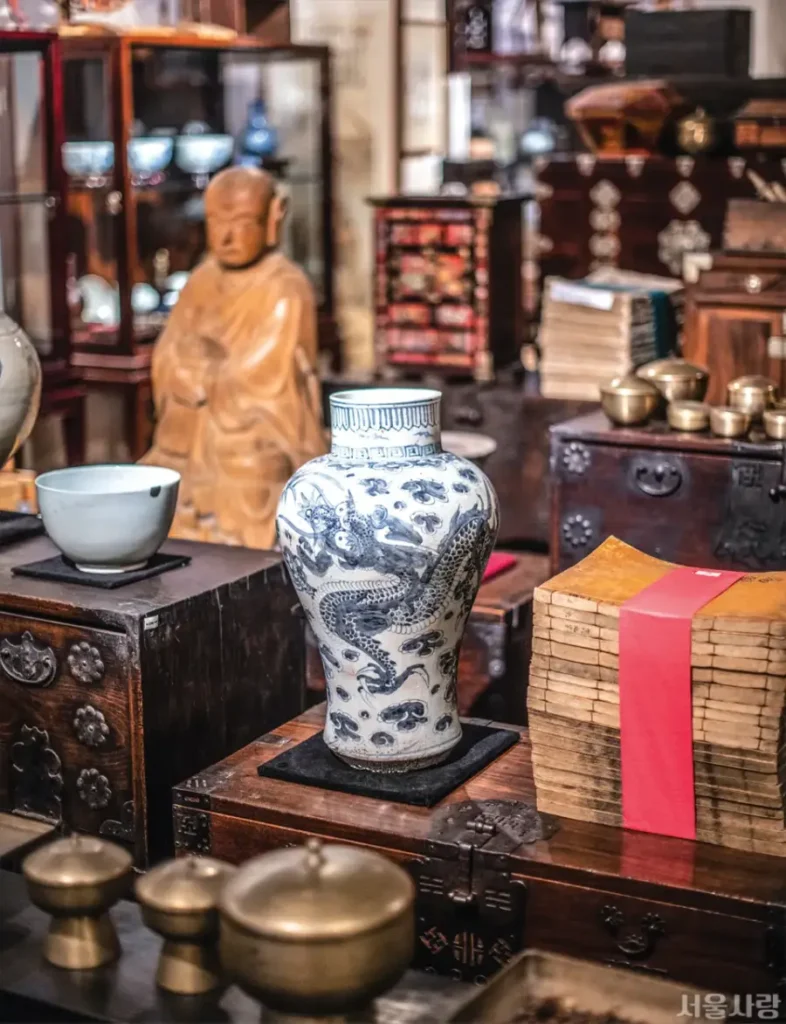
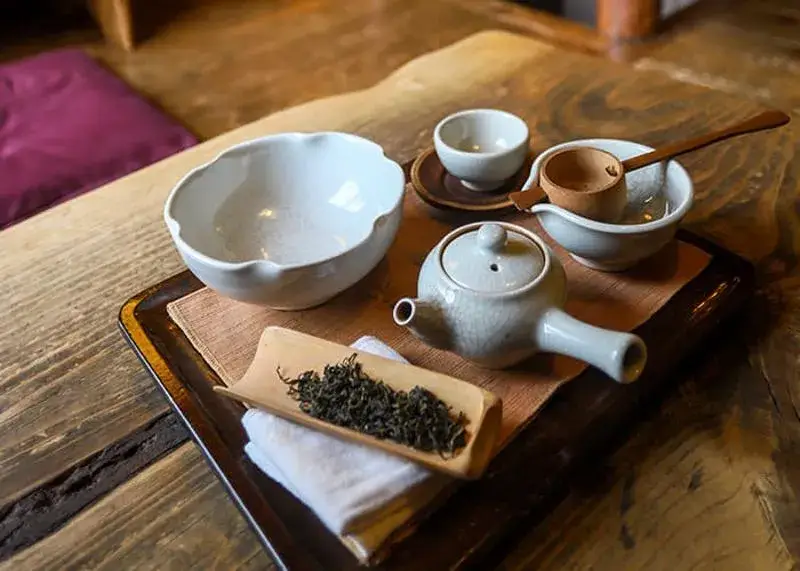
During the day, you can enjoy a festival of culture and arts where tradition and modernity harmoniously blend together with performances by energetic street artists. As evening falls, the streets take on a subtle charm under classic lanterns. Insadong reveals different charms with each season and time of day, making it a place too rich in appeal to fully experience in just one visit.



Come early on weekend mornings especially, and take a leisurely walk through the alleys. A special day awaits you – watching the streets quietly come to life while sitting in a traditional tea house with a cup of tea, then visiting workshops and galleries as they carefully open their doors one by one. Don’t worry if you get lost – Insadong’s true charm lies in discovering hidden treasure-like spaces in unexpected alleys.

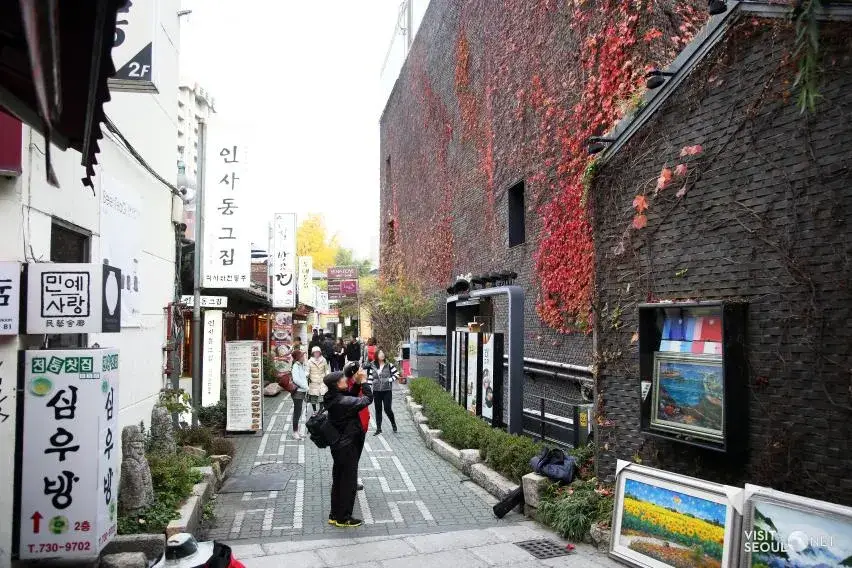
Insadong isn’t just a place to pass through, but a special space to be savored with slow steps. How about creating your own special memories here? It’s sure to become one of the most memorable moments of your Korean journey.
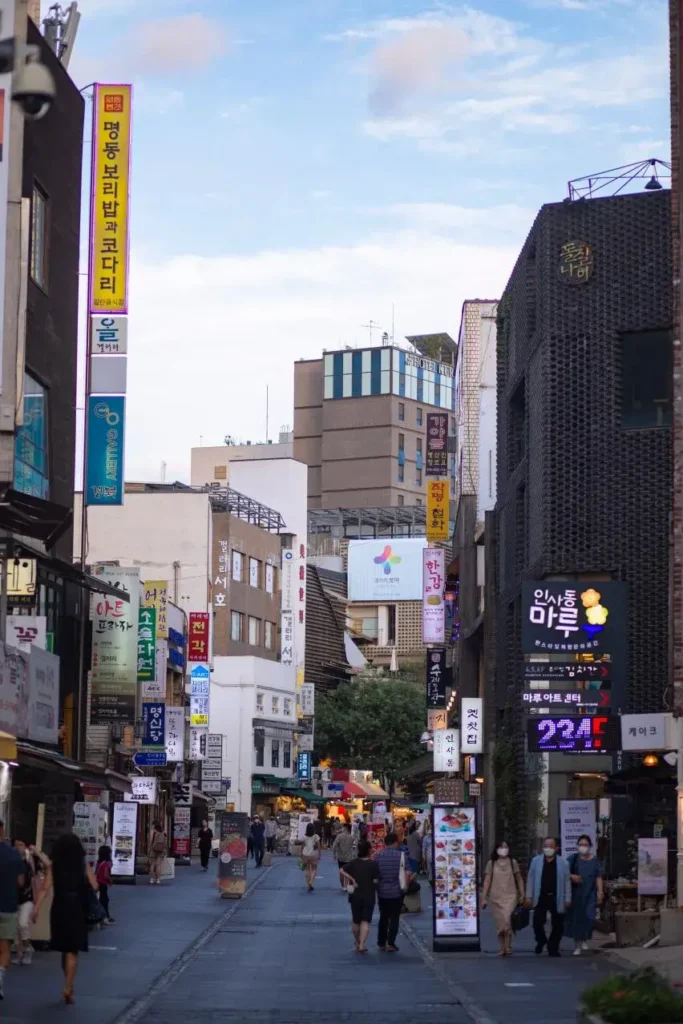
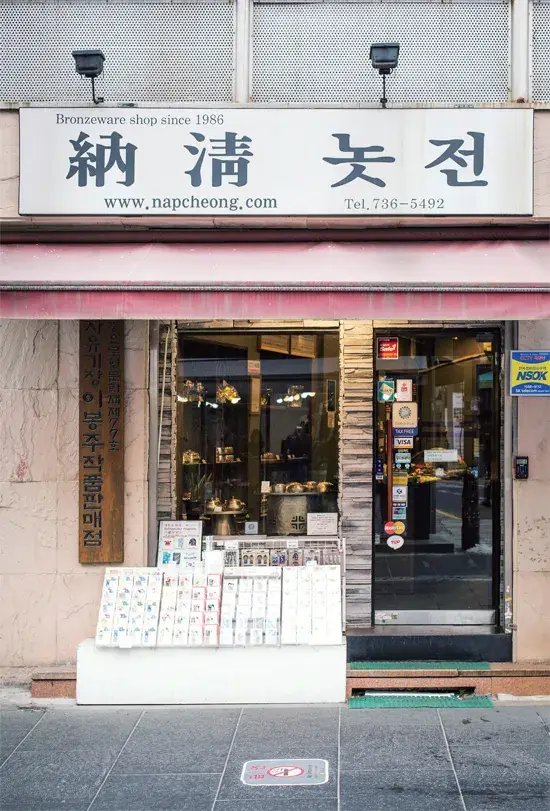
Frequently Asked Questions
4. Review
What Travelers Are Saying
5. Near by
Top Spots to Explore
Near Insadong
- Gyeongbokgung Palace
- Bukchon Hanok Village
- Changdeokgung Palace
- Unhyeongung Palace
- Jogyesa Temple
Gyeongbokgung Palace
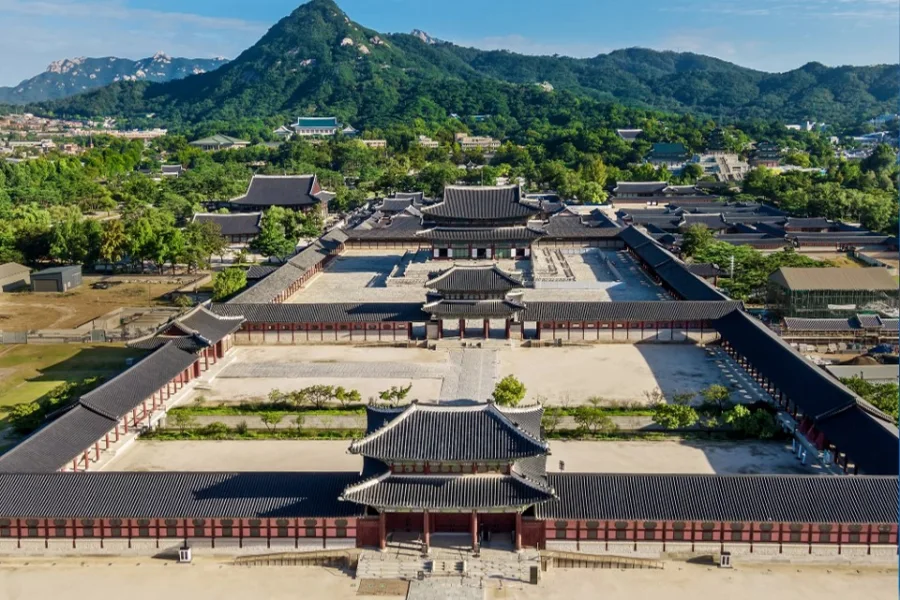
Just a 10-minute walk from Insadong, Gyeongbokgung Palace is the main royal palace of the Joseon Dynasty and a representative Korean cultural heritage site. With its grand scale and beautiful architecture, there’s so much to see that even a full day isn’t enough. Geunjeongjeon Hall and Gyeonghoeru Pavilion are must-visit spots. The Royal Guard Changing Ceremony, held every hour on the hour, is also a popular attraction.
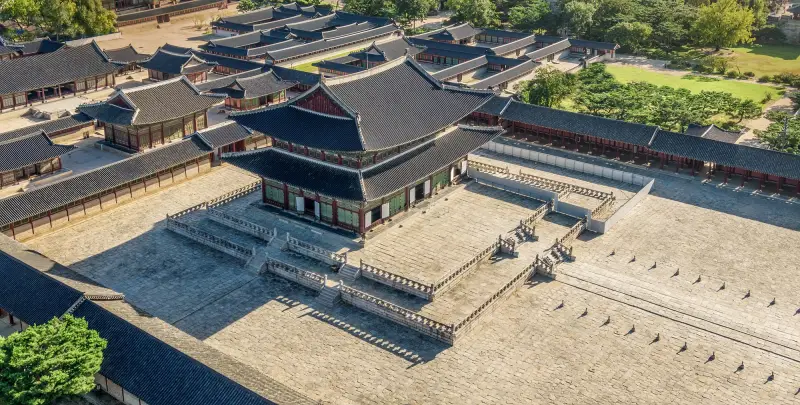
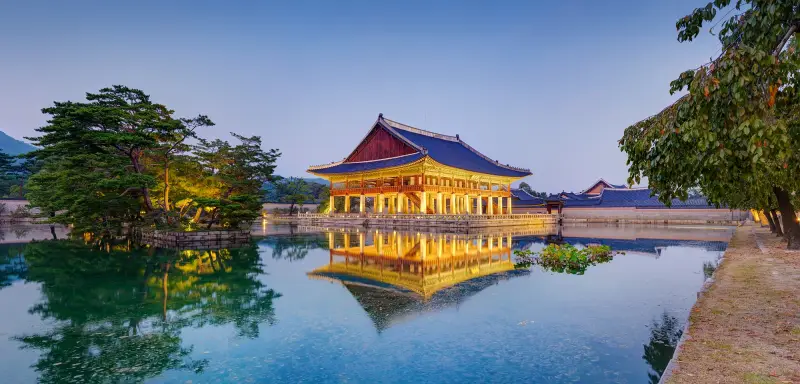
Geunjeongjeon, where the king held court with his officials, allows you to experience the dignity and elegance of the Joseon Dynasty. Gyeonghoeru, a beautiful pavilion built over a pond, is particularly magical at sunset. The palace grounds also house the National Palace Museum and National Folk Museum, where you can deepen your understanding of Korean history and culture.
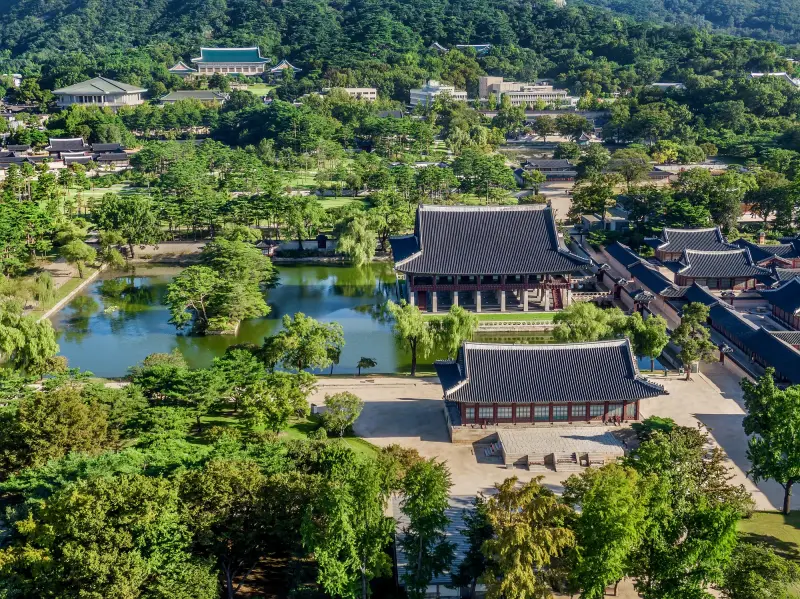
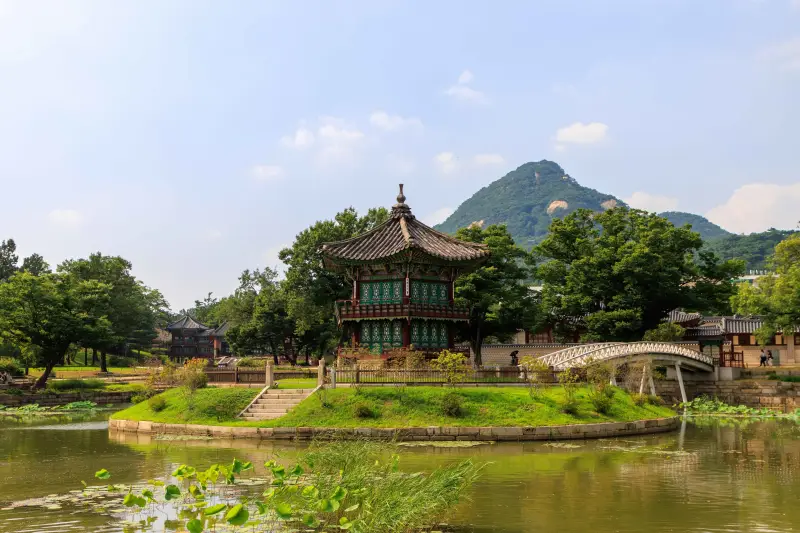
How to get there: Walk straight toward Anguk-dong from the northern end of Insadong-gil. If taking the subway, it’s a 3-minute walk from Exit 5 of Gyeongbokgung Station (Line 3). From Insadong, it’s a leisurely 10-minute walk.
Bukchon Hanok Village
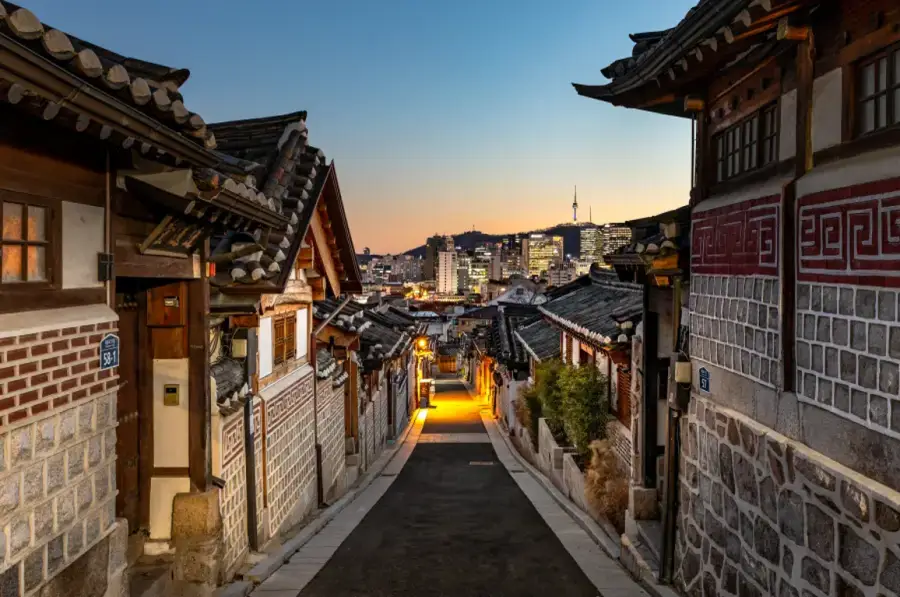
Located 15 minutes’ walk north of Insadong, Bukchon Hanok Village is a beautiful neighborhood with around 600 traditional Korean houses. Traditional hanok houses line the narrow alleys alongside charming cafes and workshops, creating a unique atmosphere. The views of downtown Seoul from Gahoe-dong Alleys 31 and 8 offer a stunning blend of tradition and modernity.

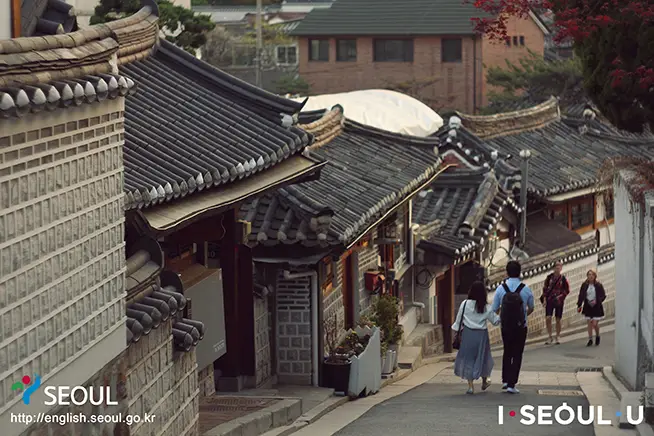
You can stay overnight in a hanok guesthouse and experience traditional crafts or try on hanbok. The Bukchon Cultural Center offers various traditional cultural programs. There’s also a “Living in a Hanok” exhibition where you can see the interior of a traditional house. On weekends, street artists often perform, adding to the special experience.
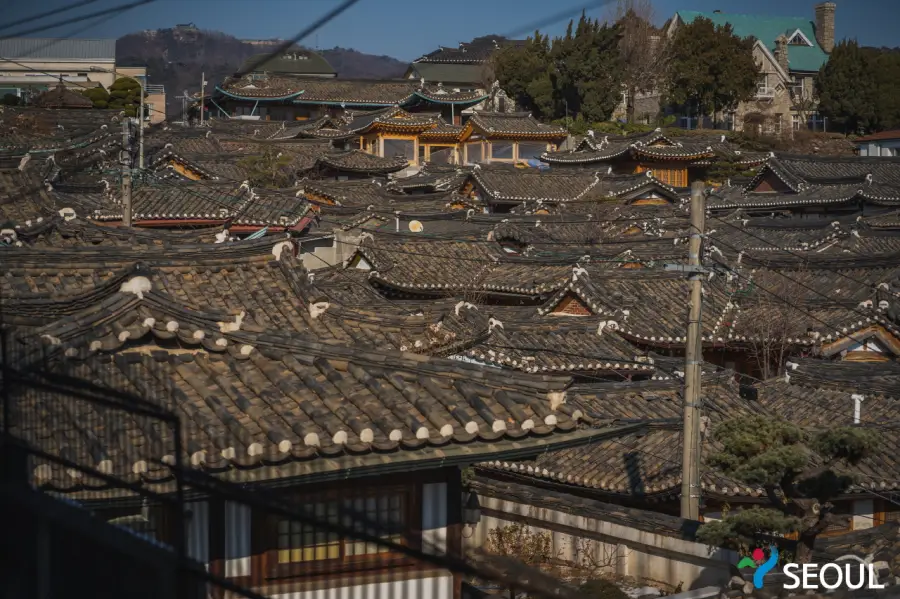
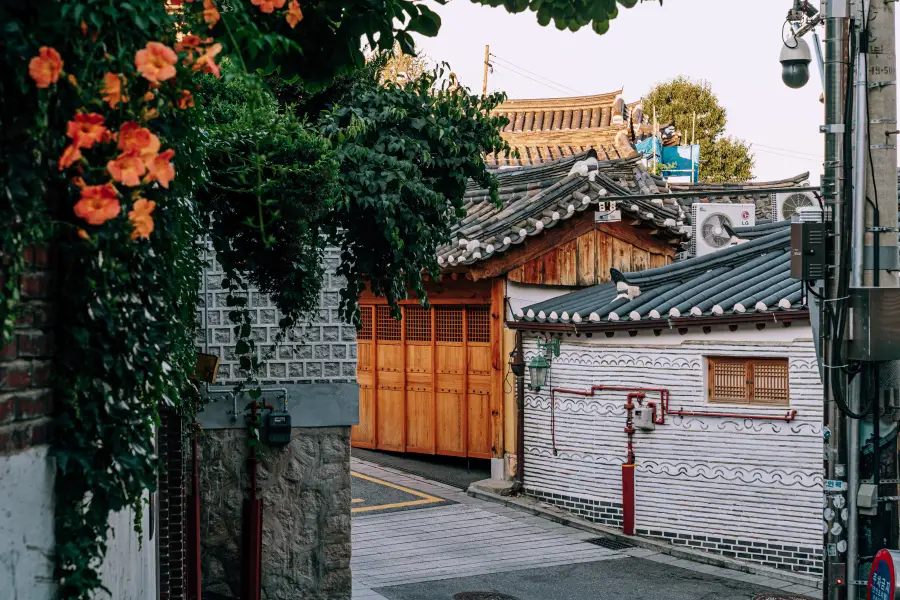
How to get there: Walk toward Anguk Station and you’ll find the Bukchon Hanok Village Information Center. Get a map from the center to explore your preferred route. It’s about a 15-minute walk, with some uphill sections, so wear comfortable shoes.
Changdeokgung Palace and Secret Garden
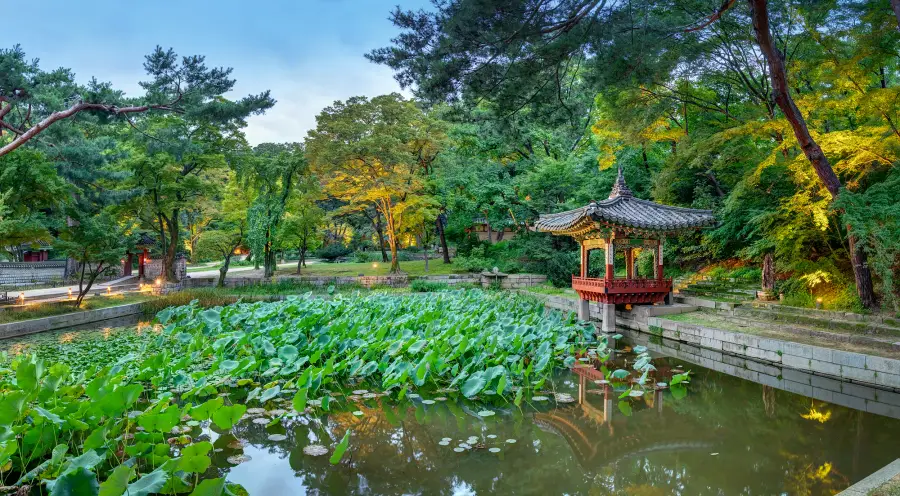
A 12-minute walk from Insadong, Changdeokgung Palace is a UNESCO World Heritage site. Its Secret Garden (Biwon) is a prime example of traditional Korean garden aesthetics, where nature and architecture exist in perfect harmony. Starting with Donhwamun Gate, considered the most beautiful of all palace gates, the entire palace showcases excellent architectural harmony with nature.
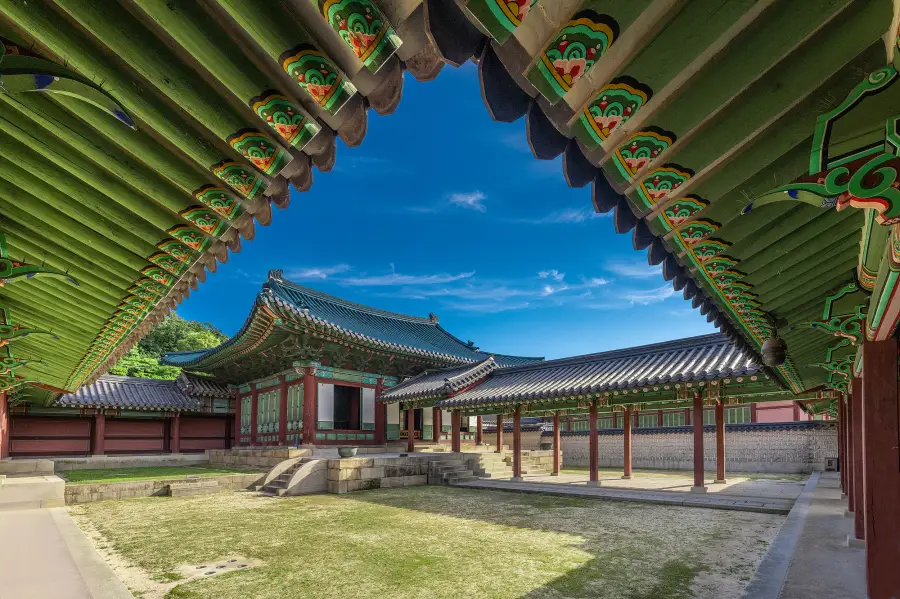
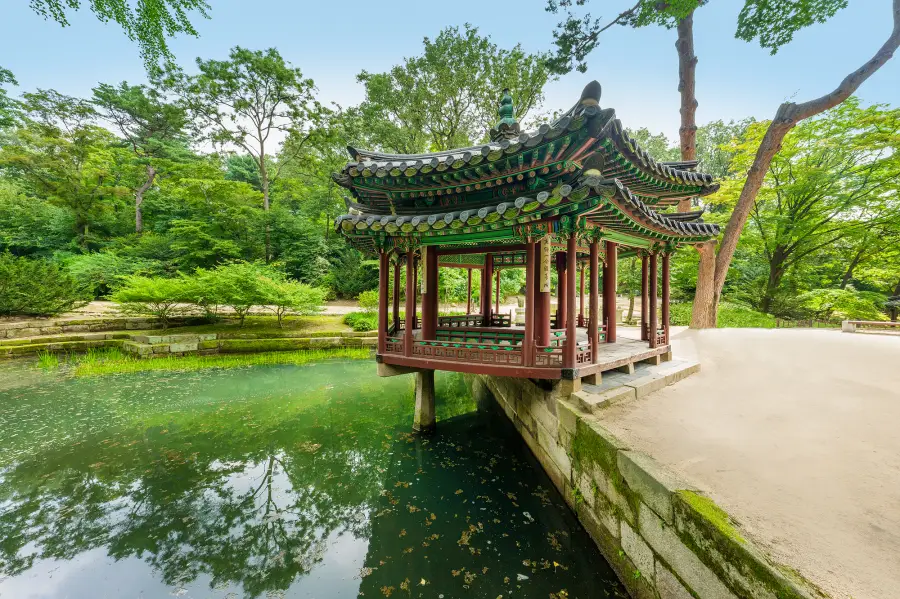
The palace is especially beautiful in spring with cherry blossoms and in autumn with fall foliage. In the Secret Garden, you can experience different charms each season, from lotus flowers at Buyongji Pond to the ancient ginkgo tree at Eosumun Gate. Unlike other palaces, Changdeokgung was built preserving the natural topography, creating hidden beauty in every corner. Remember to book in advance for the Secret Garden tour.

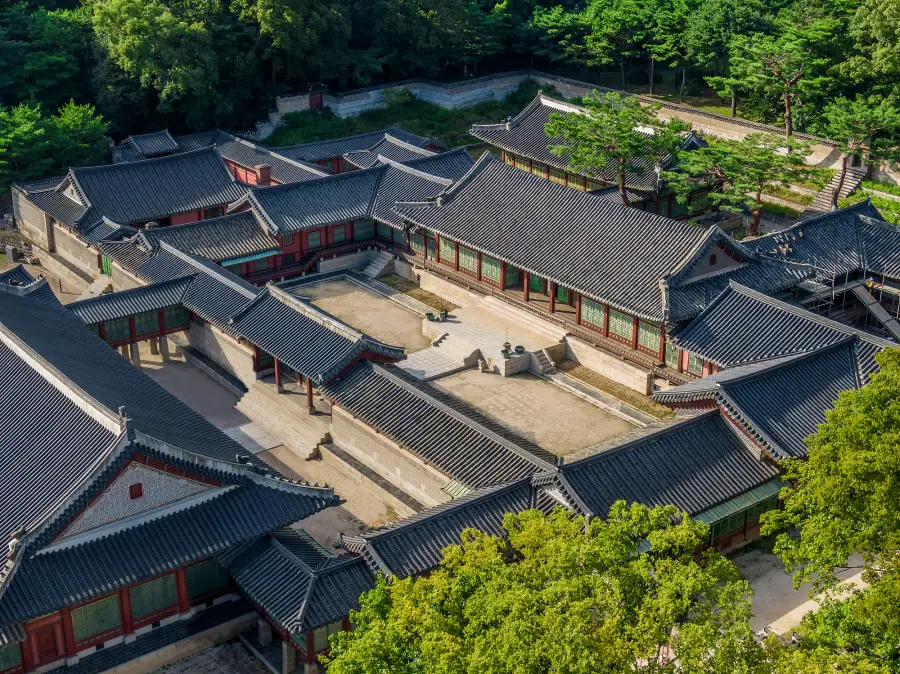
How to get there: Walk toward Anguk Station and turn slightly right. It’s a 5-minute walk from Exit 3 of Anguk Station (Line 3). Well-marked signs make it easy to find. Note that English guided tours of the Secret Garden have specific times, so check the schedule in advance.
Unhyeongung Palace
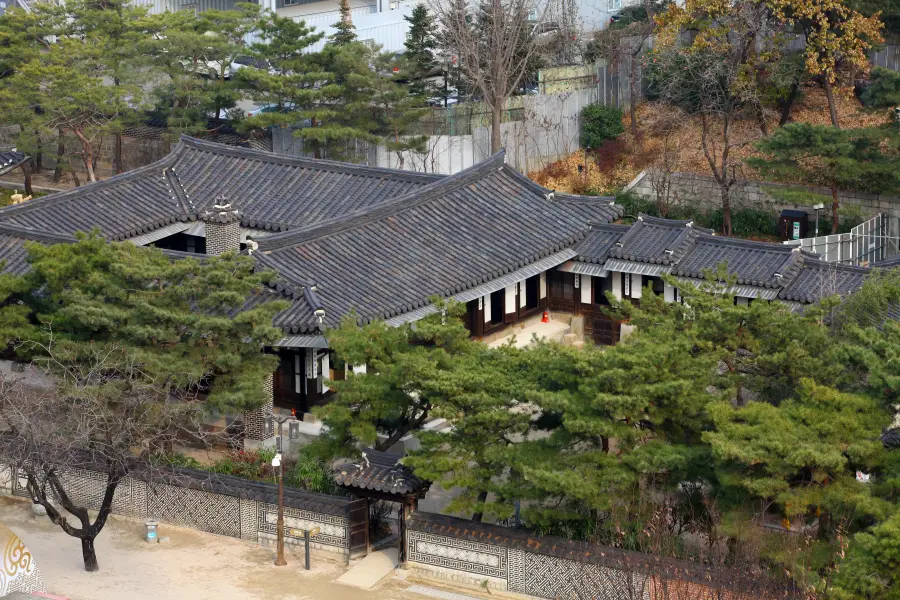


A 7-minute walk from Insadong, Unhyeongung Palace was the private residence of Heungseon Daewongun during the late Joseon period. Different from the grandeur of royal palaces, it exudes the elegance befitting the private residence of Joseon’s most powerful figure.
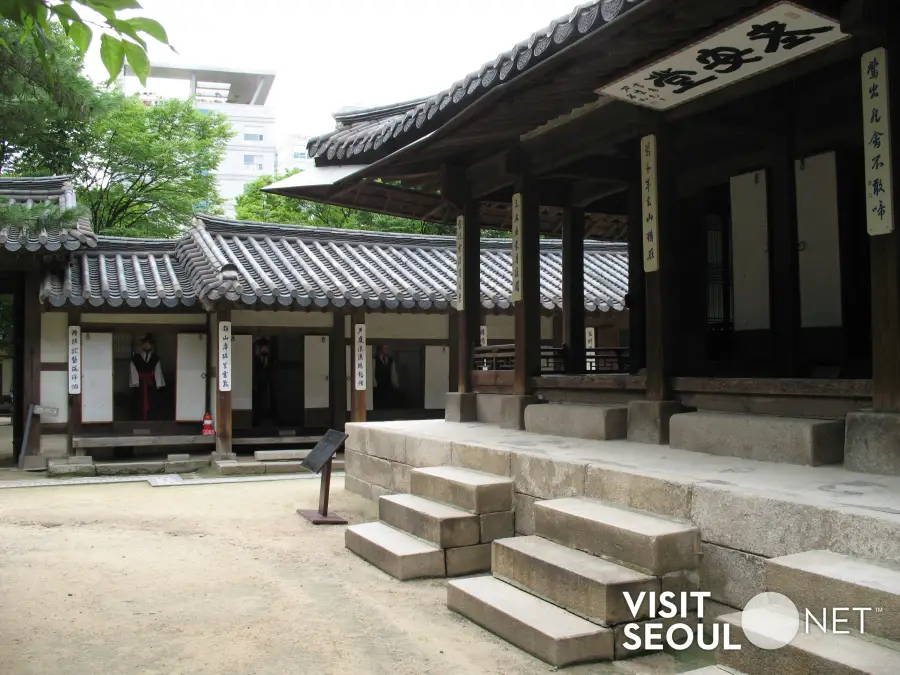

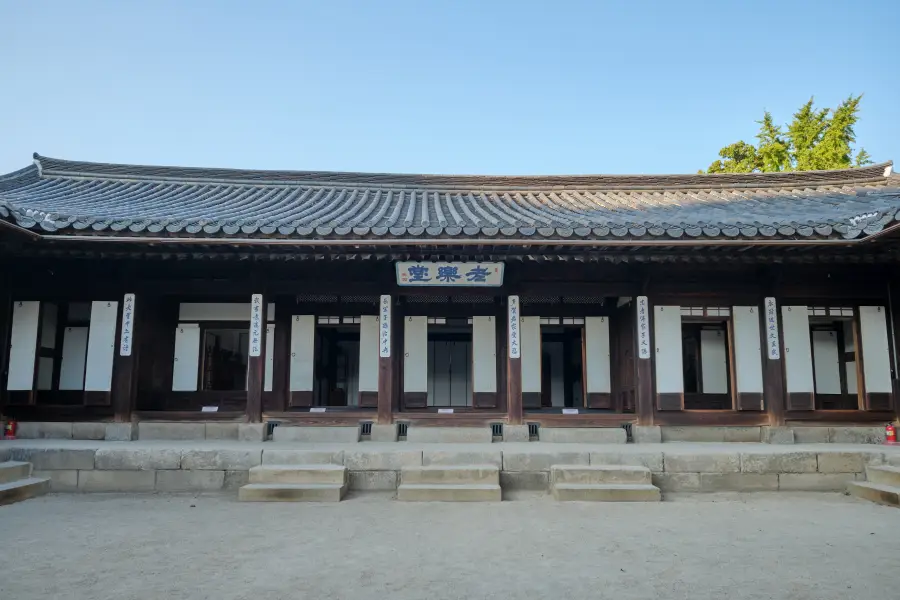
Norakdang and Noandang halls showcase the finest traditional architecture of the time. The palace preserves major historical events from the late Joseon period, from meetings between Daewongun and his son King Gojong to incidents involving Queen Myeongseong.


Every Saturday, they offer the “Become a Yangban” program where you can borrow hanbok for free and experience traditional etiquette. On the last Saturday of each month, they hold the “Unhyeongung as It Was” event, recreating historical scenes with Daewongun.
How to get there: Follow the signs to Unhyeongung while walking toward Anguk Station. It’s a 3-minute walk from Exit 4 of Anguk Station (Line 3). Admission is free.
Jogyesa Temple

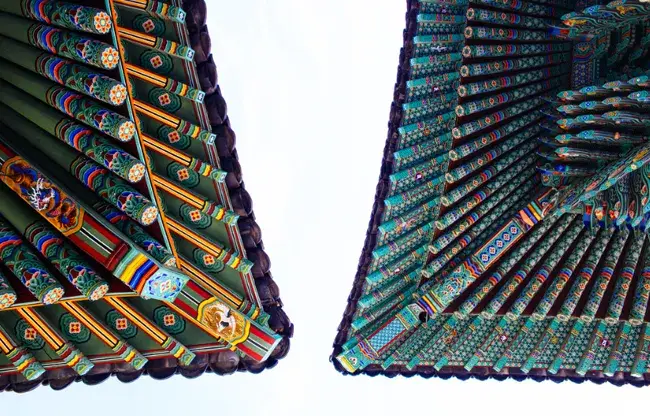
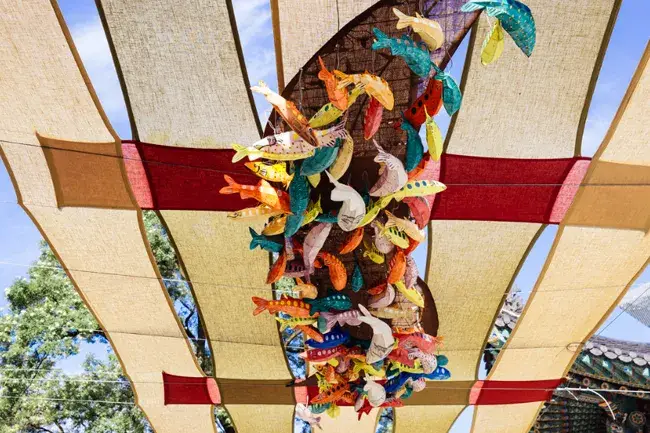
Located 5 minutes’ walk from central Insadong, Jogyesa is the head temple of the Jogye Order of Korean Buddhism. Though situated in a busy downtown area, it offers a serene atmosphere that calms the mind as soon as you enter. With its grand main hall and modern Buddhist Central Museum, you can experience both past and present Korean Buddhist culture.
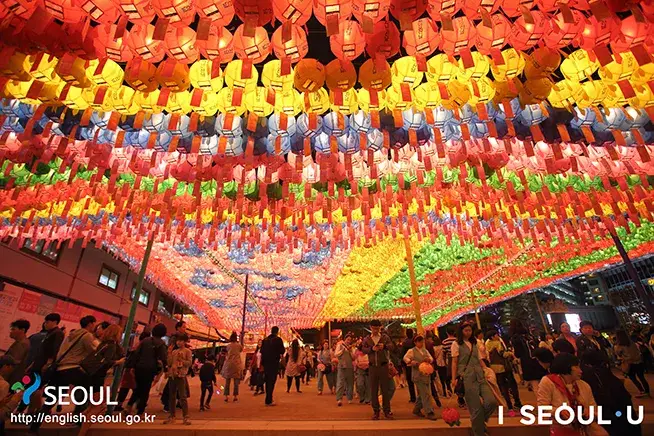

The temple offers different charms each season, with cherry blossoms at their peak in spring and colorful lanterns illuminating the entire temple during the Lantern Festival. The temple stay center offers day programs for foreigners. You can experience Korean Buddhist culture through meditation, tea ceremonies, and 108 bows.

How to get there: Follow the westward alley while walking along Insadong-gil. It’s a 5-minute walk from Exit 2 of Jonggak Station (Line 1) or a 7-minute walk from Exit 6 of Anguk Station (Line 3). Temple entry is free, but temple stay programs require advance reservation.


